Islamic manuscript 12th century Stock Photos and Images
(87)See islamic manuscript 12th century stock video clipsQuick filters:
Islamic manuscript 12th century Stock Photos and Images
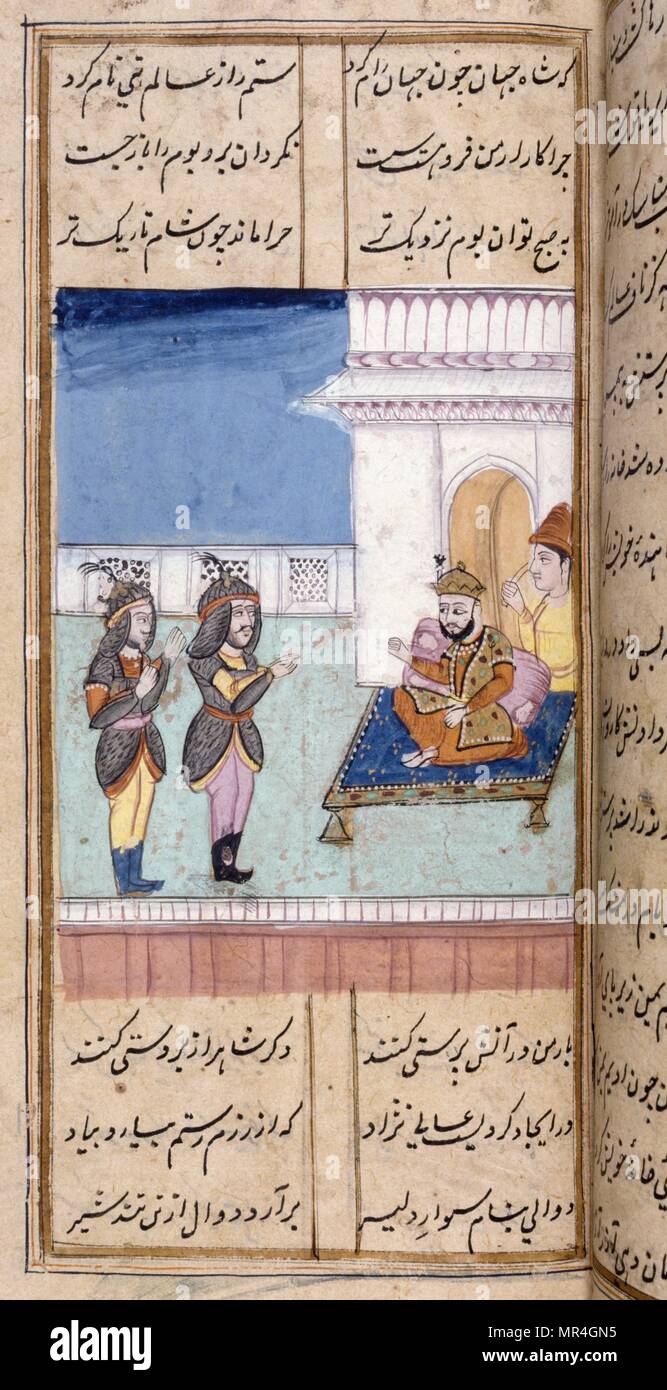 Persian (Iranian) Islamic style, manuscript, Illustrated 12th century: The poet Nezami recounts the tales of Alexander the great Stock Photohttps://www.alamy.com/image-license-details/?v=1https://www.alamy.com/persian-iranian-islamic-style-manuscript-illustrated-12th-century-the-poet-nezami-recounts-the-tales-of-alexander-the-great-image186341713.html
Persian (Iranian) Islamic style, manuscript, Illustrated 12th century: The poet Nezami recounts the tales of Alexander the great Stock Photohttps://www.alamy.com/image-license-details/?v=1https://www.alamy.com/persian-iranian-islamic-style-manuscript-illustrated-12th-century-the-poet-nezami-recounts-the-tales-of-alexander-the-great-image186341713.htmlRMMR4GN5–Persian (Iranian) Islamic style, manuscript, Illustrated 12th century: The poet Nezami recounts the tales of Alexander the great
 Shudhur al-dhahab, Islamic Alchemy Manuscript, 12th Century Stock Photohttps://www.alamy.com/image-license-details/?v=1https://www.alamy.com/stock-photo-shudhur-al-dhahab-islamic-alchemy-manuscript-12th-century-135089328.html
Shudhur al-dhahab, Islamic Alchemy Manuscript, 12th Century Stock Photohttps://www.alamy.com/image-license-details/?v=1https://www.alamy.com/stock-photo-shudhur-al-dhahab-islamic-alchemy-manuscript-12th-century-135089328.htmlRMHRNRPT–Shudhur al-dhahab, Islamic Alchemy Manuscript, 12th Century
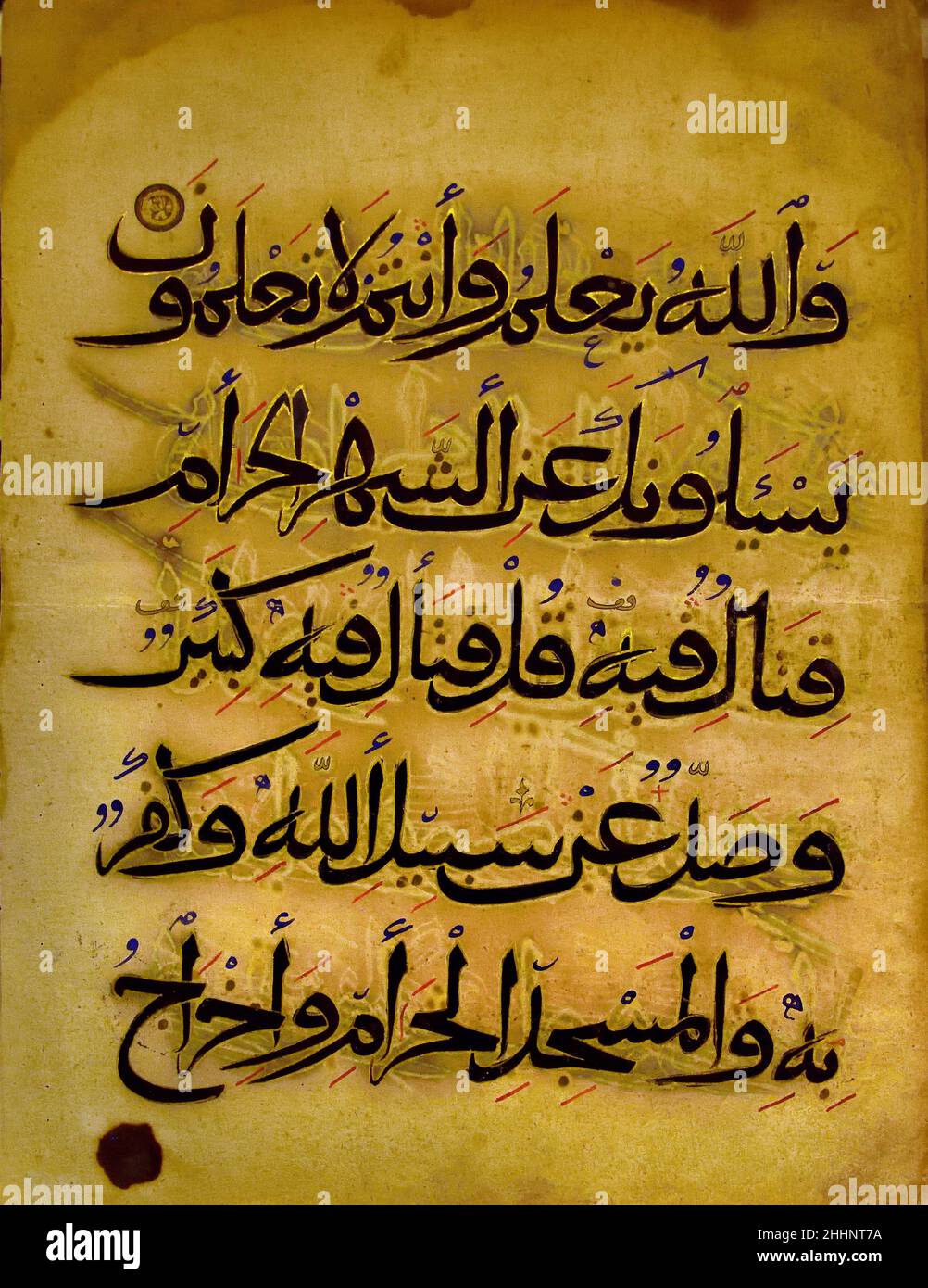 Folio from Quran, Qu'ran Manuscript in muhaqqaq script - Iraq or western Iran 12th century Mao Museum ( Museo d'Arte Orientale Torino ) - Museum of Oriental art - Dish ' Kubachi ' Iran 16th century A.C. ( Museo d'Arte Orientale Torino ) Stock Photohttps://www.alamy.com/image-license-details/?v=1https://www.alamy.com/folio-from-quran-quran-manuscript-in-muhaqqaq-script-iraq-or-western-iran-12th-century-mao-museum-museo-darte-orientale-torino-museum-of-oriental-art-dish-kubachi-iran-16th-century-ac-museo-darte-orientale-torino-image458398734.html
Folio from Quran, Qu'ran Manuscript in muhaqqaq script - Iraq or western Iran 12th century Mao Museum ( Museo d'Arte Orientale Torino ) - Museum of Oriental art - Dish ' Kubachi ' Iran 16th century A.C. ( Museo d'Arte Orientale Torino ) Stock Photohttps://www.alamy.com/image-license-details/?v=1https://www.alamy.com/folio-from-quran-quran-manuscript-in-muhaqqaq-script-iraq-or-western-iran-12th-century-mao-museum-museo-darte-orientale-torino-museum-of-oriental-art-dish-kubachi-iran-16th-century-ac-museo-darte-orientale-torino-image458398734.htmlRM2HHNT7A–Folio from Quran, Qu'ran Manuscript in muhaqqaq script - Iraq or western Iran 12th century Mao Museum ( Museo d'Arte Orientale Torino ) - Museum of Oriental art - Dish ' Kubachi ' Iran 16th century A.C. ( Museo d'Arte Orientale Torino )
 Islamic manuscript Khawaso al Ashjan dating from 12th century Mashad Iran Middle East Stock Photohttps://www.alamy.com/image-license-details/?v=1https://www.alamy.com/stock-photo-islamic-manuscript-khawaso-al-ashjan-dating-from-12th-century-mashad-20510914.html
Islamic manuscript Khawaso al Ashjan dating from 12th century Mashad Iran Middle East Stock Photohttps://www.alamy.com/image-license-details/?v=1https://www.alamy.com/stock-photo-islamic-manuscript-khawaso-al-ashjan-dating-from-12th-century-mashad-20510914.htmlRMB5A9TJ–Islamic manuscript Khawaso al Ashjan dating from 12th century Mashad Iran Middle East
 Art inspired by Folio from a Qur'an Manuscript, late 11th–12th century, Made in Eastern Islamic lands, Ink, opaque watercolor, and gold on paper, H.10 in. (25.4 cm), Codices, This folio from a Qur’an is written on paper in black new style script, with vocalizations in red, diacritical, Classic works modernized by Artotop with a splash of modernity. Shapes, color and value, eye-catching visual impact on art. Emotions through freedom of artworks in a contemporary way. A timeless message pursuing a wildly creative new direction. Artists turning to the digital medium and creating the Artotop NFT Stock Photohttps://www.alamy.com/image-license-details/?v=1https://www.alamy.com/art-inspired-by-folio-from-a-quran-manuscript-late-11th12th-century-made-in-eastern-islamic-lands-ink-opaque-watercolor-and-gold-on-paper-h10-in-254-cm-codices-this-folio-from-a-quran-is-written-on-paper-in-black-new-style-script-with-vocalizations-in-red-diacritical-classic-works-modernized-by-artotop-with-a-splash-of-modernity-shapes-color-and-value-eye-catching-visual-impact-on-art-emotions-through-freedom-of-artworks-in-a-contemporary-way-a-timeless-message-pursuing-a-wildly-creative-new-direction-artists-turning-to-the-digital-medium-and-creating-the-artotop-nft-image463027252.html
Art inspired by Folio from a Qur'an Manuscript, late 11th–12th century, Made in Eastern Islamic lands, Ink, opaque watercolor, and gold on paper, H.10 in. (25.4 cm), Codices, This folio from a Qur’an is written on paper in black new style script, with vocalizations in red, diacritical, Classic works modernized by Artotop with a splash of modernity. Shapes, color and value, eye-catching visual impact on art. Emotions through freedom of artworks in a contemporary way. A timeless message pursuing a wildly creative new direction. Artists turning to the digital medium and creating the Artotop NFT Stock Photohttps://www.alamy.com/image-license-details/?v=1https://www.alamy.com/art-inspired-by-folio-from-a-quran-manuscript-late-11th12th-century-made-in-eastern-islamic-lands-ink-opaque-watercolor-and-gold-on-paper-h10-in-254-cm-codices-this-folio-from-a-quran-is-written-on-paper-in-black-new-style-script-with-vocalizations-in-red-diacritical-classic-works-modernized-by-artotop-with-a-splash-of-modernity-shapes-color-and-value-eye-catching-visual-impact-on-art-emotions-through-freedom-of-artworks-in-a-contemporary-way-a-timeless-message-pursuing-a-wildly-creative-new-direction-artists-turning-to-the-digital-medium-and-creating-the-artotop-nft-image463027252.htmlRF2HW8KYG–Art inspired by Folio from a Qur'an Manuscript, late 11th–12th century, Made in Eastern Islamic lands, Ink, opaque watercolor, and gold on paper, H.10 in. (25.4 cm), Codices, This folio from a Qur’an is written on paper in black new style script, with vocalizations in red, diacritical, Classic works modernized by Artotop with a splash of modernity. Shapes, color and value, eye-catching visual impact on art. Emotions through freedom of artworks in a contemporary way. A timeless message pursuing a wildly creative new direction. Artists turning to the digital medium and creating the Artotop NFT
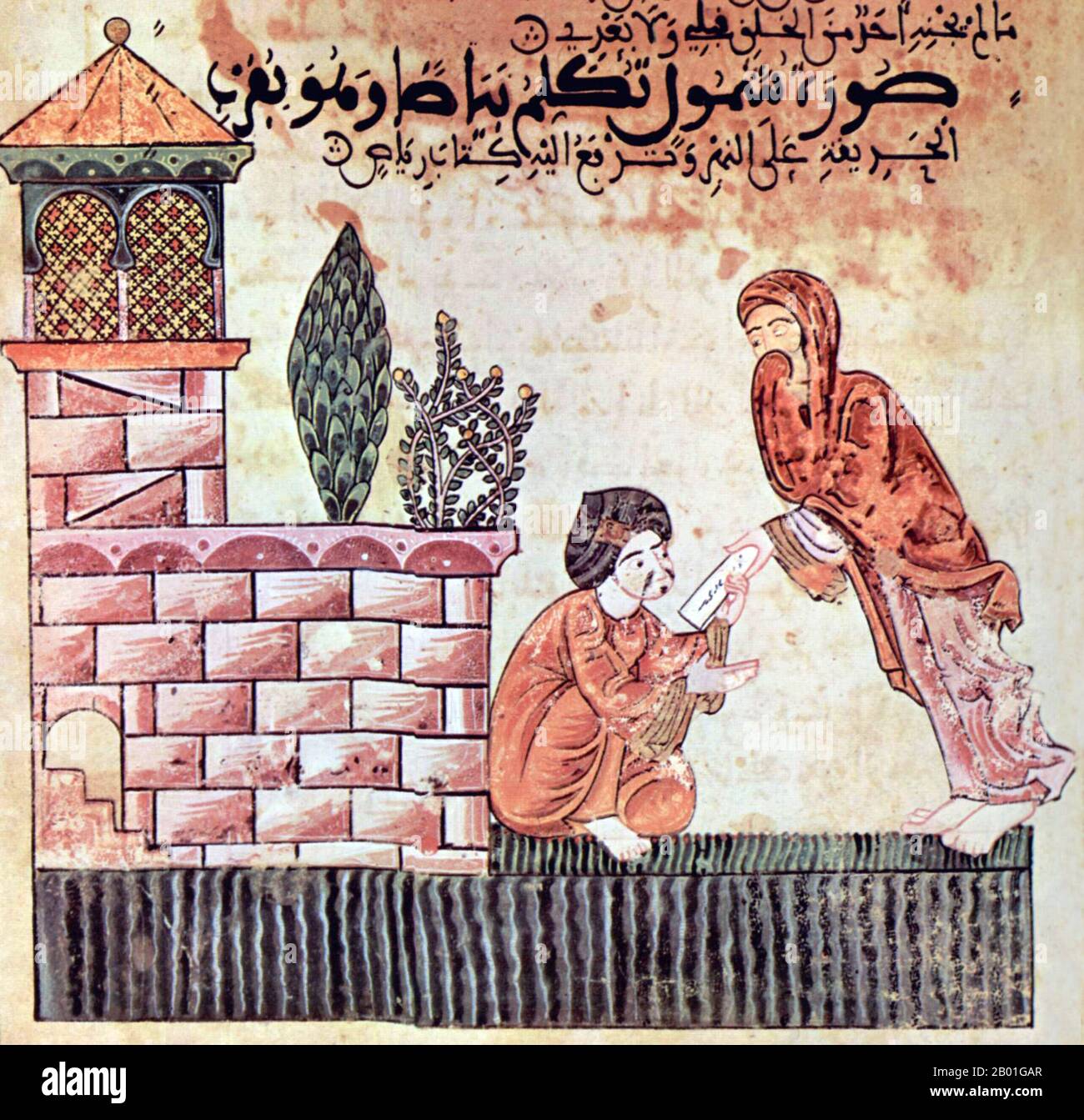 Spain: An illustration from the Tale of Bayad and Riyad, Al-Andalus (Islamic Andalucia), late 12th century. Hadith Bayāḍ wa Riyāḍ (The Story of Bayad and Riyad) or Qissat Bayad wa Riyad is a 13th-century Arabic love story. The main characters of the tale are Bayad, a merchant's son and a foreigner from Damascus, and Riyad, a well educated girl in the court of an unnamed Hajib (vizier/minister) of Iraq and a 'Lady' (al-sayyida). The Hadith Bayad wa Riyad is believed to be the only illustrated manuscript known to have survived from more than eight centuries of Muslim presence in Spain. Stock Photohttps://www.alamy.com/image-license-details/?v=1https://www.alamy.com/spain-an-illustration-from-the-tale-of-bayad-and-riyad-al-andalus-islamic-andalucia-late-12th-century-hadith-bay-wa-riy-the-story-of-bayad-and-riyad-or-qissat-bayad-wa-riyad-is-a-13th-century-arabic-love-story-the-main-characters-of-the-tale-are-bayad-a-merchants-son-and-a-foreigner-from-damascus-and-riyad-a-well-educated-girl-in-the-court-of-an-unnamed-hajib-vizierminister-of-iraq-and-a-lady-al-sayyida-the-hadith-bayad-wa-riyad-is-believed-to-be-the-only-illustrated-manuscript-known-to-have-survived-from-more-than-eight-centuries-of-muslim-presence-in-spain-image344242159.html
Spain: An illustration from the Tale of Bayad and Riyad, Al-Andalus (Islamic Andalucia), late 12th century. Hadith Bayāḍ wa Riyāḍ (The Story of Bayad and Riyad) or Qissat Bayad wa Riyad is a 13th-century Arabic love story. The main characters of the tale are Bayad, a merchant's son and a foreigner from Damascus, and Riyad, a well educated girl in the court of an unnamed Hajib (vizier/minister) of Iraq and a 'Lady' (al-sayyida). The Hadith Bayad wa Riyad is believed to be the only illustrated manuscript known to have survived from more than eight centuries of Muslim presence in Spain. Stock Photohttps://www.alamy.com/image-license-details/?v=1https://www.alamy.com/spain-an-illustration-from-the-tale-of-bayad-and-riyad-al-andalus-islamic-andalucia-late-12th-century-hadith-bay-wa-riy-the-story-of-bayad-and-riyad-or-qissat-bayad-wa-riyad-is-a-13th-century-arabic-love-story-the-main-characters-of-the-tale-are-bayad-a-merchants-son-and-a-foreigner-from-damascus-and-riyad-a-well-educated-girl-in-the-court-of-an-unnamed-hajib-vizierminister-of-iraq-and-a-lady-al-sayyida-the-hadith-bayad-wa-riyad-is-believed-to-be-the-only-illustrated-manuscript-known-to-have-survived-from-more-than-eight-centuries-of-muslim-presence-in-spain-image344242159.htmlRM2B01GAR–Spain: An illustration from the Tale of Bayad and Riyad, Al-Andalus (Islamic Andalucia), late 12th century. Hadith Bayāḍ wa Riyāḍ (The Story of Bayad and Riyad) or Qissat Bayad wa Riyad is a 13th-century Arabic love story. The main characters of the tale are Bayad, a merchant's son and a foreigner from Damascus, and Riyad, a well educated girl in the court of an unnamed Hajib (vizier/minister) of Iraq and a 'Lady' (al-sayyida). The Hadith Bayad wa Riyad is believed to be the only illustrated manuscript known to have survived from more than eight centuries of Muslim presence in Spain.
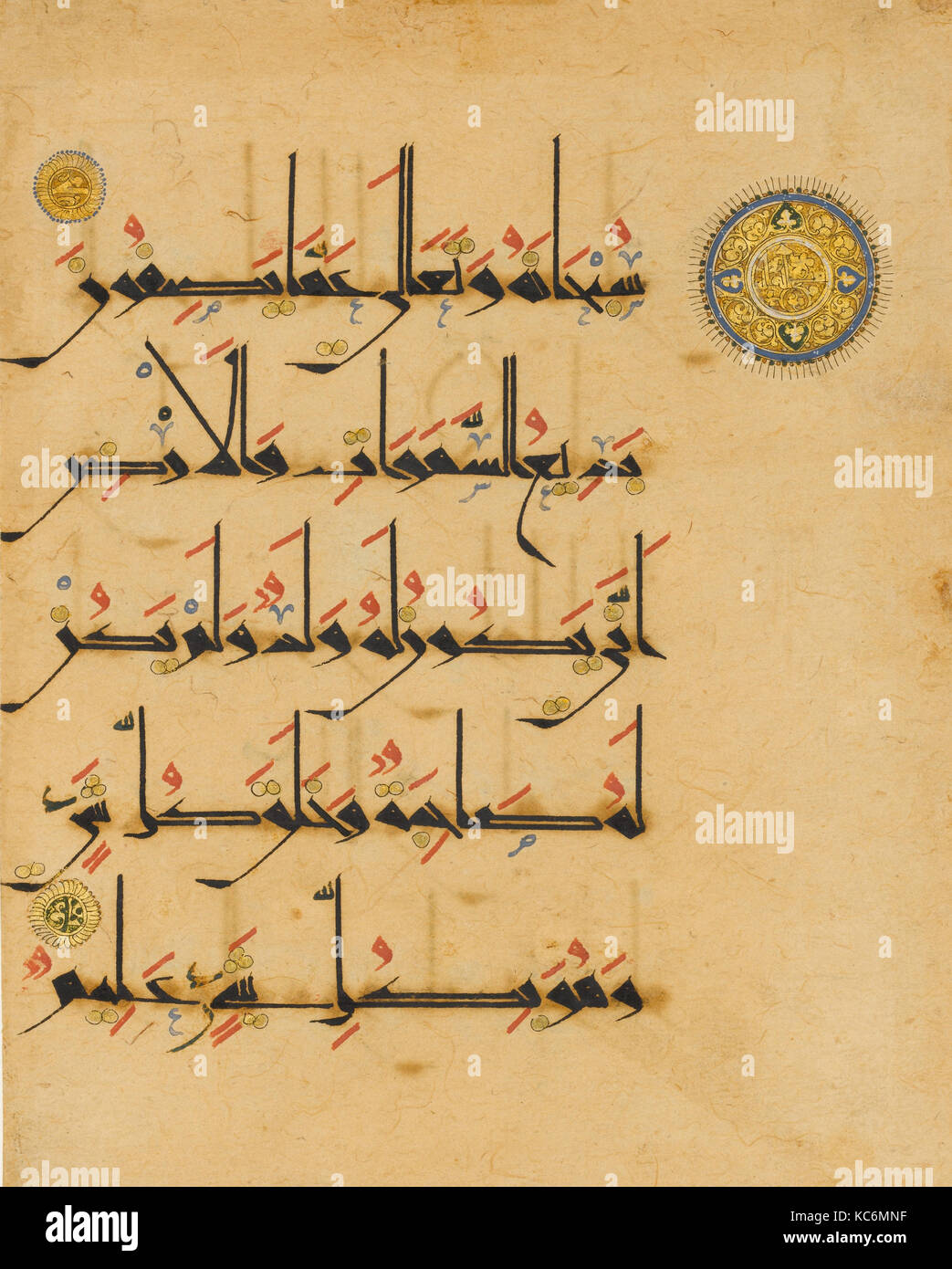 Folio from a Qur'an Manuscript, late 11th–12th century Stock Photohttps://www.alamy.com/image-license-details/?v=1https://www.alamy.com/stock-image-folio-from-a-quran-manuscript-late-11th12th-century-162417179.html
Folio from a Qur'an Manuscript, late 11th–12th century Stock Photohttps://www.alamy.com/image-license-details/?v=1https://www.alamy.com/stock-image-folio-from-a-quran-manuscript-late-11th12th-century-162417179.htmlRMKC6MNF–Folio from a Qur'an Manuscript, late 11th–12th century
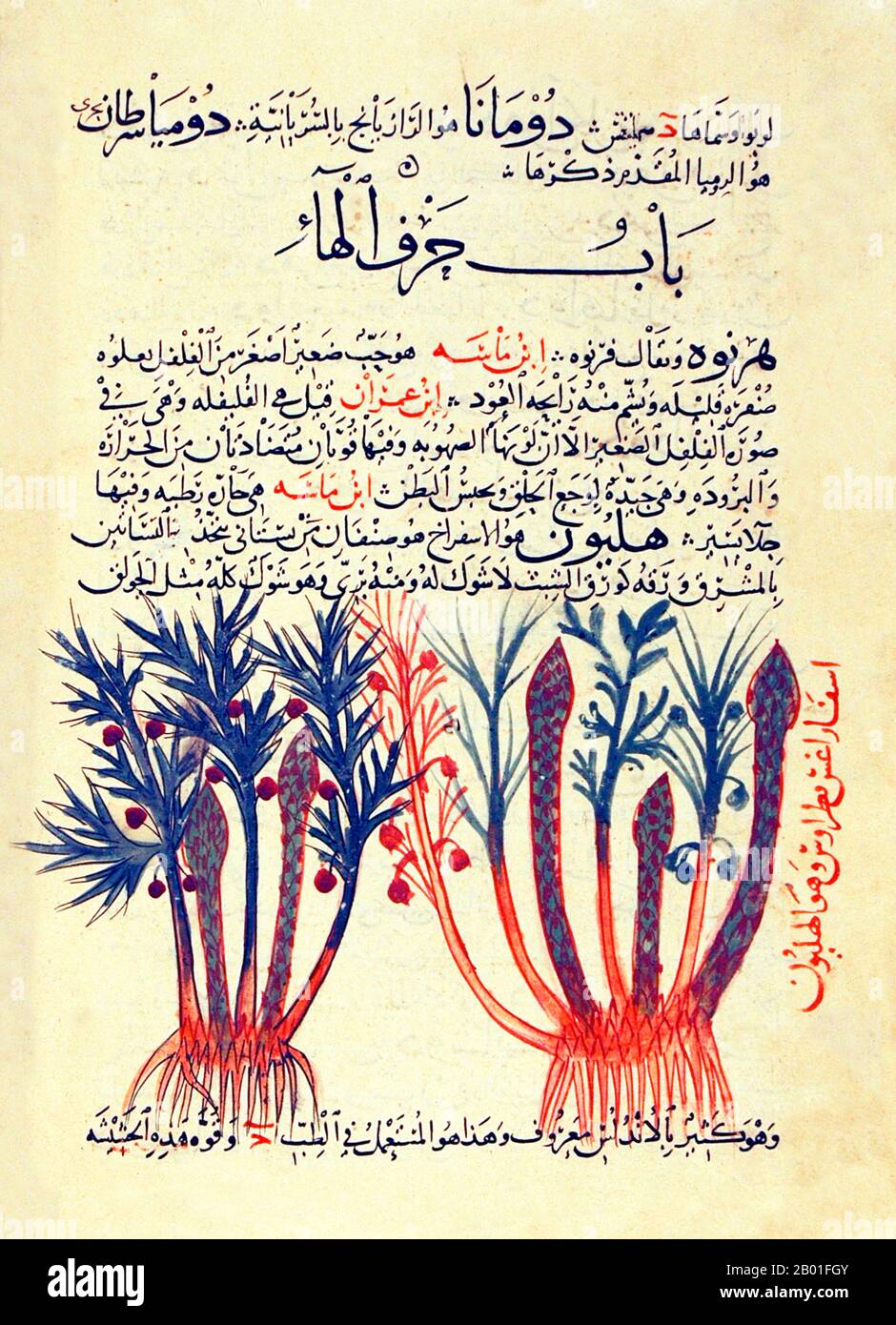 Spain/Andalusia: Two types of asparagus. Illuminated Arabic folio from Abu Ja 'far al-Ghafiqi's 'Herbal', c. 12th century. Al-Ghafiqi, according to a thirteenth-century historian of Arab medicine, was the greatest savant of medicinal plants, their names and their properties, and his work had no equal in this field. This view was later confirmed by Max Meyerhof (d. 1945), the eminent historian of Islamic medicine, who stated that al-Ghafiqi was undoubtedly the greatest botanist and pharmacologist of the Islamic period. He hailed from Ghafiq, near Cordoba on the southern Iberian peninsula. Stock Photohttps://www.alamy.com/image-license-details/?v=1https://www.alamy.com/spainandalusia-two-types-of-asparagus-illuminated-arabic-folio-from-abu-ja-far-al-ghafiqis-herbal-c-12th-century-al-ghafiqi-according-to-a-thirteenth-century-historian-of-arab-medicine-was-the-greatest-savant-of-medicinal-plants-their-names-and-their-properties-and-his-work-had-no-equal-in-this-field-this-view-was-later-confirmed-by-max-meyerhof-d-1945-the-eminent-historian-of-islamic-medicine-who-stated-that-al-ghafiqi-was-undoubtedly-the-greatest-botanist-and-pharmacologist-of-the-islamic-period-he-hailed-from-ghafiq-near-cordoba-on-the-southern-iberian-peninsula-image344241547.html
Spain/Andalusia: Two types of asparagus. Illuminated Arabic folio from Abu Ja 'far al-Ghafiqi's 'Herbal', c. 12th century. Al-Ghafiqi, according to a thirteenth-century historian of Arab medicine, was the greatest savant of medicinal plants, their names and their properties, and his work had no equal in this field. This view was later confirmed by Max Meyerhof (d. 1945), the eminent historian of Islamic medicine, who stated that al-Ghafiqi was undoubtedly the greatest botanist and pharmacologist of the Islamic period. He hailed from Ghafiq, near Cordoba on the southern Iberian peninsula. Stock Photohttps://www.alamy.com/image-license-details/?v=1https://www.alamy.com/spainandalusia-two-types-of-asparagus-illuminated-arabic-folio-from-abu-ja-far-al-ghafiqis-herbal-c-12th-century-al-ghafiqi-according-to-a-thirteenth-century-historian-of-arab-medicine-was-the-greatest-savant-of-medicinal-plants-their-names-and-their-properties-and-his-work-had-no-equal-in-this-field-this-view-was-later-confirmed-by-max-meyerhof-d-1945-the-eminent-historian-of-islamic-medicine-who-stated-that-al-ghafiqi-was-undoubtedly-the-greatest-botanist-and-pharmacologist-of-the-islamic-period-he-hailed-from-ghafiq-near-cordoba-on-the-southern-iberian-peninsula-image344241547.htmlRM2B01FGY–Spain/Andalusia: Two types of asparagus. Illuminated Arabic folio from Abu Ja 'far al-Ghafiqi's 'Herbal', c. 12th century. Al-Ghafiqi, according to a thirteenth-century historian of Arab medicine, was the greatest savant of medicinal plants, their names and their properties, and his work had no equal in this field. This view was later confirmed by Max Meyerhof (d. 1945), the eminent historian of Islamic medicine, who stated that al-Ghafiqi was undoubtedly the greatest botanist and pharmacologist of the Islamic period. He hailed from Ghafiq, near Cordoba on the southern Iberian peninsula.
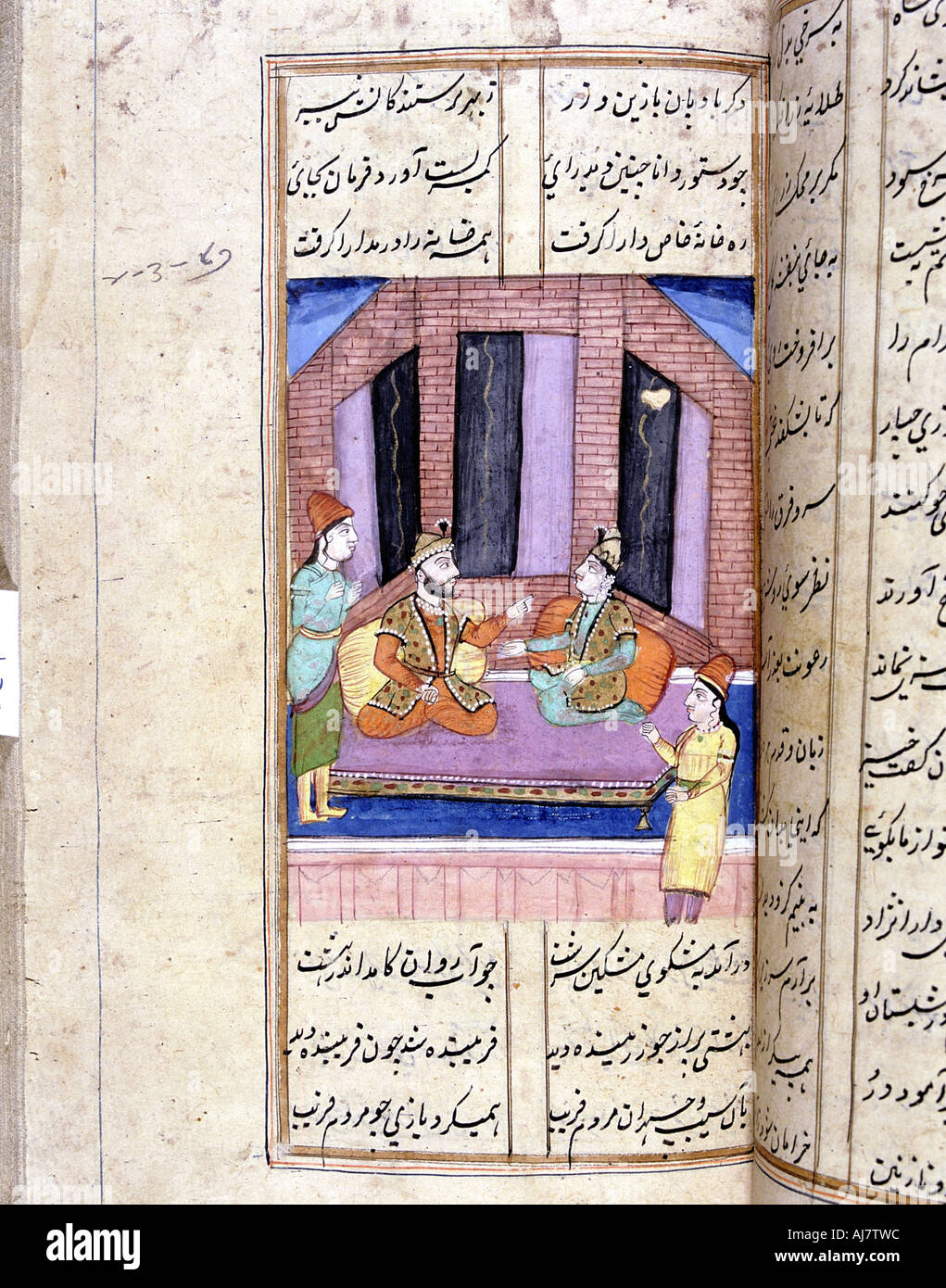 Nezami, Persian poet, recounting the story of Alexander the Great, 12th century (18th century). Artist: Unknown Stock Photohttps://www.alamy.com/image-license-details/?v=1https://www.alamy.com/nezami-persian-poet-recounting-the-story-of-alexander-the-great-12th-image8371611.html
Nezami, Persian poet, recounting the story of Alexander the Great, 12th century (18th century). Artist: Unknown Stock Photohttps://www.alamy.com/image-license-details/?v=1https://www.alamy.com/nezami-persian-poet-recounting-the-story-of-alexander-the-great-12th-image8371611.htmlRMAJ7TWC–Nezami, Persian poet, recounting the story of Alexander the Great, 12th century (18th century). Artist: Unknown
 Illuminated Headpiece with Arabesque Design and Marginal Medallion at Left. English: This folio from Walters manuscript W.555 contains a headpiece illuminated in gold and decorated with an arabesque design. There is a marginal rosette at the left. . 5th century AH/AD 11th century-6th century AH/AD 12th century (Abbasid period (750-1258)). 676 Islamic - Illuminated Headpiece with Arabesque Design and Marginal Medallion at Left - Walters W5551A - Full Page Stock Photohttps://www.alamy.com/image-license-details/?v=1https://www.alamy.com/illuminated-headpiece-with-arabesque-design-and-marginal-medallion-at-left-english-this-folio-from-walters-manuscript-w555-contains-a-headpiece-illuminated-in-gold-and-decorated-with-an-arabesque-design-there-is-a-marginal-rosette-at-the-left-5th-century-ahad-11th-century-6th-century-ahad-12th-century-abbasid-period-750-1258-676-islamic-illuminated-headpiece-with-arabesque-design-and-marginal-medallion-at-left-walters-w5551a-full-page-image185791718.html
Illuminated Headpiece with Arabesque Design and Marginal Medallion at Left. English: This folio from Walters manuscript W.555 contains a headpiece illuminated in gold and decorated with an arabesque design. There is a marginal rosette at the left. . 5th century AH/AD 11th century-6th century AH/AD 12th century (Abbasid period (750-1258)). 676 Islamic - Illuminated Headpiece with Arabesque Design and Marginal Medallion at Left - Walters W5551A - Full Page Stock Photohttps://www.alamy.com/image-license-details/?v=1https://www.alamy.com/illuminated-headpiece-with-arabesque-design-and-marginal-medallion-at-left-english-this-folio-from-walters-manuscript-w555-contains-a-headpiece-illuminated-in-gold-and-decorated-with-an-arabesque-design-there-is-a-marginal-rosette-at-the-left-5th-century-ahad-11th-century-6th-century-ahad-12th-century-abbasid-period-750-1258-676-islamic-illuminated-headpiece-with-arabesque-design-and-marginal-medallion-at-left-walters-w5551a-full-page-image185791718.htmlRMMP7F6E–Illuminated Headpiece with Arabesque Design and Marginal Medallion at Left. English: This folio from Walters manuscript W.555 contains a headpiece illuminated in gold and decorated with an arabesque design. There is a marginal rosette at the left. . 5th century AH/AD 11th century-6th century AH/AD 12th century (Abbasid period (750-1258)). 676 Islamic - Illuminated Headpiece with Arabesque Design and Marginal Medallion at Left - Walters W5551A - Full Page
![Bahram Gur Visits the Princess of India in the Black Pavilion (recto): Illustration and Text, Persian Verses, from a manuscript of the Khamsa of Nizami, Haft Paykar [Seven Portraits], c. 1400-1410. The Khamsa, a suite of five poems written by Nizami in the 12th century, recounts the history and legends of pre-Islamic Iran with an emphasis on love rather than war. Here, in an early extant depiction of a favorite story, Shah Bahram Gur visits a princess in a black pavilion; this is one of seven paintings depicting the king visiting one of his seven wives, each in a different coloured pavilion, o Stock Photo Bahram Gur Visits the Princess of India in the Black Pavilion (recto): Illustration and Text, Persian Verses, from a manuscript of the Khamsa of Nizami, Haft Paykar [Seven Portraits], c. 1400-1410. The Khamsa, a suite of five poems written by Nizami in the 12th century, recounts the history and legends of pre-Islamic Iran with an emphasis on love rather than war. Here, in an early extant depiction of a favorite story, Shah Bahram Gur visits a princess in a black pavilion; this is one of seven paintings depicting the king visiting one of his seven wives, each in a different coloured pavilion, o Stock Photo](https://c8.alamy.com/comp/2A507JH/bahram-gur-visits-the-princess-of-india-in-the-black-pavilion-recto-illustration-and-text-persian-verses-from-a-manuscript-of-the-khamsa-of-nizami-haft-paykar-seven-portraits-c-1400-1410-the-khamsa-a-suite-of-five-poems-written-by-nizami-in-the-12th-century-recounts-the-history-and-legends-of-pre-islamic-iran-with-an-emphasis-on-love-rather-than-war-here-in-an-early-extant-depiction-of-a-favorite-story-shah-bahram-gur-visits-a-princess-in-a-black-pavilion-this-is-one-of-seven-paintings-depicting-the-king-visiting-one-of-his-seven-wives-each-in-a-different-coloured-pavilion-o-2A507JH.jpg) Bahram Gur Visits the Princess of India in the Black Pavilion (recto): Illustration and Text, Persian Verses, from a manuscript of the Khamsa of Nizami, Haft Paykar [Seven Portraits], c. 1400-1410. The Khamsa, a suite of five poems written by Nizami in the 12th century, recounts the history and legends of pre-Islamic Iran with an emphasis on love rather than war. Here, in an early extant depiction of a favorite story, Shah Bahram Gur visits a princess in a black pavilion; this is one of seven paintings depicting the king visiting one of his seven wives, each in a different coloured pavilion, o Stock Photohttps://www.alamy.com/image-license-details/?v=1https://www.alamy.com/bahram-gur-visits-the-princess-of-india-in-the-black-pavilion-recto-illustration-and-text-persian-verses-from-a-manuscript-of-the-khamsa-of-nizami-haft-paykar-seven-portraits-c-1400-1410-the-khamsa-a-suite-of-five-poems-written-by-nizami-in-the-12th-century-recounts-the-history-and-legends-of-pre-islamic-iran-with-an-emphasis-on-love-rather-than-war-here-in-an-early-extant-depiction-of-a-favorite-story-shah-bahram-gur-visits-a-princess-in-a-black-pavilion-this-is-one-of-seven-paintings-depicting-the-king-visiting-one-of-his-seven-wives-each-in-a-different-coloured-pavilion-o-image330076281.html
Bahram Gur Visits the Princess of India in the Black Pavilion (recto): Illustration and Text, Persian Verses, from a manuscript of the Khamsa of Nizami, Haft Paykar [Seven Portraits], c. 1400-1410. The Khamsa, a suite of five poems written by Nizami in the 12th century, recounts the history and legends of pre-Islamic Iran with an emphasis on love rather than war. Here, in an early extant depiction of a favorite story, Shah Bahram Gur visits a princess in a black pavilion; this is one of seven paintings depicting the king visiting one of his seven wives, each in a different coloured pavilion, o Stock Photohttps://www.alamy.com/image-license-details/?v=1https://www.alamy.com/bahram-gur-visits-the-princess-of-india-in-the-black-pavilion-recto-illustration-and-text-persian-verses-from-a-manuscript-of-the-khamsa-of-nizami-haft-paykar-seven-portraits-c-1400-1410-the-khamsa-a-suite-of-five-poems-written-by-nizami-in-the-12th-century-recounts-the-history-and-legends-of-pre-islamic-iran-with-an-emphasis-on-love-rather-than-war-here-in-an-early-extant-depiction-of-a-favorite-story-shah-bahram-gur-visits-a-princess-in-a-black-pavilion-this-is-one-of-seven-paintings-depicting-the-king-visiting-one-of-his-seven-wives-each-in-a-different-coloured-pavilion-o-image330076281.htmlRM2A507JH–Bahram Gur Visits the Princess of India in the Black Pavilion (recto): Illustration and Text, Persian Verses, from a manuscript of the Khamsa of Nizami, Haft Paykar [Seven Portraits], c. 1400-1410. The Khamsa, a suite of five poems written by Nizami in the 12th century, recounts the history and legends of pre-Islamic Iran with an emphasis on love rather than war. Here, in an early extant depiction of a favorite story, Shah Bahram Gur visits a princess in a black pavilion; this is one of seven paintings depicting the king visiting one of his seven wives, each in a different coloured pavilion, o
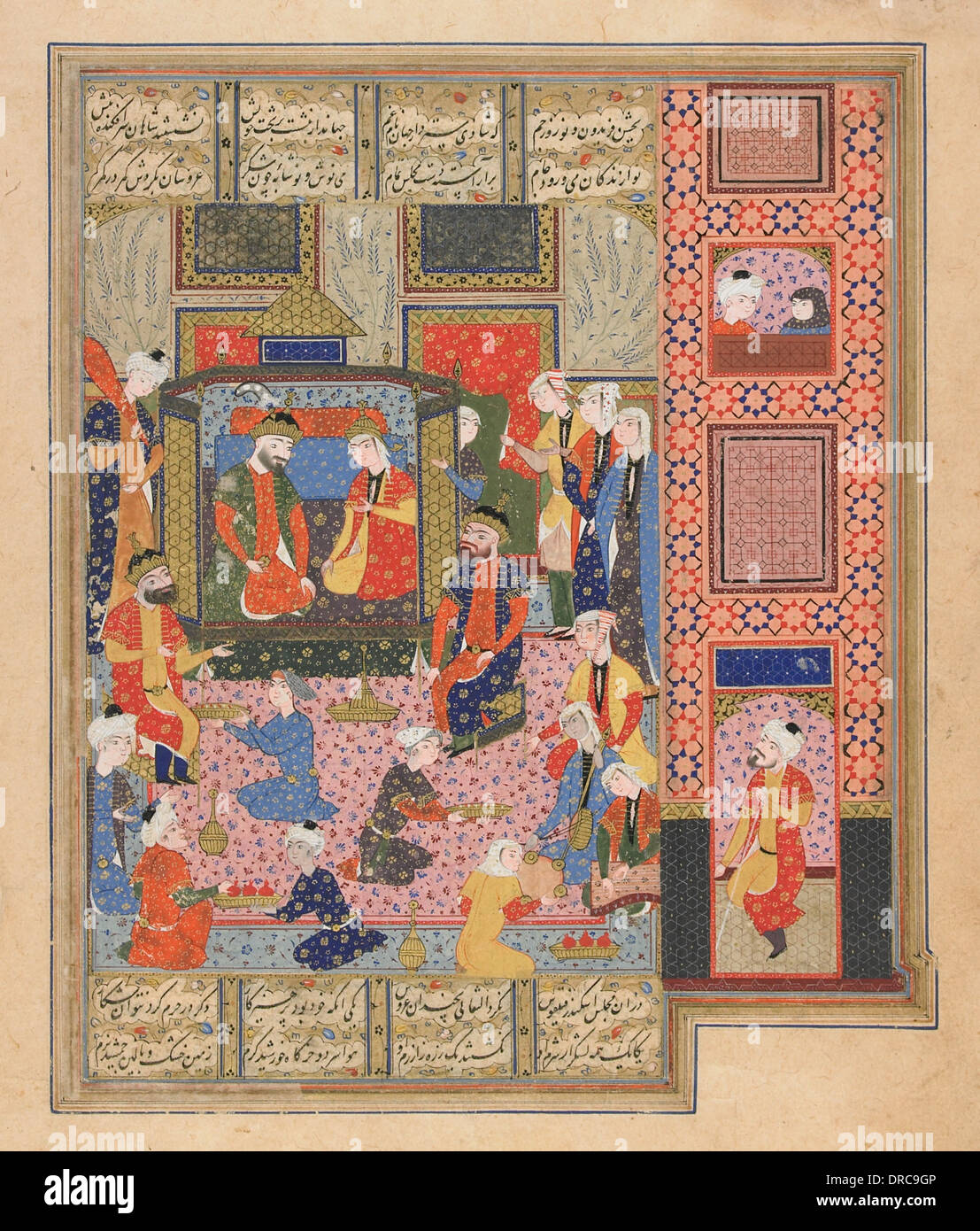 Painting depicting the feast of Iskandar and Nushabah from Nizami Ganjavi's (1141-1209) 'Iskandarnamah' (The Book of Alexander the Great). 16th Century Persian manuscript. On his way to the Land of Darkness Alexander visits the queen of Barda, Nushabah, she organizes an 'ishrat (large feast) for him and invites him to sit next to her on a golden throne. Servants and musicians surround the couple. Illustration from Nizami Ganjavi's 'Iskandarnamah' (The Book of Alexander the Great)16th Century manuscript. Stock Photohttps://www.alamy.com/image-license-details/?v=1https://www.alamy.com/painting-depicting-the-feast-of-iskandar-and-nushabah-from-nizami-image66039142.html
Painting depicting the feast of Iskandar and Nushabah from Nizami Ganjavi's (1141-1209) 'Iskandarnamah' (The Book of Alexander the Great). 16th Century Persian manuscript. On his way to the Land of Darkness Alexander visits the queen of Barda, Nushabah, she organizes an 'ishrat (large feast) for him and invites him to sit next to her on a golden throne. Servants and musicians surround the couple. Illustration from Nizami Ganjavi's 'Iskandarnamah' (The Book of Alexander the Great)16th Century manuscript. Stock Photohttps://www.alamy.com/image-license-details/?v=1https://www.alamy.com/painting-depicting-the-feast-of-iskandar-and-nushabah-from-nizami-image66039142.htmlRMDRC9GP–Painting depicting the feast of Iskandar and Nushabah from Nizami Ganjavi's (1141-1209) 'Iskandarnamah' (The Book of Alexander the Great). 16th Century Persian manuscript. On his way to the Land of Darkness Alexander visits the queen of Barda, Nushabah, she organizes an 'ishrat (large feast) for him and invites him to sit next to her on a golden throne. Servants and musicians surround the couple. Illustration from Nizami Ganjavi's 'Iskandarnamah' (The Book of Alexander the Great)16th Century manuscript.
 Sotheby's, London, UK. 20th Oct, 2023. Art of the Islamic World & India with over 1,000 Years of Historic Objects, Paintings & Manuscript, takes place on 25th October. Highlights include: Khurasan bronze bird-form incense burner, Persia, 12th century, estimate £150,000-200,000. Credit: Malcolm Park/Alamy Live News Stock Photohttps://www.alamy.com/image-license-details/?v=1https://www.alamy.com/sothebys-london-uk-20th-oct-2023-art-of-the-islamic-world-india-with-over-1000-years-of-historic-objects-paintings-manuscript-takes-place-on-25th-october-highlights-include-khurasan-bronze-bird-form-incense-burner-persia-12th-century-estimate-150000-200000-credit-malcolm-parkalamy-live-news-image569598471.html
Sotheby's, London, UK. 20th Oct, 2023. Art of the Islamic World & India with over 1,000 Years of Historic Objects, Paintings & Manuscript, takes place on 25th October. Highlights include: Khurasan bronze bird-form incense burner, Persia, 12th century, estimate £150,000-200,000. Credit: Malcolm Park/Alamy Live News Stock Photohttps://www.alamy.com/image-license-details/?v=1https://www.alamy.com/sothebys-london-uk-20th-oct-2023-art-of-the-islamic-world-india-with-over-1000-years-of-historic-objects-paintings-manuscript-takes-place-on-25th-october-highlights-include-khurasan-bronze-bird-form-incense-burner-persia-12th-century-estimate-150000-200000-credit-malcolm-parkalamy-live-news-image569598471.htmlRM2T2KCJF–Sotheby's, London, UK. 20th Oct, 2023. Art of the Islamic World & India with over 1,000 Years of Historic Objects, Paintings & Manuscript, takes place on 25th October. Highlights include: Khurasan bronze bird-form incense burner, Persia, 12th century, estimate £150,000-200,000. Credit: Malcolm Park/Alamy Live News
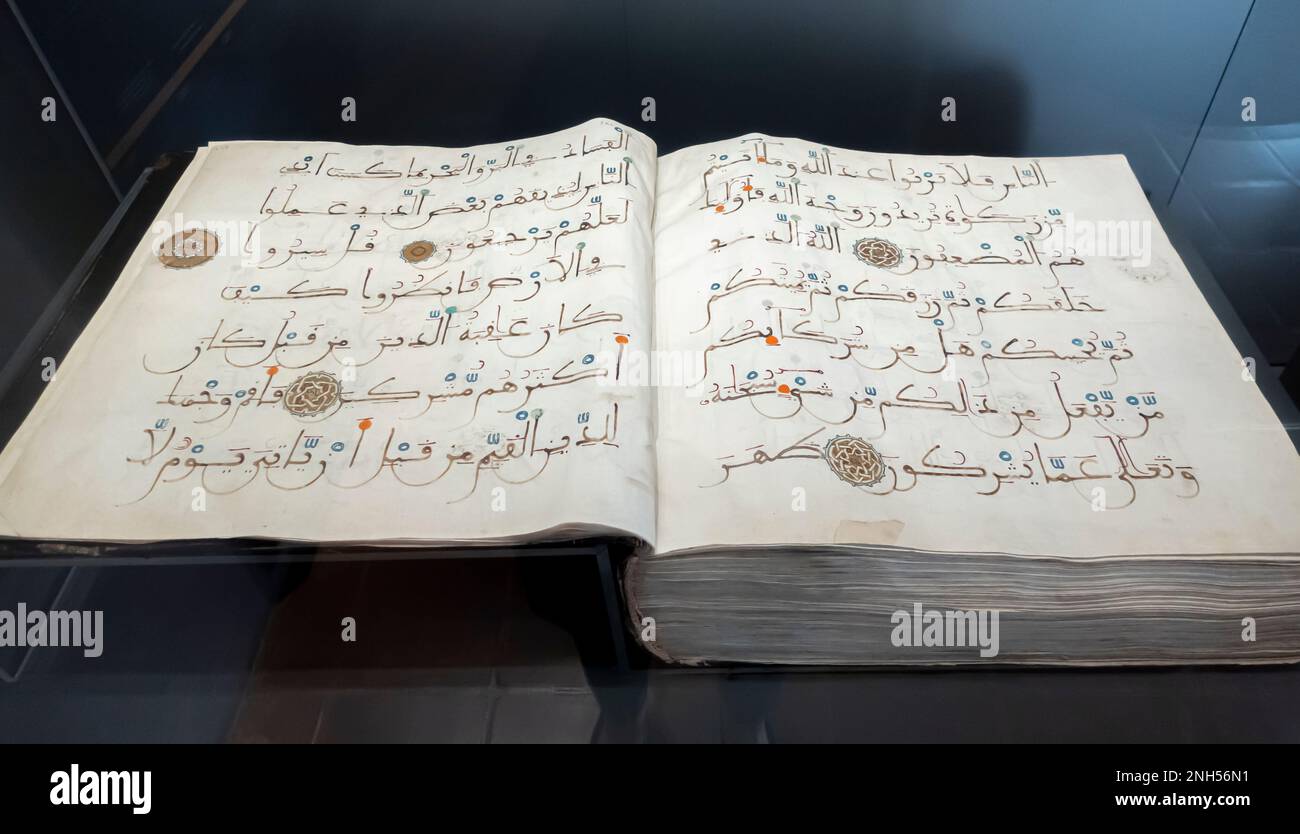 Quran, qu'ran, koran, quaran. Umayyad period. North Africa 12th-13th century. Museum of Turkish and Islamic Arts in Istanbul Stock Photohttps://www.alamy.com/image-license-details/?v=1https://www.alamy.com/quran-quran-koran-quaran-umayyad-period-north-africa-12th-13th-century-museum-of-turkish-and-islamic-arts-in-istanbul-image526875245.html
Quran, qu'ran, koran, quaran. Umayyad period. North Africa 12th-13th century. Museum of Turkish and Islamic Arts in Istanbul Stock Photohttps://www.alamy.com/image-license-details/?v=1https://www.alamy.com/quran-quran-koran-quaran-umayyad-period-north-africa-12th-13th-century-museum-of-turkish-and-islamic-arts-in-istanbul-image526875245.htmlRM2NH56N1–Quran, qu'ran, koran, quaran. Umayyad period. North Africa 12th-13th century. Museum of Turkish and Islamic Arts in Istanbul
 Folio from a Qur'an Manuscript. Dimensions: 13 7/8 x 8 9/16in. (35.2 x 21.7cm). Date: late 12th-early 13th century. Museum: Metropolitan Museum of Art, New York, USA. Stock Photohttps://www.alamy.com/image-license-details/?v=1https://www.alamy.com/folio-from-a-quran-manuscript-dimensions-13-78-x-8-916in-352-x-217cm-date-late-12th-early-13th-century-museum-metropolitan-museum-of-art-new-york-usa-image213320434.html
Folio from a Qur'an Manuscript. Dimensions: 13 7/8 x 8 9/16in. (35.2 x 21.7cm). Date: late 12th-early 13th century. Museum: Metropolitan Museum of Art, New York, USA. Stock Photohttps://www.alamy.com/image-license-details/?v=1https://www.alamy.com/folio-from-a-quran-manuscript-dimensions-13-78-x-8-916in-352-x-217cm-date-late-12th-early-13th-century-museum-metropolitan-museum-of-art-new-york-usa-image213320434.htmlRMPB1GAX–Folio from a Qur'an Manuscript. Dimensions: 13 7/8 x 8 9/16in. (35.2 x 21.7cm). Date: late 12th-early 13th century. Museum: Metropolitan Museum of Art, New York, USA.
 Composed in Egypt in the first half of the 11th century, the 'Book of Curiosities' is a 12th/13th century cosmographical manuscript contains highly unique celestial and terrestrial maps, including the first known rectangular map of the world produced before the renaissance. The geographical references are based largely on the first century work of Ptolemy but the manuscript contains previously unknown distinct cartographic features. Stock Photohttps://www.alamy.com/image-license-details/?v=1https://www.alamy.com/composed-in-egypt-in-the-first-half-of-the-11th-century-the-book-of-curiosities-is-a-12th13th-century-cosmographical-manuscript-contains-highly-unique-celestial-and-terrestrial-maps-including-the-first-known-rectangular-map-of-the-world-produced-before-the-renaissance-the-geographical-references-are-based-largely-on-the-first-century-work-of-ptolemy-but-the-manuscript-contains-previously-unknown-distinct-cartographic-features-image344278604.html
Composed in Egypt in the first half of the 11th century, the 'Book of Curiosities' is a 12th/13th century cosmographical manuscript contains highly unique celestial and terrestrial maps, including the first known rectangular map of the world produced before the renaissance. The geographical references are based largely on the first century work of Ptolemy but the manuscript contains previously unknown distinct cartographic features. Stock Photohttps://www.alamy.com/image-license-details/?v=1https://www.alamy.com/composed-in-egypt-in-the-first-half-of-the-11th-century-the-book-of-curiosities-is-a-12th13th-century-cosmographical-manuscript-contains-highly-unique-celestial-and-terrestrial-maps-including-the-first-known-rectangular-map-of-the-world-produced-before-the-renaissance-the-geographical-references-are-based-largely-on-the-first-century-work-of-ptolemy-but-the-manuscript-contains-previously-unknown-distinct-cartographic-features-image344278604.htmlRM2B036TC–Composed in Egypt in the first half of the 11th century, the 'Book of Curiosities' is a 12th/13th century cosmographical manuscript contains highly unique celestial and terrestrial maps, including the first known rectangular map of the world produced before the renaissance. The geographical references are based largely on the first century work of Ptolemy but the manuscript contains previously unknown distinct cartographic features.
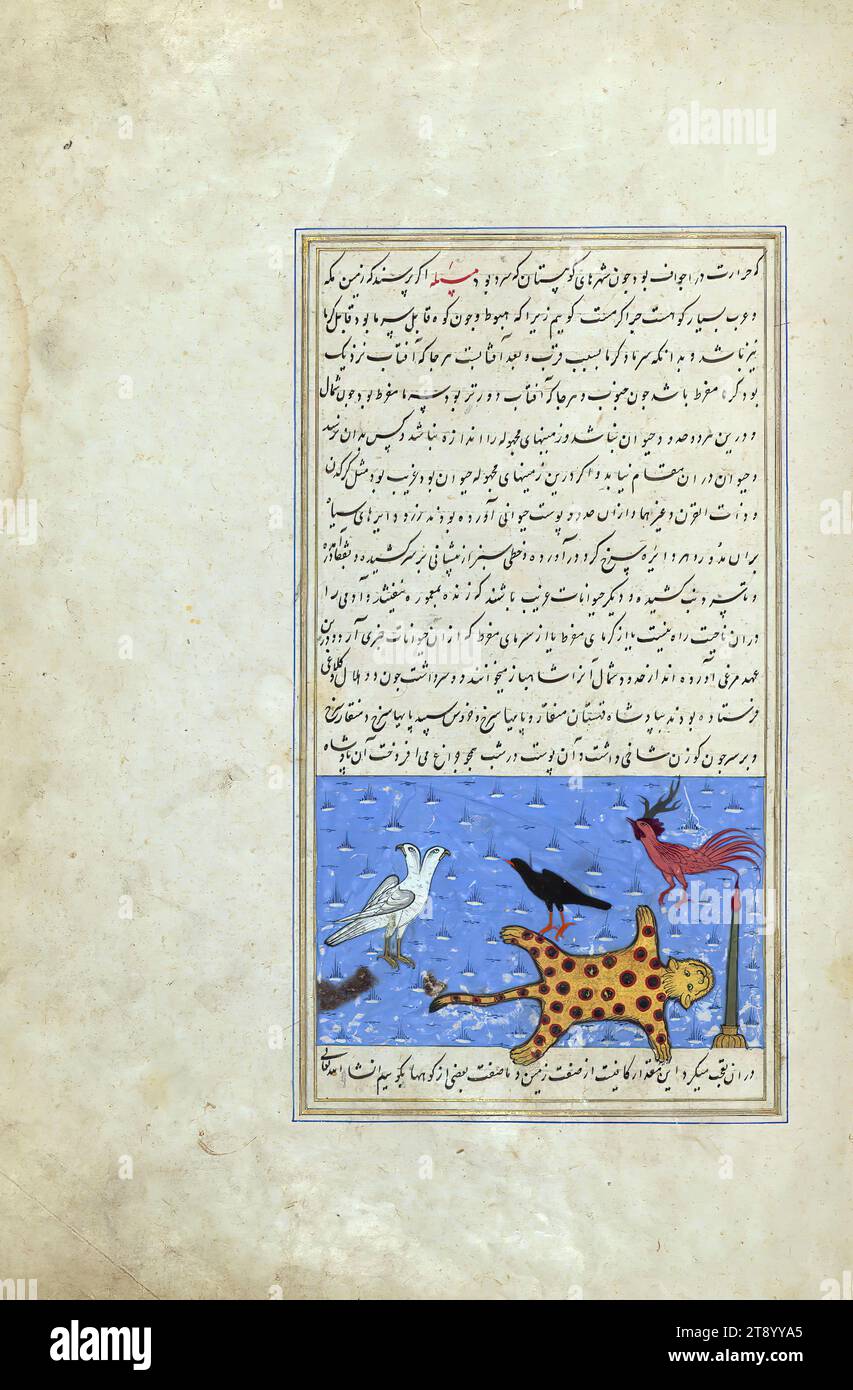 Wonders of creation, Birds brought from Arabia, A Persian version of the famous 'Wonders of creation' (ʿAjā’ib al-makhlūqāt) by Zakariyāʾ al-Qazwīnī (d. 682 AH / 1283 CE). Composed by Shams al-Dīn Muḥammad al-Ṭūsī (fl. 6th century AH /12th CE), this manuscript, which may have been copied by an Iranian scribe, was illustrated with 181 miniatures (including a double-page map of the world) by several artists probably in Turkey in the 10th century AH / 16th CE Stock Photohttps://www.alamy.com/image-license-details/?v=1https://www.alamy.com/wonders-of-creation-birds-brought-from-arabia-a-persian-version-of-the-famous-wonders-of-creation-ajib-al-makhlqt-by-zakariy-al-qazwn-d-682-ah-1283-ce-composed-by-shams-al-dn-muammad-al-s-fl-6th-century-ah-12th-ce-this-manuscript-which-may-have-been-copied-by-an-iranian-scribe-was-illustrated-with-181-miniatures-including-a-double-page-map-of-the-world-by-several-artists-probably-in-turkey-in-the-10th-century-ah-16th-ce-image573473549.html
Wonders of creation, Birds brought from Arabia, A Persian version of the famous 'Wonders of creation' (ʿAjā’ib al-makhlūqāt) by Zakariyāʾ al-Qazwīnī (d. 682 AH / 1283 CE). Composed by Shams al-Dīn Muḥammad al-Ṭūsī (fl. 6th century AH /12th CE), this manuscript, which may have been copied by an Iranian scribe, was illustrated with 181 miniatures (including a double-page map of the world) by several artists probably in Turkey in the 10th century AH / 16th CE Stock Photohttps://www.alamy.com/image-license-details/?v=1https://www.alamy.com/wonders-of-creation-birds-brought-from-arabia-a-persian-version-of-the-famous-wonders-of-creation-ajib-al-makhlqt-by-zakariy-al-qazwn-d-682-ah-1283-ce-composed-by-shams-al-dn-muammad-al-s-fl-6th-century-ah-12th-ce-this-manuscript-which-may-have-been-copied-by-an-iranian-scribe-was-illustrated-with-181-miniatures-including-a-double-page-map-of-the-world-by-several-artists-probably-in-turkey-in-the-10th-century-ah-16th-ce-image573473549.htmlRM2T8YYA5–Wonders of creation, Birds brought from Arabia, A Persian version of the famous 'Wonders of creation' (ʿAjā’ib al-makhlūqāt) by Zakariyāʾ al-Qazwīnī (d. 682 AH / 1283 CE). Composed by Shams al-Dīn Muḥammad al-Ṭūsī (fl. 6th century AH /12th CE), this manuscript, which may have been copied by an Iranian scribe, was illustrated with 181 miniatures (including a double-page map of the world) by several artists probably in Turkey in the 10th century AH / 16th CE
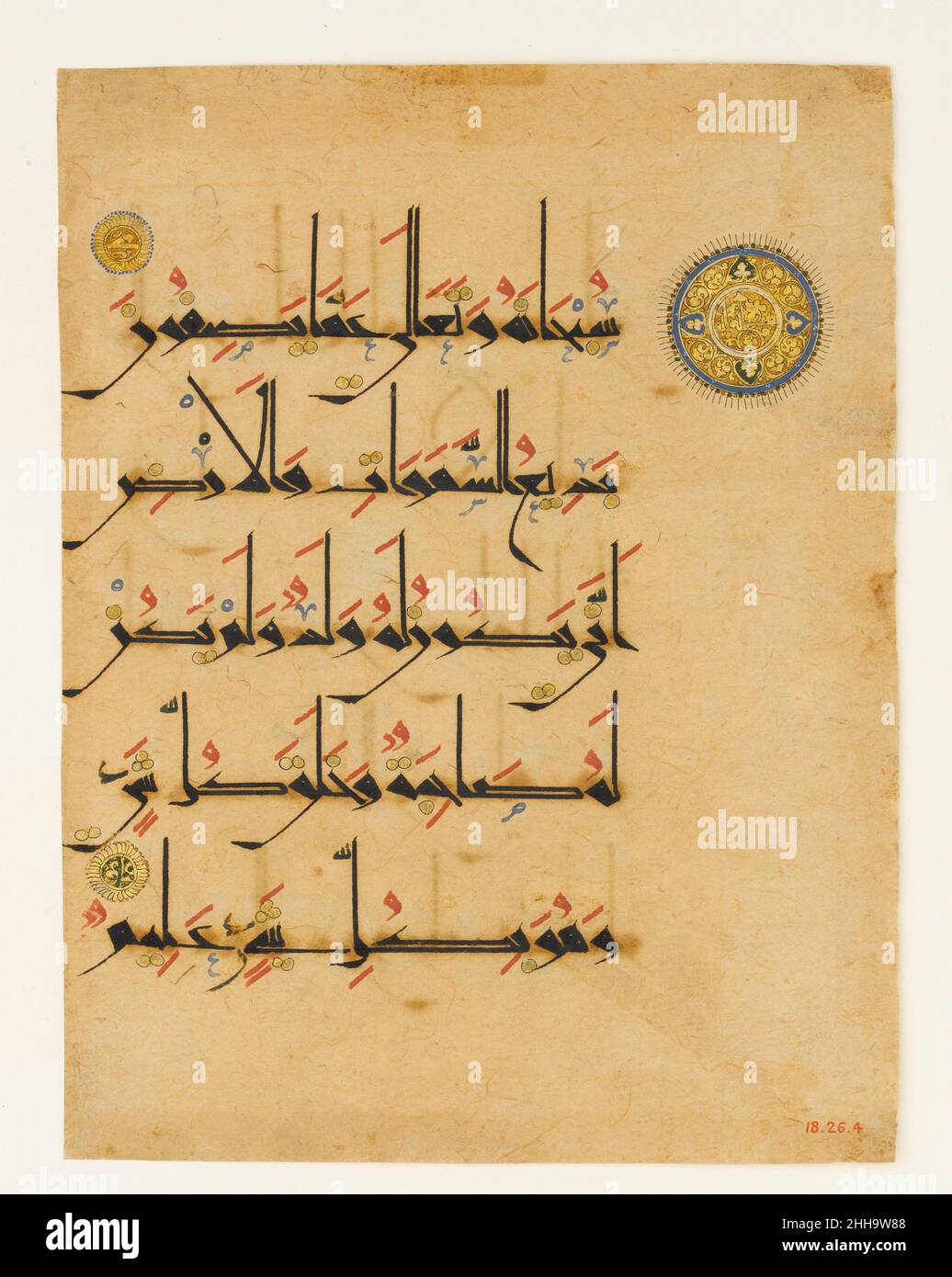 Folio from a Qur'an Manuscript late 11th–12th century This folio from a Qur’an is written on paper in black new style script, with vocalizations in red, diacritical marks in gold, and other orthographical signs in blue and black. The golden medallions are verse markers: the smaller ones contain letter numerals, while the larger one contains the words '100 verses' encircled by a band of trefoil scrolls, indicating the beginning of the 100th verse of Sura 6 (al-An‘am, 'of the Cattle').Paper, a Chinese invention, was first produced in the Islamic lands from the late 8th century, in Baghdad, but o Stock Photohttps://www.alamy.com/image-license-details/?v=1https://www.alamy.com/folio-from-a-quran-manuscript-late-11th12th-century-this-folio-from-a-quran-is-written-on-paper-in-black-new-style-script-with-vocalizations-in-red-diacritical-marks-in-gold-and-other-orthographical-signs-in-blue-and-black-the-golden-medallions-are-verse-markers-the-smaller-ones-contain-letter-numerals-while-the-larger-one-contains-the-words-100-verses-encircled-by-a-band-of-trefoil-scrolls-indicating-the-beginning-of-the-100th-verse-of-sura-6-al-anam-of-the-cattlepaper-a-chinese-invention-was-first-produced-in-the-islamic-lands-from-the-late-8th-century-in-baghdad-but-o-image458136120.html
Folio from a Qur'an Manuscript late 11th–12th century This folio from a Qur’an is written on paper in black new style script, with vocalizations in red, diacritical marks in gold, and other orthographical signs in blue and black. The golden medallions are verse markers: the smaller ones contain letter numerals, while the larger one contains the words '100 verses' encircled by a band of trefoil scrolls, indicating the beginning of the 100th verse of Sura 6 (al-An‘am, 'of the Cattle').Paper, a Chinese invention, was first produced in the Islamic lands from the late 8th century, in Baghdad, but o Stock Photohttps://www.alamy.com/image-license-details/?v=1https://www.alamy.com/folio-from-a-quran-manuscript-late-11th12th-century-this-folio-from-a-quran-is-written-on-paper-in-black-new-style-script-with-vocalizations-in-red-diacritical-marks-in-gold-and-other-orthographical-signs-in-blue-and-black-the-golden-medallions-are-verse-markers-the-smaller-ones-contain-letter-numerals-while-the-larger-one-contains-the-words-100-verses-encircled-by-a-band-of-trefoil-scrolls-indicating-the-beginning-of-the-100th-verse-of-sura-6-al-anam-of-the-cattlepaper-a-chinese-invention-was-first-produced-in-the-islamic-lands-from-the-late-8th-century-in-baghdad-but-o-image458136120.htmlRM2HH9W88–Folio from a Qur'an Manuscript late 11th–12th century This folio from a Qur’an is written on paper in black new style script, with vocalizations in red, diacritical marks in gold, and other orthographical signs in blue and black. The golden medallions are verse markers: the smaller ones contain letter numerals, while the larger one contains the words '100 verses' encircled by a band of trefoil scrolls, indicating the beginning of the 100th verse of Sura 6 (al-An‘am, 'of the Cattle').Paper, a Chinese invention, was first produced in the Islamic lands from the late 8th century, in Baghdad, but o
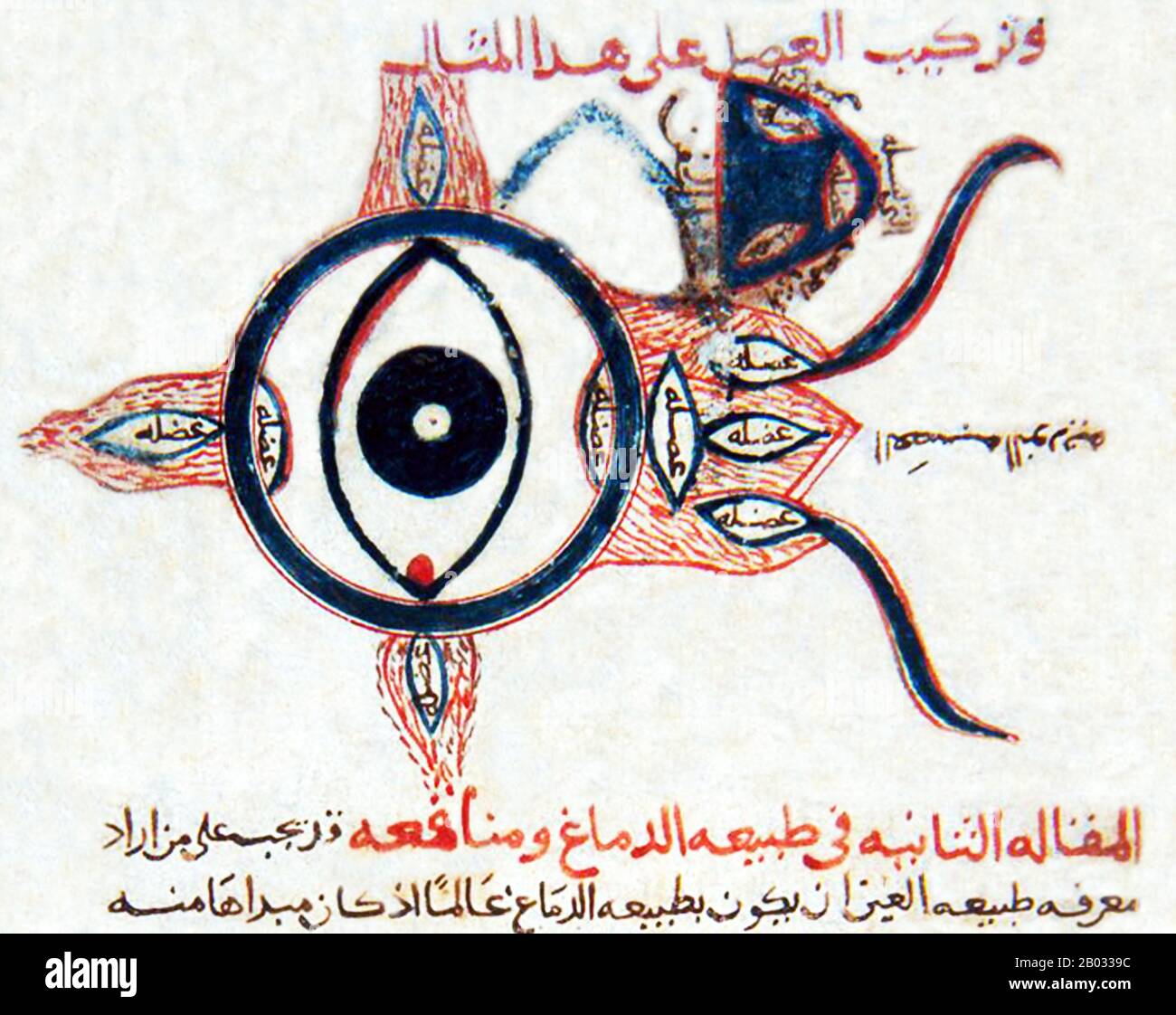 Hunayn ibn Ishaq ( Latin: Iohannitius) (809 – 873) was a famous and influential scholar, physician, and scientist of Nestorian Arab Christian descent. He and his students transmitted their Syriac and Arabic translations of many classical Greek texts throughout the Islamic world, during the apex of the Islamic Abbasid Caliphate. Hunayn ibn Ishaq was the most productive translator of Greek medical and scientific treatises in his day. He studied Greek and became known among the Arabs as the 'Sheikh of the translators'. He mastered four languages: Arabic, Syriac, Greek and Persian. Stock Photohttps://www.alamy.com/image-license-details/?v=1https://www.alamy.com/hunayn-ibn-ishaq-latin-iohannitius-809-873-was-a-famous-and-influential-scholar-physician-and-scientist-of-nestorian-arab-christian-descent-he-and-his-students-transmitted-their-syriac-and-arabic-translations-of-many-classical-greek-texts-throughout-the-islamic-world-during-the-apex-of-the-islamic-abbasid-caliphate-hunayn-ibn-ishaq-was-the-most-productive-translator-of-greek-medical-and-scientific-treatises-in-his-day-he-studied-greek-and-became-known-among-the-arabs-as-the-sheikh-of-the-translators-he-mastered-four-languages-arabic-syriac-greek-and-persian-image344275832.html
Hunayn ibn Ishaq ( Latin: Iohannitius) (809 – 873) was a famous and influential scholar, physician, and scientist of Nestorian Arab Christian descent. He and his students transmitted their Syriac and Arabic translations of many classical Greek texts throughout the Islamic world, during the apex of the Islamic Abbasid Caliphate. Hunayn ibn Ishaq was the most productive translator of Greek medical and scientific treatises in his day. He studied Greek and became known among the Arabs as the 'Sheikh of the translators'. He mastered four languages: Arabic, Syriac, Greek and Persian. Stock Photohttps://www.alamy.com/image-license-details/?v=1https://www.alamy.com/hunayn-ibn-ishaq-latin-iohannitius-809-873-was-a-famous-and-influential-scholar-physician-and-scientist-of-nestorian-arab-christian-descent-he-and-his-students-transmitted-their-syriac-and-arabic-translations-of-many-classical-greek-texts-throughout-the-islamic-world-during-the-apex-of-the-islamic-abbasid-caliphate-hunayn-ibn-ishaq-was-the-most-productive-translator-of-greek-medical-and-scientific-treatises-in-his-day-he-studied-greek-and-became-known-among-the-arabs-as-the-sheikh-of-the-translators-he-mastered-four-languages-arabic-syriac-greek-and-persian-image344275832.htmlRM2B0339C–Hunayn ibn Ishaq ( Latin: Iohannitius) (809 – 873) was a famous and influential scholar, physician, and scientist of Nestorian Arab Christian descent. He and his students transmitted their Syriac and Arabic translations of many classical Greek texts throughout the Islamic world, during the apex of the Islamic Abbasid Caliphate. Hunayn ibn Ishaq was the most productive translator of Greek medical and scientific treatises in his day. He studied Greek and became known among the Arabs as the 'Sheikh of the translators'. He mastered four languages: Arabic, Syriac, Greek and Persian.
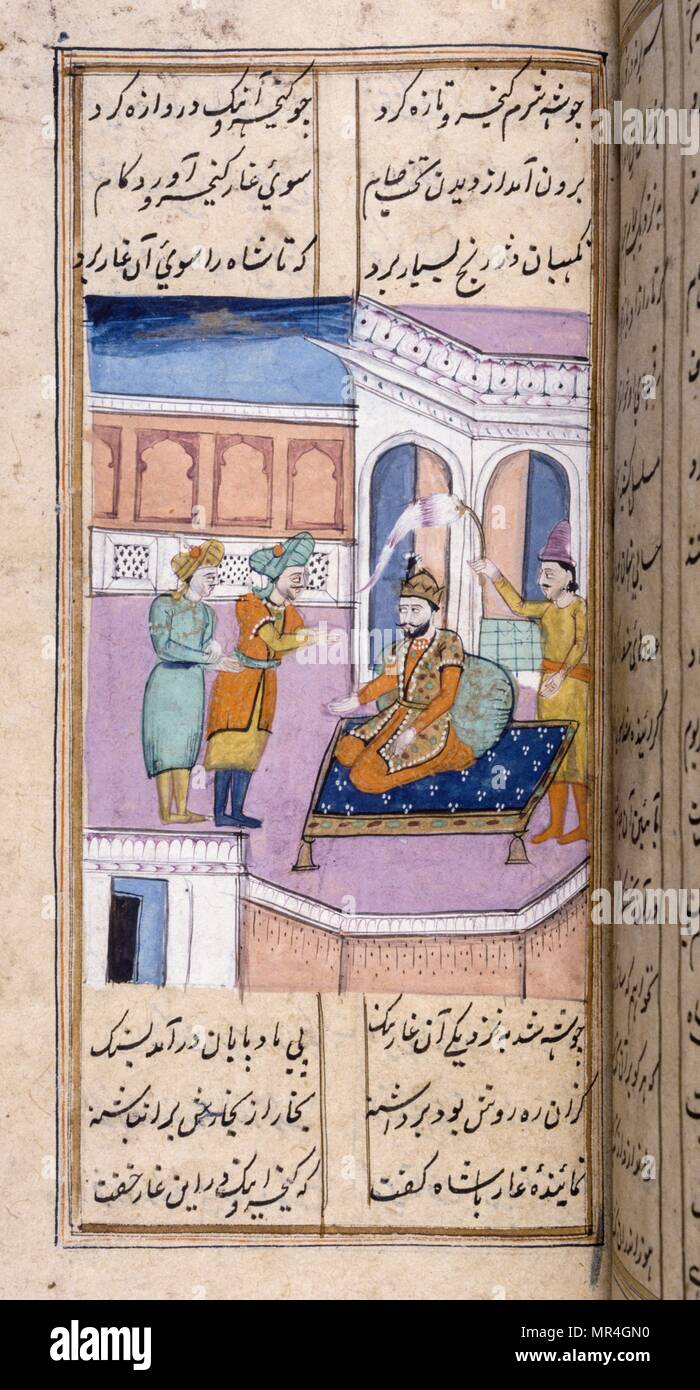 Persian (Iranian) Islamic style, manuscript, Illustrated 12th century: The poet Nezami recounts the tales of Alexander the great Stock Photohttps://www.alamy.com/image-license-details/?v=1https://www.alamy.com/persian-iranian-islamic-style-manuscript-illustrated-12th-century-the-poet-nezami-recounts-the-tales-of-alexander-the-great-image186341708.html
Persian (Iranian) Islamic style, manuscript, Illustrated 12th century: The poet Nezami recounts the tales of Alexander the great Stock Photohttps://www.alamy.com/image-license-details/?v=1https://www.alamy.com/persian-iranian-islamic-style-manuscript-illustrated-12th-century-the-poet-nezami-recounts-the-tales-of-alexander-the-great-image186341708.htmlRMMR4GN0–Persian (Iranian) Islamic style, manuscript, Illustrated 12th century: The poet Nezami recounts the tales of Alexander the great
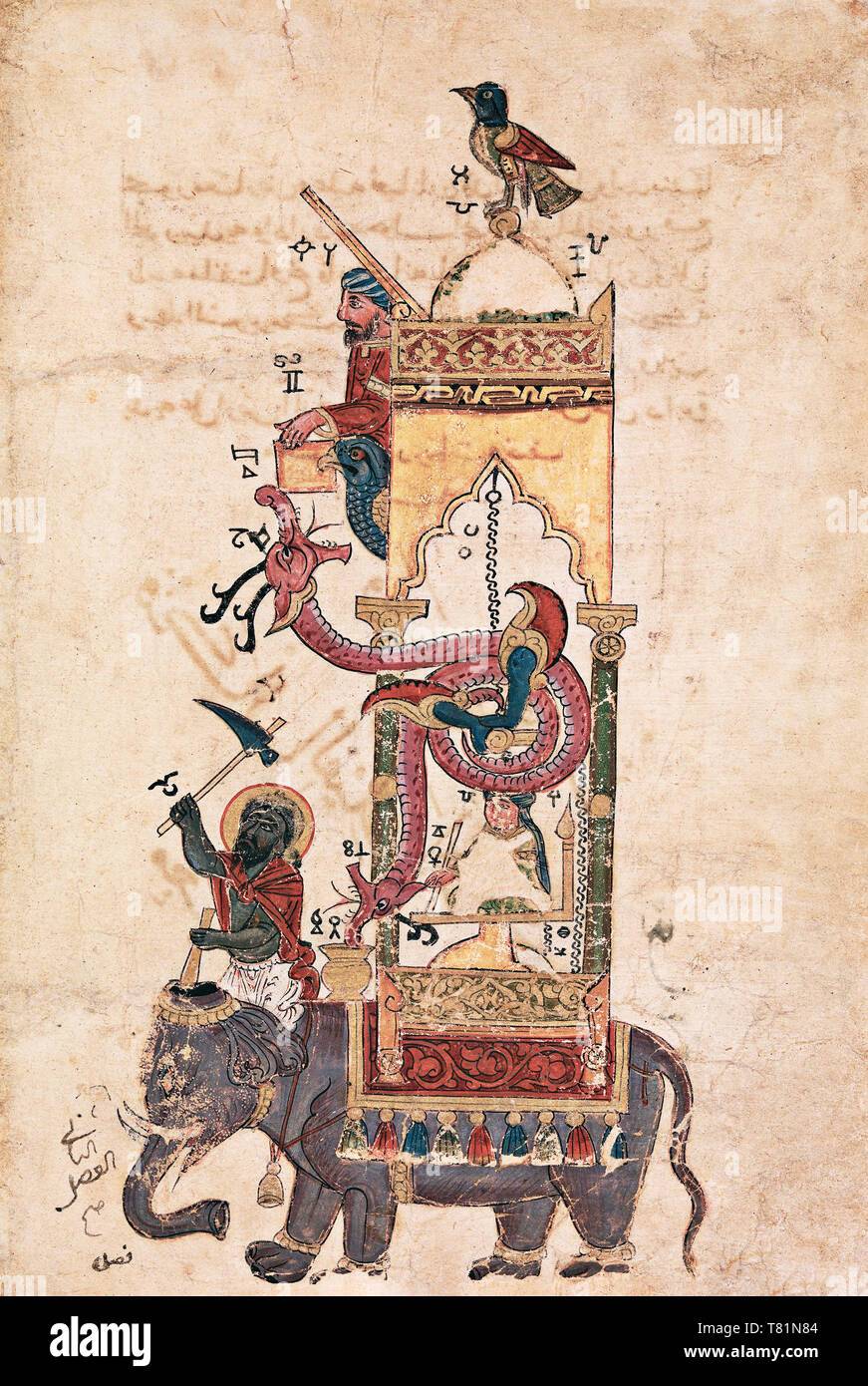 Al-Jazari, Elephant Clock, 12th Century Stock Photohttps://www.alamy.com/image-license-details/?v=1https://www.alamy.com/al-jazari-elephant-clock-12th-century-image245901044.html
Al-Jazari, Elephant Clock, 12th Century Stock Photohttps://www.alamy.com/image-license-details/?v=1https://www.alamy.com/al-jazari-elephant-clock-12th-century-image245901044.htmlRMT81N84–Al-Jazari, Elephant Clock, 12th Century
 Manuscript Quran from the 12th century in museum, Madinah, Kingdom of Saudi Arabia Stock Photohttps://www.alamy.com/image-license-details/?v=1https://www.alamy.com/stock-photo-manuscript-quran-from-the-12th-century-in-museum-madinah-kingdom-of-148187985.html
Manuscript Quran from the 12th century in museum, Madinah, Kingdom of Saudi Arabia Stock Photohttps://www.alamy.com/image-license-details/?v=1https://www.alamy.com/stock-photo-manuscript-quran-from-the-12th-century-in-museum-madinah-kingdom-of-148187985.htmlRMJH2F81–Manuscript Quran from the 12th century in museum, Madinah, Kingdom of Saudi Arabia
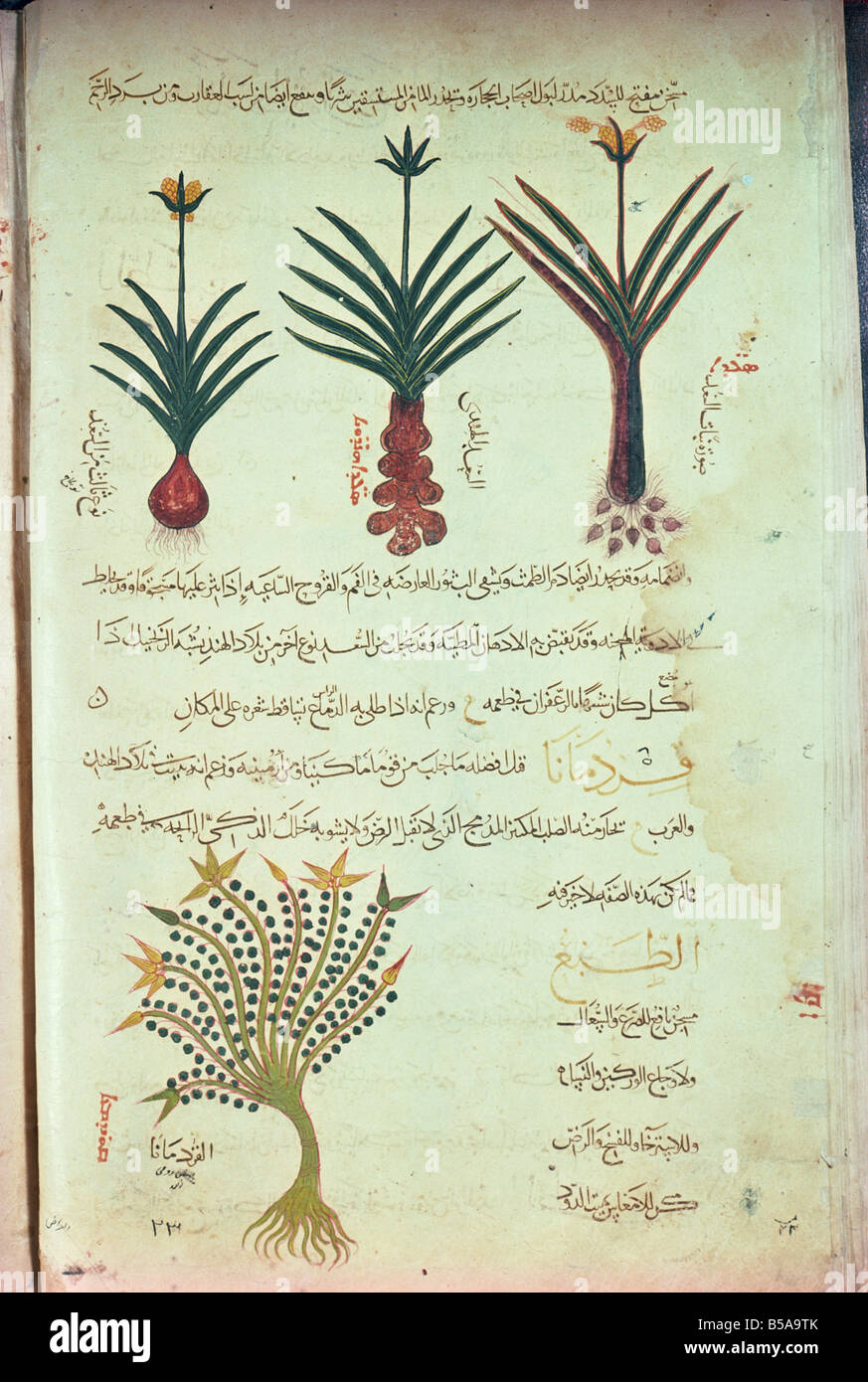 Islamic manuscript Khawaso al Ashjan dating from 12th century Mashad Iran Middle East Stock Photohttps://www.alamy.com/image-license-details/?v=1https://www.alamy.com/stock-photo-islamic-manuscript-khawaso-al-ashjan-dating-from-12th-century-mashad-20510915.html
Islamic manuscript Khawaso al Ashjan dating from 12th century Mashad Iran Middle East Stock Photohttps://www.alamy.com/image-license-details/?v=1https://www.alamy.com/stock-photo-islamic-manuscript-khawaso-al-ashjan-dating-from-12th-century-mashad-20510915.htmlRMB5A9TK–Islamic manuscript Khawaso al Ashjan dating from 12th century Mashad Iran Middle East
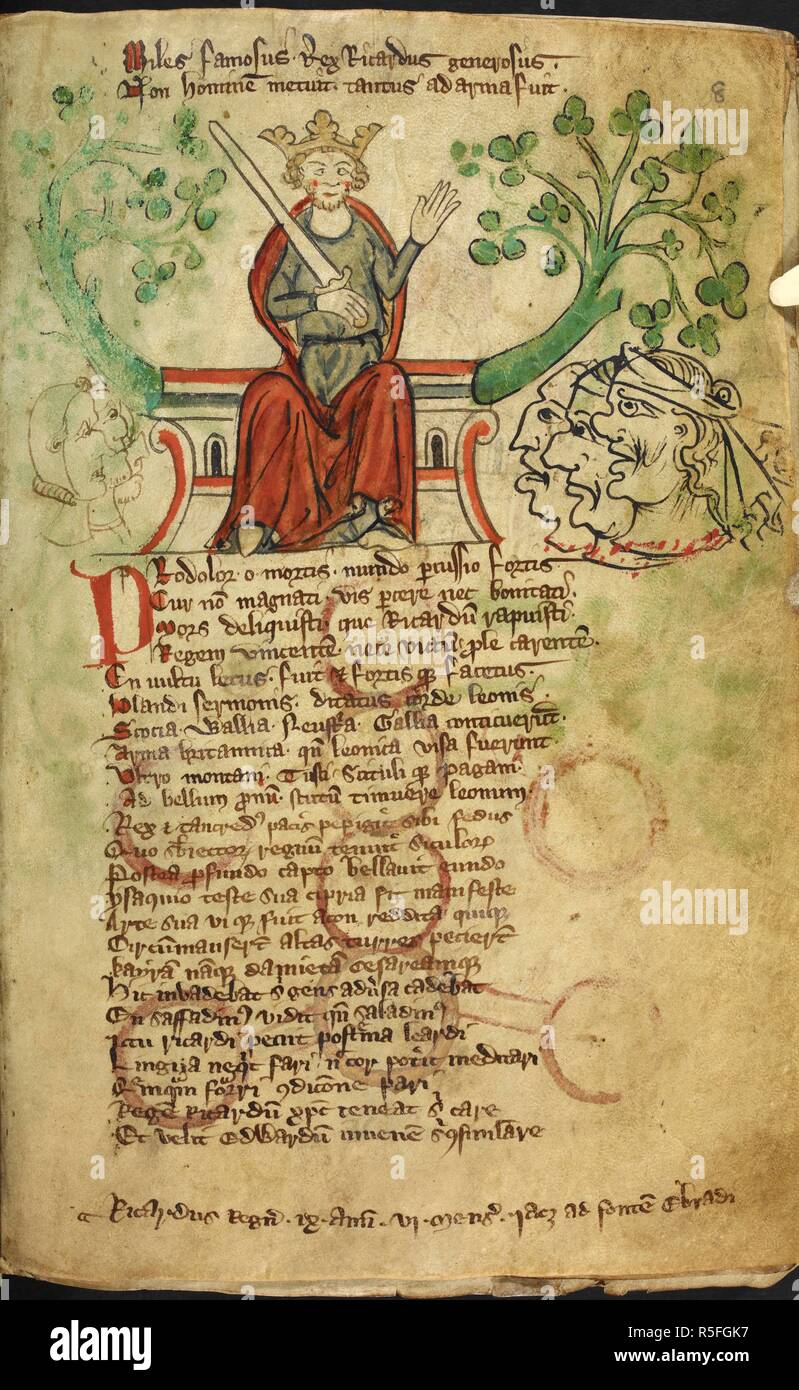 King Richard I with sword, on his throne, with three Christians' heads beneath on the left; and three Saracens' heads (cut off) on the right. Twenty-four lines of text. Chronicle of England. England, 1st half of the 14th century. Source: Royal 20 A. II f.8. Language: Latin and French. Author: Langtoft, Peter de. Stock Photohttps://www.alamy.com/image-license-details/?v=1https://www.alamy.com/king-richard-i-with-sword-on-his-throne-with-three-christians-heads-beneath-on-the-left-and-three-saracens-heads-cut-off-on-the-right-twenty-four-lines-of-text-chronicle-of-england-england-1st-half-of-the-14th-century-source-royal-20-a-ii-f8-language-latin-and-french-author-langtoft-peter-de-image227150427.html
King Richard I with sword, on his throne, with three Christians' heads beneath on the left; and three Saracens' heads (cut off) on the right. Twenty-four lines of text. Chronicle of England. England, 1st half of the 14th century. Source: Royal 20 A. II f.8. Language: Latin and French. Author: Langtoft, Peter de. Stock Photohttps://www.alamy.com/image-license-details/?v=1https://www.alamy.com/king-richard-i-with-sword-on-his-throne-with-three-christians-heads-beneath-on-the-left-and-three-saracens-heads-cut-off-on-the-right-twenty-four-lines-of-text-chronicle-of-england-england-1st-half-of-the-14th-century-source-royal-20-a-ii-f8-language-latin-and-french-author-langtoft-peter-de-image227150427.htmlRMR5FGK7–King Richard I with sword, on his throne, with three Christians' heads beneath on the left; and three Saracens' heads (cut off) on the right. Twenty-four lines of text. Chronicle of England. England, 1st half of the 14th century. Source: Royal 20 A. II f.8. Language: Latin and French. Author: Langtoft, Peter de.
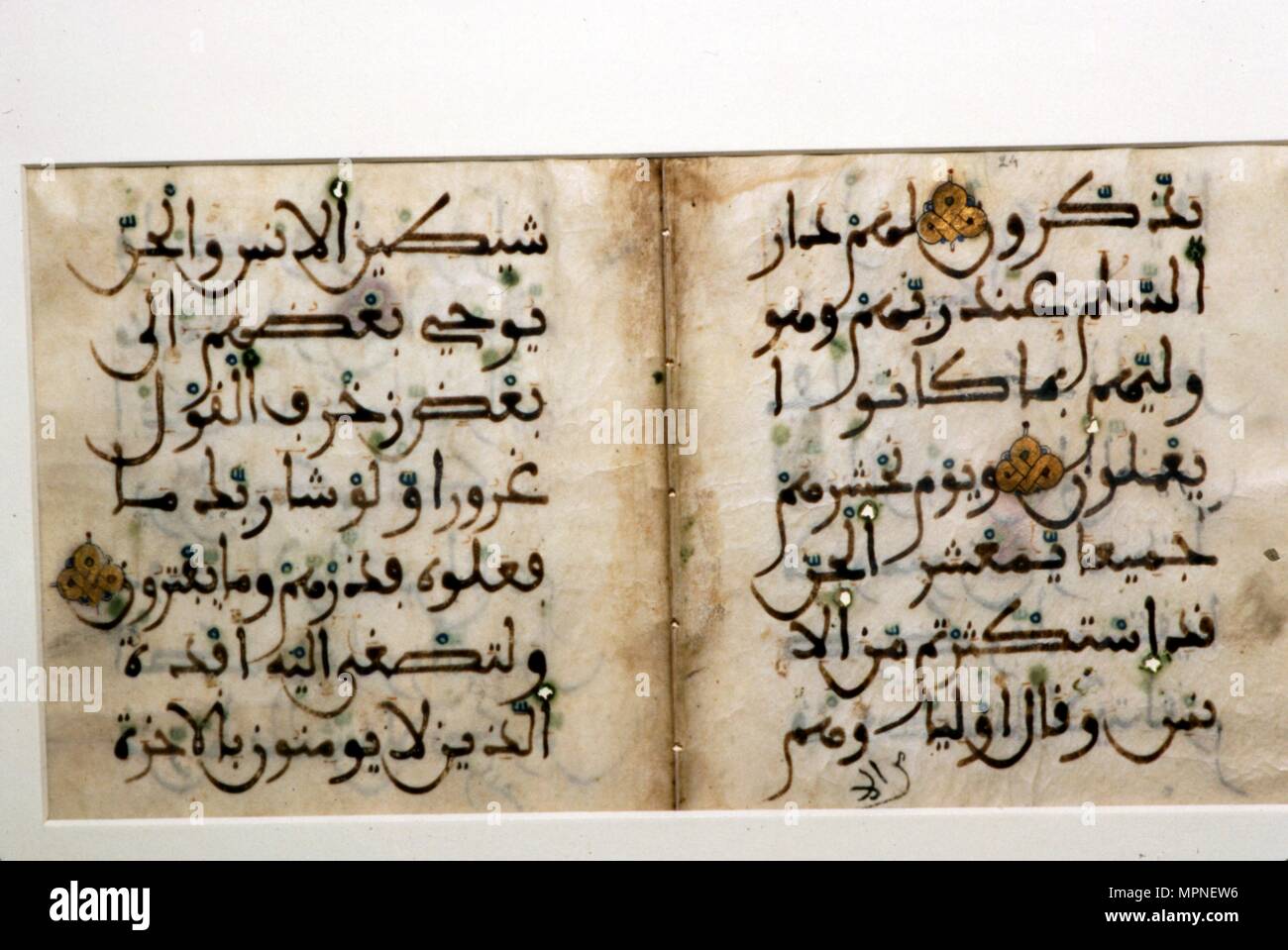 Double page from the Koran, Islamic Manuscript in Maghrebi, North African, 12th century. Artist: Unknown. Stock Photohttps://www.alamy.com/image-license-details/?v=1https://www.alamy.com/double-page-from-the-koran-islamic-manuscript-in-maghrebi-north-african-12th-century-artist-unknown-image186098786.html
Double page from the Koran, Islamic Manuscript in Maghrebi, North African, 12th century. Artist: Unknown. Stock Photohttps://www.alamy.com/image-license-details/?v=1https://www.alamy.com/double-page-from-the-koran-islamic-manuscript-in-maghrebi-north-african-12th-century-artist-unknown-image186098786.htmlRMMPNEW6–Double page from the Koran, Islamic Manuscript in Maghrebi, North African, 12th century. Artist: Unknown.
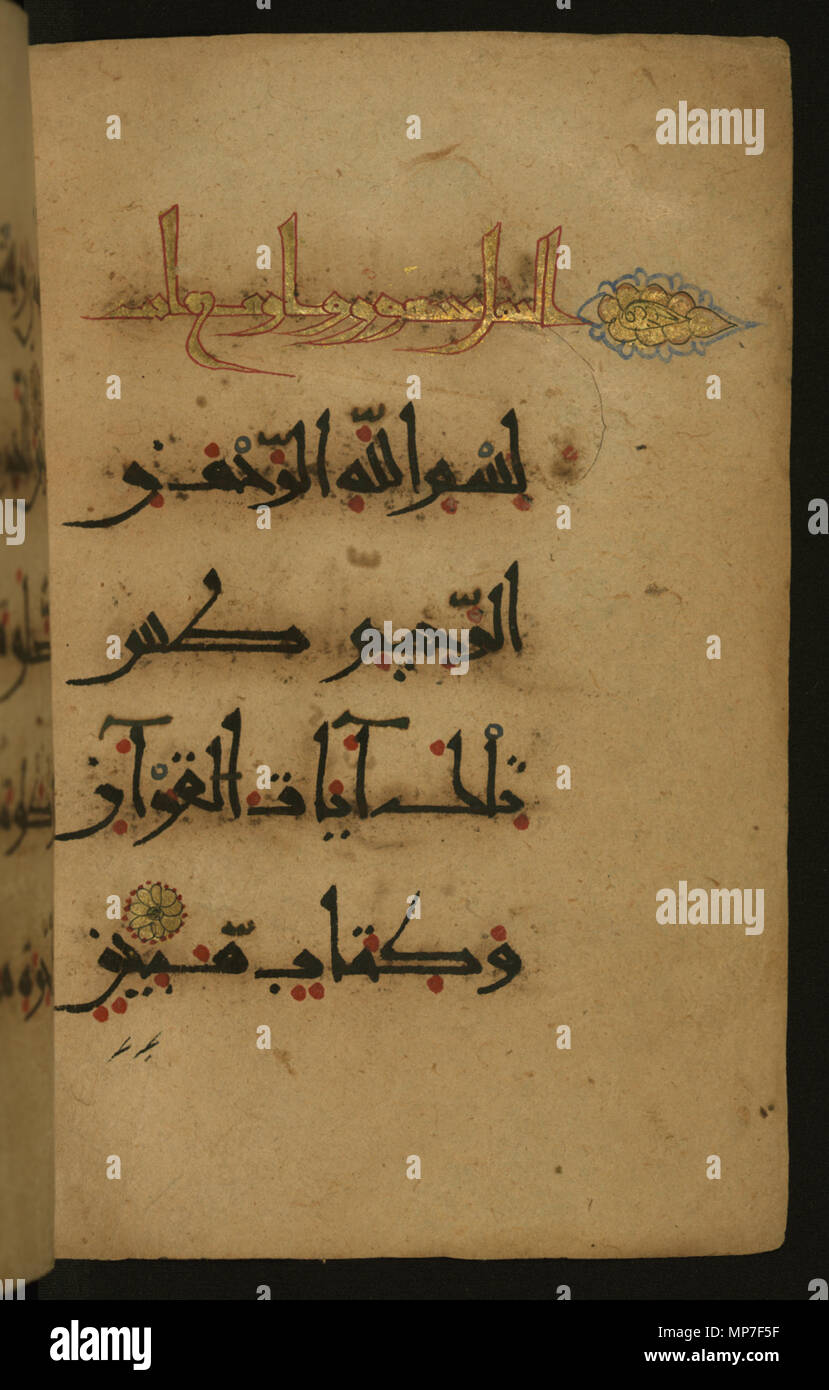 Chapter Heading for Chapter 27 (Surat al-naml). English: This folio from Walters manuscript W.555 contains a chapter heading executed in gold ink with a red outline, from which extends a small palmette outlined in red and blue. . 5th century AH/AD 11th century-6th century AH/AD 12th century (Abbasid period (750-1258)). 676 Islamic - Chapter Heading for Chapter 27 (Surat al-naml) - Walters W55565B - Full Page Stock Photohttps://www.alamy.com/image-license-details/?v=1https://www.alamy.com/chapter-heading-for-chapter-27-surat-al-naml-english-this-folio-from-walters-manuscript-w555-contains-a-chapter-heading-executed-in-gold-ink-with-a-red-outline-from-which-extends-a-small-palmette-outlined-in-red-and-blue-5th-century-ahad-11th-century-6th-century-ahad-12th-century-abbasid-period-750-1258-676-islamic-chapter-heading-for-chapter-27-surat-al-naml-walters-w55565b-full-page-image185791691.html
Chapter Heading for Chapter 27 (Surat al-naml). English: This folio from Walters manuscript W.555 contains a chapter heading executed in gold ink with a red outline, from which extends a small palmette outlined in red and blue. . 5th century AH/AD 11th century-6th century AH/AD 12th century (Abbasid period (750-1258)). 676 Islamic - Chapter Heading for Chapter 27 (Surat al-naml) - Walters W55565B - Full Page Stock Photohttps://www.alamy.com/image-license-details/?v=1https://www.alamy.com/chapter-heading-for-chapter-27-surat-al-naml-english-this-folio-from-walters-manuscript-w555-contains-a-chapter-heading-executed-in-gold-ink-with-a-red-outline-from-which-extends-a-small-palmette-outlined-in-red-and-blue-5th-century-ahad-11th-century-6th-century-ahad-12th-century-abbasid-period-750-1258-676-islamic-chapter-heading-for-chapter-27-surat-al-naml-walters-w55565b-full-page-image185791691.htmlRMMP7F5F–Chapter Heading for Chapter 27 (Surat al-naml). English: This folio from Walters manuscript W.555 contains a chapter heading executed in gold ink with a red outline, from which extends a small palmette outlined in red and blue. . 5th century AH/AD 11th century-6th century AH/AD 12th century (Abbasid period (750-1258)). 676 Islamic - Chapter Heading for Chapter 27 (Surat al-naml) - Walters W55565B - Full Page
 Folio from a Qur'an Manuscript, 11th-12th century. Stock Photohttps://www.alamy.com/image-license-details/?v=1https://www.alamy.com/folio-from-a-quran-manuscript-11th-12th-century-image365762161.html
Folio from a Qur'an Manuscript, 11th-12th century. Stock Photohttps://www.alamy.com/image-license-details/?v=1https://www.alamy.com/folio-from-a-quran-manuscript-11th-12th-century-image365762161.htmlRM2C71WA9–Folio from a Qur'an Manuscript, 11th-12th century.
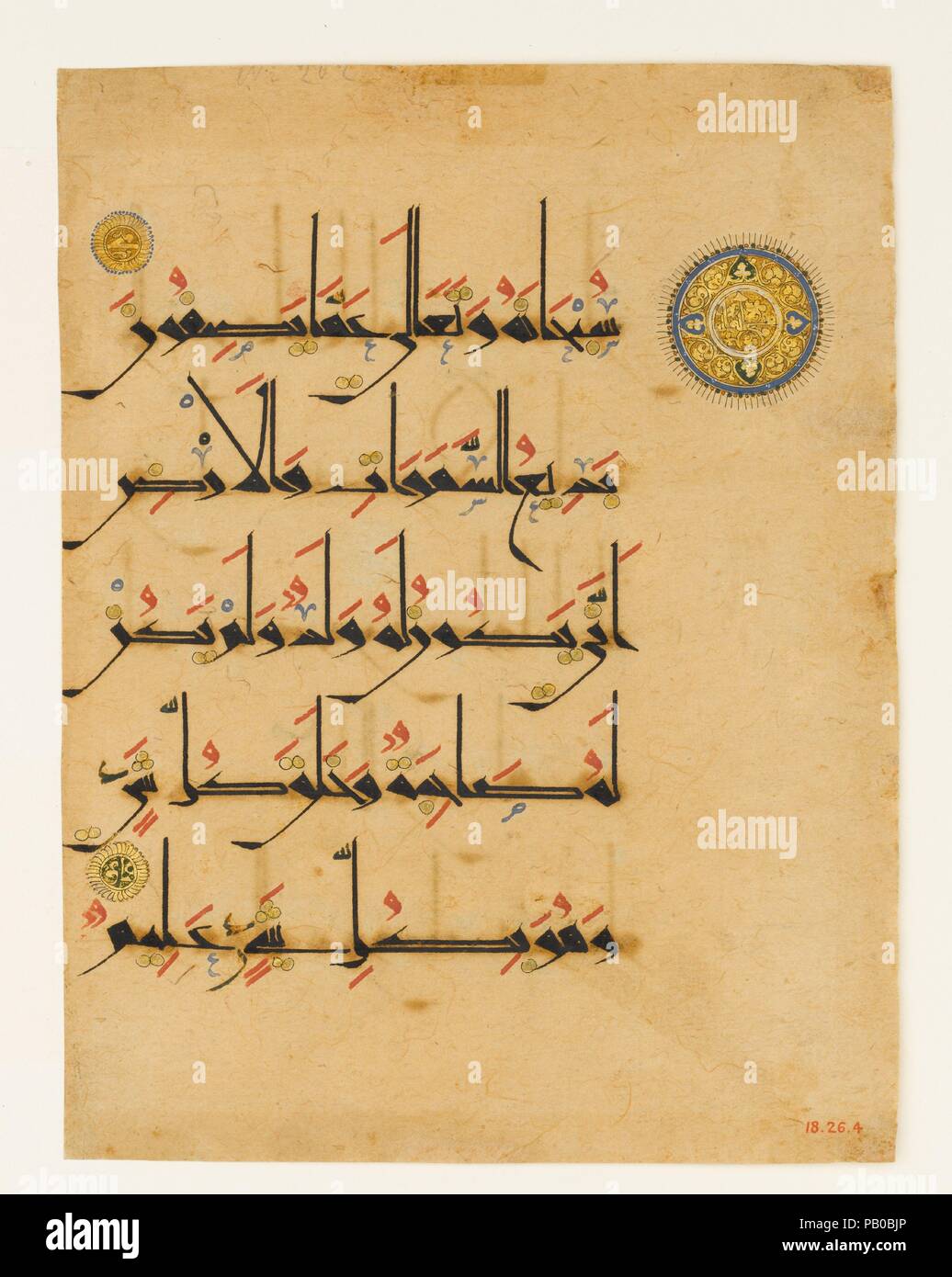 Folio from a Qur'an Manuscript. Dimensions: H.10 in. (25.4 cm) W. 7 1/4 in. (18.4 cm). Date: late 11th-12th century. This folio from a Qur'an is written on paper in black new style script, with vocalizations in red, diacritical marks in gold, and other orthographical signs in blue and black. The golden medallions are verse markers: the smaller ones contain letter numerals, while the larger one contains the words '100 verses' encircled by a band of trefoil scrolls, indicating the beginning of the 100th verse of Sura 6 (al-An'am, 'of the Cattle'). Paper, a Chinese invention, was first produce Stock Photohttps://www.alamy.com/image-license-details/?v=1https://www.alamy.com/folio-from-a-quran-manuscript-dimensions-h10-in-254-cm-w-7-14-in-184-cm-date-late-11th-12th-century-this-folio-from-a-quran-is-written-on-paper-in-black-new-style-script-with-vocalizations-in-red-diacritical-marks-in-gold-and-other-orthographical-signs-in-blue-and-black-the-golden-medallions-are-verse-markers-the-smaller-ones-contain-letter-numerals-while-the-larger-one-contains-the-words-100-verses-encircled-by-a-band-of-trefoil-scrolls-indicating-the-beginning-of-the-100th-verse-of-sura-6-al-anam-of-the-cattle-paper-a-chinese-invention-was-first-produce-image213294782.html
Folio from a Qur'an Manuscript. Dimensions: H.10 in. (25.4 cm) W. 7 1/4 in. (18.4 cm). Date: late 11th-12th century. This folio from a Qur'an is written on paper in black new style script, with vocalizations in red, diacritical marks in gold, and other orthographical signs in blue and black. The golden medallions are verse markers: the smaller ones contain letter numerals, while the larger one contains the words '100 verses' encircled by a band of trefoil scrolls, indicating the beginning of the 100th verse of Sura 6 (al-An'am, 'of the Cattle'). Paper, a Chinese invention, was first produce Stock Photohttps://www.alamy.com/image-license-details/?v=1https://www.alamy.com/folio-from-a-quran-manuscript-dimensions-h10-in-254-cm-w-7-14-in-184-cm-date-late-11th-12th-century-this-folio-from-a-quran-is-written-on-paper-in-black-new-style-script-with-vocalizations-in-red-diacritical-marks-in-gold-and-other-orthographical-signs-in-blue-and-black-the-golden-medallions-are-verse-markers-the-smaller-ones-contain-letter-numerals-while-the-larger-one-contains-the-words-100-verses-encircled-by-a-band-of-trefoil-scrolls-indicating-the-beginning-of-the-100th-verse-of-sura-6-al-anam-of-the-cattle-paper-a-chinese-invention-was-first-produce-image213294782.htmlRMPB0BJP–Folio from a Qur'an Manuscript. Dimensions: H.10 in. (25.4 cm) W. 7 1/4 in. (18.4 cm). Date: late 11th-12th century. This folio from a Qur'an is written on paper in black new style script, with vocalizations in red, diacritical marks in gold, and other orthographical signs in blue and black. The golden medallions are verse markers: the smaller ones contain letter numerals, while the larger one contains the words '100 verses' encircled by a band of trefoil scrolls, indicating the beginning of the 100th verse of Sura 6 (al-An'am, 'of the Cattle'). Paper, a Chinese invention, was first produce
 Wonders of creation, An idol on the shore of the Mediterranean Sea, A Persian version of the famous 'Wonders of creation' (ʿAjā’ib al-makhlūqāt) by Zakariyāʾ al-Qazwīnī (d. 682 AH / 1283 CE). Composed by Shams al-Dīn Muḥammad al-Ṭūsī (fl. 6th century AH /12th CE), this manuscript, which may have been copied by an Iranian scribe, was illustrated with 181 miniatures (including a double-page map of the world) by several artists probably in Turkey in the 10th century AH / 16th CE Stock Photohttps://www.alamy.com/image-license-details/?v=1https://www.alamy.com/wonders-of-creation-an-idol-on-the-shore-of-the-mediterranean-sea-a-persian-version-of-the-famous-wonders-of-creation-ajib-al-makhlqt-by-zakariy-al-qazwn-d-682-ah-1283-ce-composed-by-shams-al-dn-muammad-al-s-fl-6th-century-ah-12th-ce-this-manuscript-which-may-have-been-copied-by-an-iranian-scribe-was-illustrated-with-181-miniatures-including-a-double-page-map-of-the-world-by-several-artists-probably-in-turkey-in-the-10th-century-ah-16th-ce-image573473545.html
Wonders of creation, An idol on the shore of the Mediterranean Sea, A Persian version of the famous 'Wonders of creation' (ʿAjā’ib al-makhlūqāt) by Zakariyāʾ al-Qazwīnī (d. 682 AH / 1283 CE). Composed by Shams al-Dīn Muḥammad al-Ṭūsī (fl. 6th century AH /12th CE), this manuscript, which may have been copied by an Iranian scribe, was illustrated with 181 miniatures (including a double-page map of the world) by several artists probably in Turkey in the 10th century AH / 16th CE Stock Photohttps://www.alamy.com/image-license-details/?v=1https://www.alamy.com/wonders-of-creation-an-idol-on-the-shore-of-the-mediterranean-sea-a-persian-version-of-the-famous-wonders-of-creation-ajib-al-makhlqt-by-zakariy-al-qazwn-d-682-ah-1283-ce-composed-by-shams-al-dn-muammad-al-s-fl-6th-century-ah-12th-ce-this-manuscript-which-may-have-been-copied-by-an-iranian-scribe-was-illustrated-with-181-miniatures-including-a-double-page-map-of-the-world-by-several-artists-probably-in-turkey-in-the-10th-century-ah-16th-ce-image573473545.htmlRM2T8YYA1–Wonders of creation, An idol on the shore of the Mediterranean Sea, A Persian version of the famous 'Wonders of creation' (ʿAjā’ib al-makhlūqāt) by Zakariyāʾ al-Qazwīnī (d. 682 AH / 1283 CE). Composed by Shams al-Dīn Muḥammad al-Ṭūsī (fl. 6th century AH /12th CE), this manuscript, which may have been copied by an Iranian scribe, was illustrated with 181 miniatures (including a double-page map of the world) by several artists probably in Turkey in the 10th century AH / 16th CE
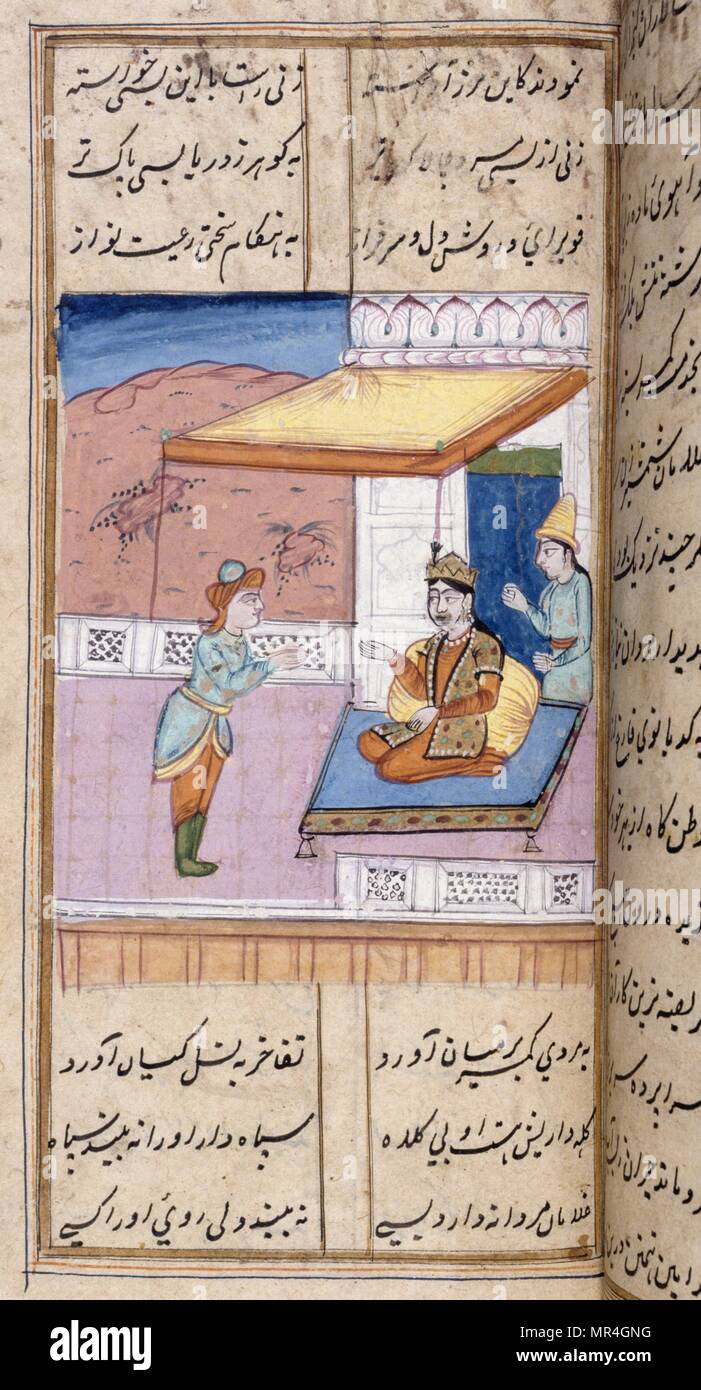 Persian (Iranian) Islamic style, manuscript, Illustrated 12th century: The poet Nezami recounts the tales of Alexander the great Stock Photohttps://www.alamy.com/image-license-details/?v=1https://www.alamy.com/persian-iranian-islamic-style-manuscript-illustrated-12th-century-the-poet-nezami-recounts-the-tales-of-alexander-the-great-image186341724.html
Persian (Iranian) Islamic style, manuscript, Illustrated 12th century: The poet Nezami recounts the tales of Alexander the great Stock Photohttps://www.alamy.com/image-license-details/?v=1https://www.alamy.com/persian-iranian-islamic-style-manuscript-illustrated-12th-century-the-poet-nezami-recounts-the-tales-of-alexander-the-great-image186341724.htmlRMMR4GNG–Persian (Iranian) Islamic style, manuscript, Illustrated 12th century: The poet Nezami recounts the tales of Alexander the great
 Islamic Medical Encyclopedia Epitomes Manuscript Stock Photohttps://www.alamy.com/image-license-details/?v=1https://www.alamy.com/stock-photo-islamic-medical-encyclopedia-epitomes-manuscript-135089340.html
Islamic Medical Encyclopedia Epitomes Manuscript Stock Photohttps://www.alamy.com/image-license-details/?v=1https://www.alamy.com/stock-photo-islamic-medical-encyclopedia-epitomes-manuscript-135089340.htmlRMHRNRR8–Islamic Medical Encyclopedia Epitomes Manuscript
 Council of Acre and the Siege of Damascus, 1147-1148 (late 12th century) Artist: Unknown Stock Photohttps://www.alamy.com/image-license-details/?v=1https://www.alamy.com/council-of-acre-and-the-siege-of-damascus-1147-1148-late-12th-century-image8371221.html
Council of Acre and the Siege of Damascus, 1147-1148 (late 12th century) Artist: Unknown Stock Photohttps://www.alamy.com/image-license-details/?v=1https://www.alamy.com/council-of-acre-and-the-siege-of-damascus-1147-1148-late-12th-century-image8371221.htmlRMAJ7PW6–Council of Acre and the Siege of Damascus, 1147-1148 (late 12th century) Artist: Unknown
 Chapter Heading for Chapter 26 (Surat al-shu'ara'). English: This folio from Walters manuscript W.555 contains a chapter heading executed in gold ink with a red outline, from which extends a small palmette outlined in red and blue. . 5th century AH/AD 11th century-6th century AH/AD 12th century (Abbasid period (750-1258)). 676 Islamic - Chapter Heading for Chapter 26 (Surat al-shu'ara') - Walters W55518B - Full Page Stock Photohttps://www.alamy.com/image-license-details/?v=1https://www.alamy.com/chapter-heading-for-chapter-26-surat-al-shuara-english-this-folio-from-walters-manuscript-w555-contains-a-chapter-heading-executed-in-gold-ink-with-a-red-outline-from-which-extends-a-small-palmette-outlined-in-red-and-blue-5th-century-ahad-11th-century-6th-century-ahad-12th-century-abbasid-period-750-1258-676-islamic-chapter-heading-for-chapter-26-surat-al-shuara-walters-w55518b-full-page-image185791692.html
Chapter Heading for Chapter 26 (Surat al-shu'ara'). English: This folio from Walters manuscript W.555 contains a chapter heading executed in gold ink with a red outline, from which extends a small palmette outlined in red and blue. . 5th century AH/AD 11th century-6th century AH/AD 12th century (Abbasid period (750-1258)). 676 Islamic - Chapter Heading for Chapter 26 (Surat al-shu'ara') - Walters W55518B - Full Page Stock Photohttps://www.alamy.com/image-license-details/?v=1https://www.alamy.com/chapter-heading-for-chapter-26-surat-al-shuara-english-this-folio-from-walters-manuscript-w555-contains-a-chapter-heading-executed-in-gold-ink-with-a-red-outline-from-which-extends-a-small-palmette-outlined-in-red-and-blue-5th-century-ahad-11th-century-6th-century-ahad-12th-century-abbasid-period-750-1258-676-islamic-chapter-heading-for-chapter-26-surat-al-shuara-walters-w55518b-full-page-image185791692.htmlRMMP7F5G–Chapter Heading for Chapter 26 (Surat al-shu'ara'). English: This folio from Walters manuscript W.555 contains a chapter heading executed in gold ink with a red outline, from which extends a small palmette outlined in red and blue. . 5th century AH/AD 11th century-6th century AH/AD 12th century (Abbasid period (750-1258)). 676 Islamic - Chapter Heading for Chapter 26 (Surat al-shu'ara') - Walters W55518B - Full Page
 Abraham, c1100, (1849). Creator: Walter. Stock Photohttps://www.alamy.com/image-license-details/?v=1https://www.alamy.com/abraham-c1100-1849-creator-walter-image236012518.html
Abraham, c1100, (1849). Creator: Walter. Stock Photohttps://www.alamy.com/image-license-details/?v=1https://www.alamy.com/abraham-c1100-1849-creator-walter-image236012518.htmlRMRKY8AE–Abraham, c1100, (1849). Creator: Walter.
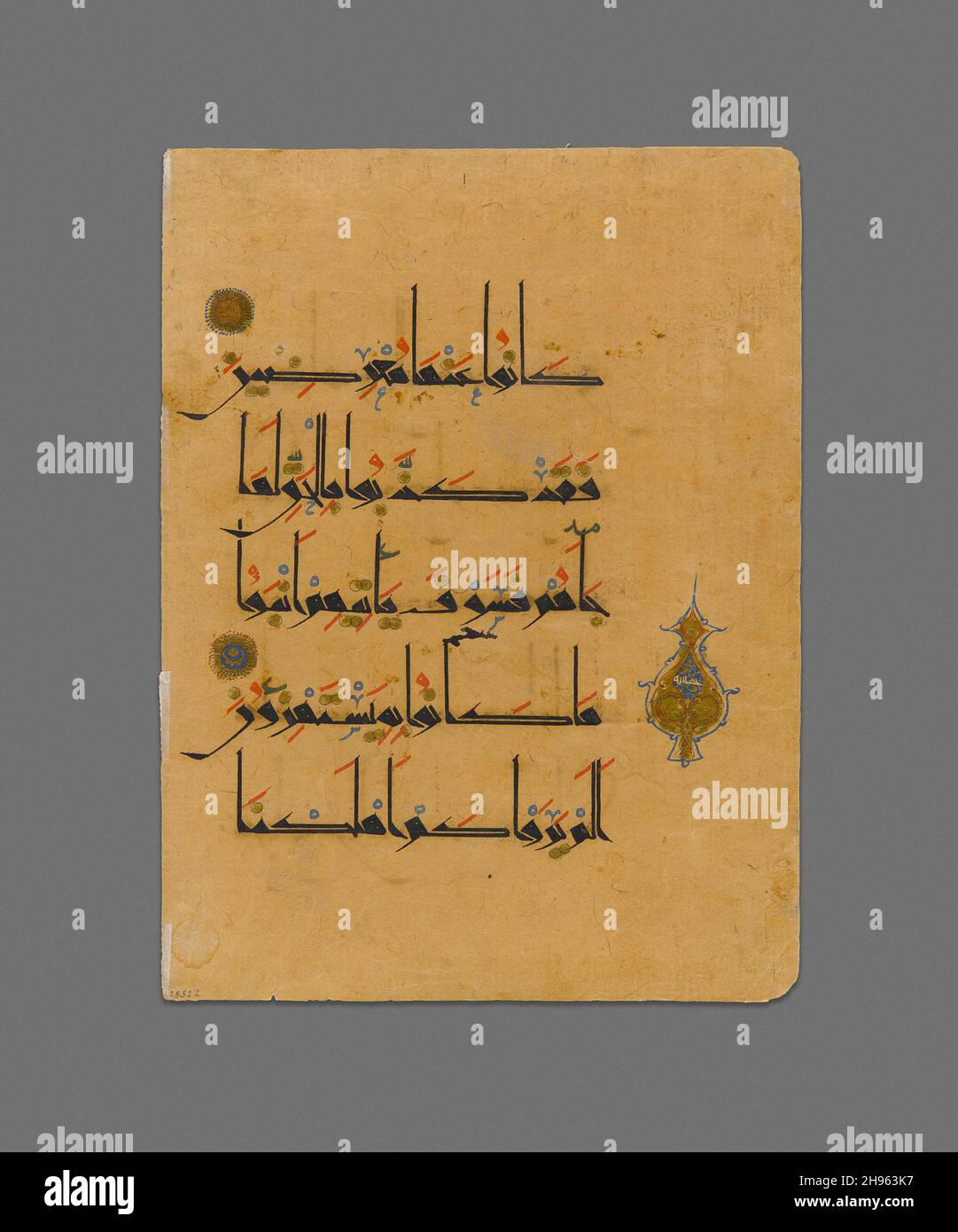 Qur'an Manuscript, 11th/12th century. Stock Photohttps://www.alamy.com/image-license-details/?v=1https://www.alamy.com/quran-manuscript-11th12th-century-image453136075.html
Qur'an Manuscript, 11th/12th century. Stock Photohttps://www.alamy.com/image-license-details/?v=1https://www.alamy.com/quran-manuscript-11th12th-century-image453136075.htmlRM2H963K7–Qur'an Manuscript, 11th/12th century.
 John Skylitzes. Synopsis of Histories. War with the Arabs. Codex of the 12th century. National Library. Madrid. Spain. Stock Photohttps://www.alamy.com/image-license-details/?v=1https://www.alamy.com/john-skylitzes-synopsis-of-histories-war-with-the-arabs-codex-of-the-12th-century-national-library-madrid-spain-image209570321.html
John Skylitzes. Synopsis of Histories. War with the Arabs. Codex of the 12th century. National Library. Madrid. Spain. Stock Photohttps://www.alamy.com/image-license-details/?v=1https://www.alamy.com/john-skylitzes-synopsis-of-histories-war-with-the-arabs-codex-of-the-12th-century-national-library-madrid-spain-image209570321.htmlRMP4XN29–John Skylitzes. Synopsis of Histories. War with the Arabs. Codex of the 12th century. National Library. Madrid. Spain.
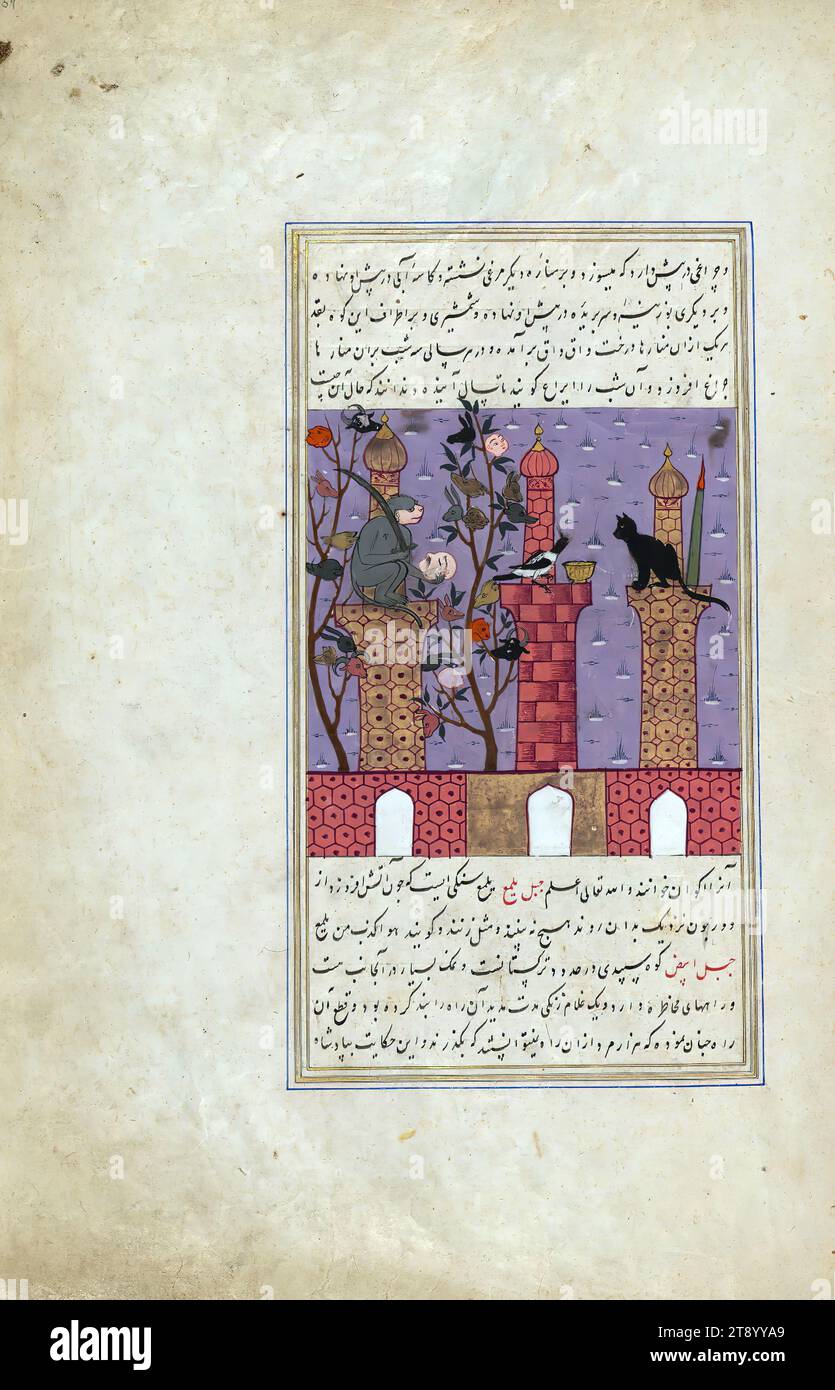 Wonders of creation, Lighthouses with a cat, a monkey, and the heads of animals and humans, A Persian version of the famous 'Wonders of creation' (ʿAjā’ib al-makhlūqāt) by Zakariyāʾ al-Qazwīnī (d. 682 AH / 1283 CE). Composed by Shams al-Dīn Muḥammad al-Ṭūsī (fl. 6th century AH /12th CE), this manuscript, which may have been copied by an Iranian scribe, was illustrated with 181 miniatures (including a double-page map of the world) by several artists probably in Turkey in the 10th century AH / 16th CE Stock Photohttps://www.alamy.com/image-license-details/?v=1https://www.alamy.com/wonders-of-creation-lighthouses-with-a-cat-a-monkey-and-the-heads-of-animals-and-humans-a-persian-version-of-the-famous-wonders-of-creation-ajib-al-makhlqt-by-zakariy-al-qazwn-d-682-ah-1283-ce-composed-by-shams-al-dn-muammad-al-s-fl-6th-century-ah-12th-ce-this-manuscript-which-may-have-been-copied-by-an-iranian-scribe-was-illustrated-with-181-miniatures-including-a-double-page-map-of-the-world-by-several-artists-probably-in-turkey-in-the-10th-century-ah-16th-ce-image573473553.html
Wonders of creation, Lighthouses with a cat, a monkey, and the heads of animals and humans, A Persian version of the famous 'Wonders of creation' (ʿAjā’ib al-makhlūqāt) by Zakariyāʾ al-Qazwīnī (d. 682 AH / 1283 CE). Composed by Shams al-Dīn Muḥammad al-Ṭūsī (fl. 6th century AH /12th CE), this manuscript, which may have been copied by an Iranian scribe, was illustrated with 181 miniatures (including a double-page map of the world) by several artists probably in Turkey in the 10th century AH / 16th CE Stock Photohttps://www.alamy.com/image-license-details/?v=1https://www.alamy.com/wonders-of-creation-lighthouses-with-a-cat-a-monkey-and-the-heads-of-animals-and-humans-a-persian-version-of-the-famous-wonders-of-creation-ajib-al-makhlqt-by-zakariy-al-qazwn-d-682-ah-1283-ce-composed-by-shams-al-dn-muammad-al-s-fl-6th-century-ah-12th-ce-this-manuscript-which-may-have-been-copied-by-an-iranian-scribe-was-illustrated-with-181-miniatures-including-a-double-page-map-of-the-world-by-several-artists-probably-in-turkey-in-the-10th-century-ah-16th-ce-image573473553.htmlRM2T8YYA9–Wonders of creation, Lighthouses with a cat, a monkey, and the heads of animals and humans, A Persian version of the famous 'Wonders of creation' (ʿAjā’ib al-makhlūqāt) by Zakariyāʾ al-Qazwīnī (d. 682 AH / 1283 CE). Composed by Shams al-Dīn Muḥammad al-Ṭūsī (fl. 6th century AH /12th CE), this manuscript, which may have been copied by an Iranian scribe, was illustrated with 181 miniatures (including a double-page map of the world) by several artists probably in Turkey in the 10th century AH / 16th CE
 Persian (Iranian) Islamic style, manuscript, Illustrated 12th century: The poet Nezami recounts the tales of Alexander the great Stock Photohttps://www.alamy.com/image-license-details/?v=1https://www.alamy.com/persian-iranian-islamic-style-manuscript-illustrated-12th-century-the-poet-nezami-recounts-the-tales-of-alexander-the-great-image186341707.html
Persian (Iranian) Islamic style, manuscript, Illustrated 12th century: The poet Nezami recounts the tales of Alexander the great Stock Photohttps://www.alamy.com/image-license-details/?v=1https://www.alamy.com/persian-iranian-islamic-style-manuscript-illustrated-12th-century-the-poet-nezami-recounts-the-tales-of-alexander-the-great-image186341707.htmlRMMR4GMY–Persian (Iranian) Islamic style, manuscript, Illustrated 12th century: The poet Nezami recounts the tales of Alexander the great
 Shudhur al-dhahab, Islamic Alchemy Manuscript, 12th Century Stock Photohttps://www.alamy.com/image-license-details/?v=1https://www.alamy.com/stock-photo-shudhur-al-dhahab-islamic-alchemy-manuscript-12th-century-135089331.html
Shudhur al-dhahab, Islamic Alchemy Manuscript, 12th Century Stock Photohttps://www.alamy.com/image-license-details/?v=1https://www.alamy.com/stock-photo-shudhur-al-dhahab-islamic-alchemy-manuscript-12th-century-135089331.htmlRMHRNRPY–Shudhur al-dhahab, Islamic Alchemy Manuscript, 12th Century
 Text Page with Marginal Illumination. English: The first marginal form on this folio from Walters manuscript W.555 indicates verse 60 of chapter 25 (Surat al-furqan), and the second, in the form of a six-pointed star, indicates prostration (sajdah). The star is painted in black, red, and blue. . 5th century AH/AD 11th century-6th century AH/AD 12th century (Abbasid period (750-1258)). 676 Islamic - Text Page with Marginal Illumination - Walters W55512B - Full Page Stock Photohttps://www.alamy.com/image-license-details/?v=1https://www.alamy.com/text-page-with-marginal-illumination-english-the-first-marginal-form-on-this-folio-from-walters-manuscript-w555-indicates-verse-60-of-chapter-25-surat-al-furqan-and-the-second-in-the-form-of-a-six-pointed-star-indicates-prostration-sajdah-the-star-is-painted-in-black-red-and-blue-5th-century-ahad-11th-century-6th-century-ahad-12th-century-abbasid-period-750-1258-676-islamic-text-page-with-marginal-illumination-walters-w55512b-full-page-image185791745.html
Text Page with Marginal Illumination. English: The first marginal form on this folio from Walters manuscript W.555 indicates verse 60 of chapter 25 (Surat al-furqan), and the second, in the form of a six-pointed star, indicates prostration (sajdah). The star is painted in black, red, and blue. . 5th century AH/AD 11th century-6th century AH/AD 12th century (Abbasid period (750-1258)). 676 Islamic - Text Page with Marginal Illumination - Walters W55512B - Full Page Stock Photohttps://www.alamy.com/image-license-details/?v=1https://www.alamy.com/text-page-with-marginal-illumination-english-the-first-marginal-form-on-this-folio-from-walters-manuscript-w555-indicates-verse-60-of-chapter-25-surat-al-furqan-and-the-second-in-the-form-of-a-six-pointed-star-indicates-prostration-sajdah-the-star-is-painted-in-black-red-and-blue-5th-century-ahad-11th-century-6th-century-ahad-12th-century-abbasid-period-750-1258-676-islamic-text-page-with-marginal-illumination-walters-w55512b-full-page-image185791745.htmlRMMP7F7D–Text Page with Marginal Illumination. English: The first marginal form on this folio from Walters manuscript W.555 indicates verse 60 of chapter 25 (Surat al-furqan), and the second, in the form of a six-pointed star, indicates prostration (sajdah). The star is painted in black, red, and blue. . 5th century AH/AD 11th century-6th century AH/AD 12th century (Abbasid period (750-1258)). 676 Islamic - Text Page with Marginal Illumination - Walters W55512B - Full Page
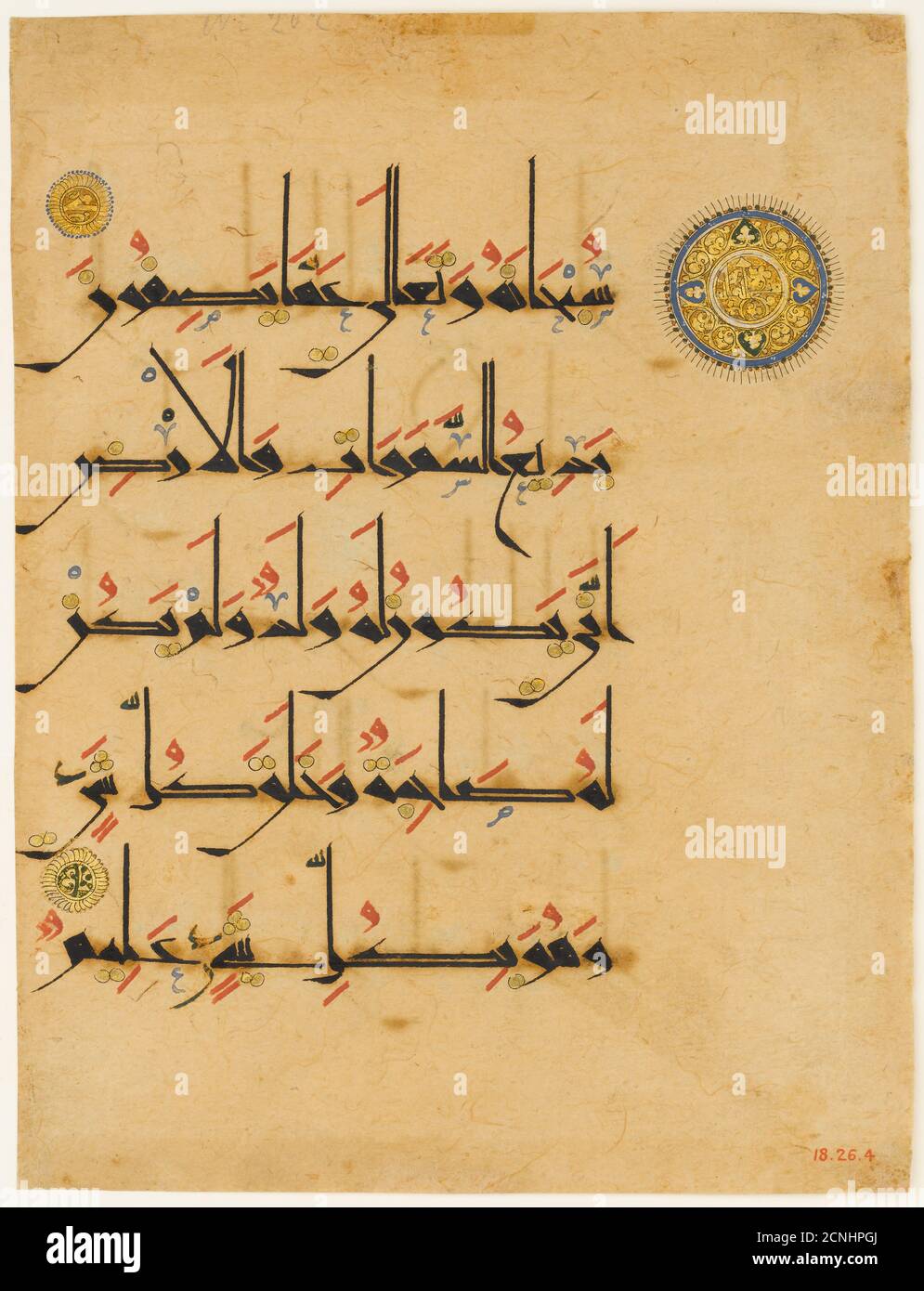 Folio from a Qur'an Manuscript, late 11th-12th century. Stock Photohttps://www.alamy.com/image-license-details/?v=1https://www.alamy.com/folio-from-a-quran-manuscript-late-11th-12th-century-image374716402.html
Folio from a Qur'an Manuscript, late 11th-12th century. Stock Photohttps://www.alamy.com/image-license-details/?v=1https://www.alamy.com/folio-from-a-quran-manuscript-late-11th-12th-century-image374716402.htmlRM2CNHPGJ–Folio from a Qur'an Manuscript, late 11th-12th century.
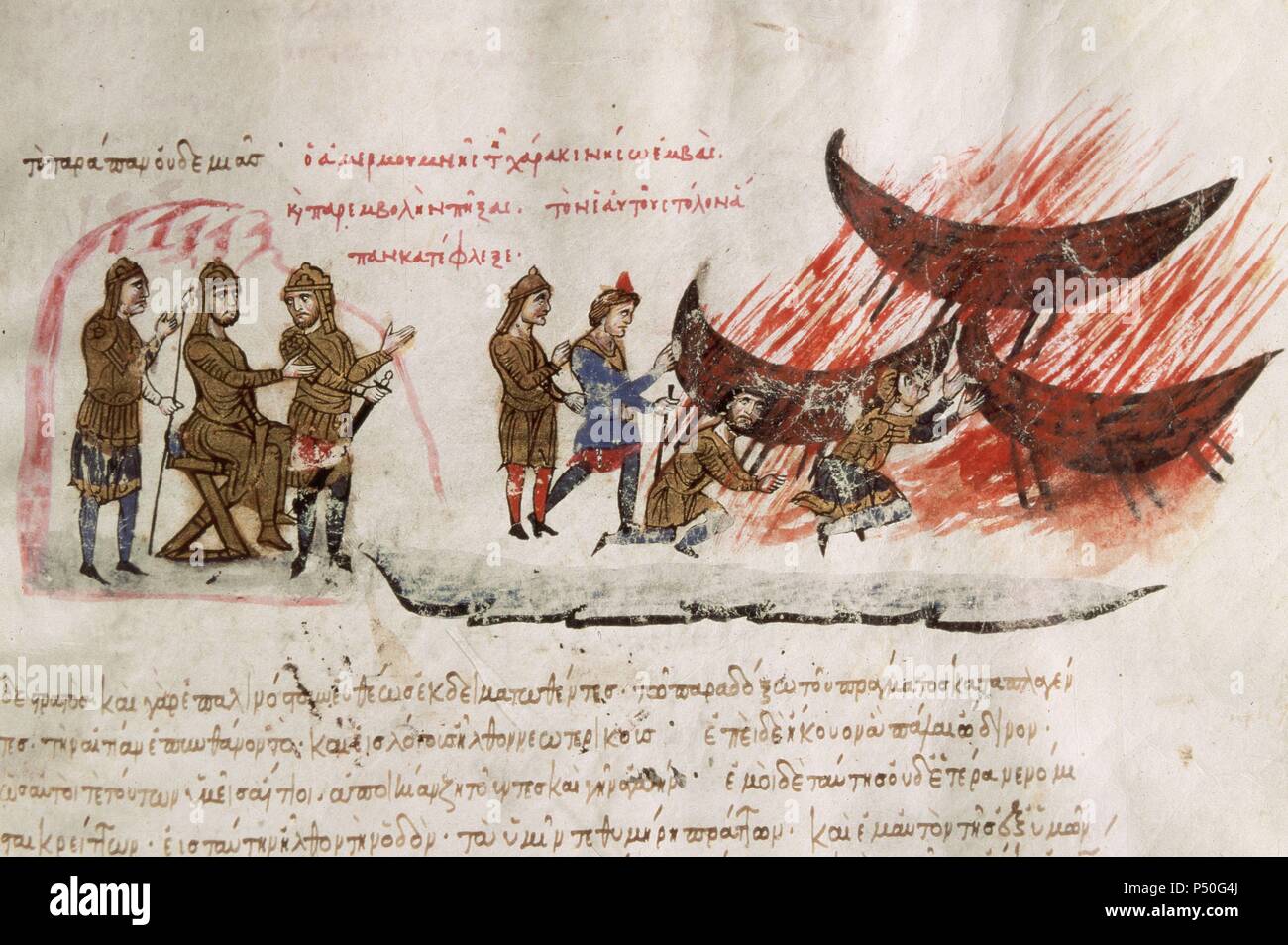 John Skylitzes. Synopsis of Histories. The Saracens landed in Crete. Codex of the 12th century. National Library. Madrid. Spain. Stock Photohttps://www.alamy.com/image-license-details/?v=1https://www.alamy.com/john-skylitzes-synopsis-of-histories-the-saracens-landed-in-crete-codex-of-the-12th-century-national-library-madrid-spain-image209610370.html
John Skylitzes. Synopsis of Histories. The Saracens landed in Crete. Codex of the 12th century. National Library. Madrid. Spain. Stock Photohttps://www.alamy.com/image-license-details/?v=1https://www.alamy.com/john-skylitzes-synopsis-of-histories-the-saracens-landed-in-crete-codex-of-the-12th-century-national-library-madrid-spain-image209610370.htmlRMP50G4J–John Skylitzes. Synopsis of Histories. The Saracens landed in Crete. Codex of the 12th century. National Library. Madrid. Spain.
 Wonders of creation, A king on horseback at a spring near Bāmiyān, A Persian version of the famous 'Wonders of creation' (ʿAjā’ib al-makhlūqāt) by Zakariyāʾ al-Qazwīnī (d. 682 AH / 1283 CE). Composed by Shams al-Dīn Muḥammad al-Ṭūsī (fl. 6th century AH /12th CE), this manuscript, which may have been copied by an Iranian scribe, was illustrated with 181 miniatures (including a double-page map of the world) by several artists probably in Turkey in the 10th century AH / 16th CE Stock Photohttps://www.alamy.com/image-license-details/?v=1https://www.alamy.com/wonders-of-creation-a-king-on-horseback-at-a-spring-near-bmiyn-a-persian-version-of-the-famous-wonders-of-creation-ajib-al-makhlqt-by-zakariy-al-qazwn-d-682-ah-1283-ce-composed-by-shams-al-dn-muammad-al-s-fl-6th-century-ah-12th-ce-this-manuscript-which-may-have-been-copied-by-an-iranian-scribe-was-illustrated-with-181-miniatures-including-a-double-page-map-of-the-world-by-several-artists-probably-in-turkey-in-the-10th-century-ah-16th-ce-image573473546.html
Wonders of creation, A king on horseback at a spring near Bāmiyān, A Persian version of the famous 'Wonders of creation' (ʿAjā’ib al-makhlūqāt) by Zakariyāʾ al-Qazwīnī (d. 682 AH / 1283 CE). Composed by Shams al-Dīn Muḥammad al-Ṭūsī (fl. 6th century AH /12th CE), this manuscript, which may have been copied by an Iranian scribe, was illustrated with 181 miniatures (including a double-page map of the world) by several artists probably in Turkey in the 10th century AH / 16th CE Stock Photohttps://www.alamy.com/image-license-details/?v=1https://www.alamy.com/wonders-of-creation-a-king-on-horseback-at-a-spring-near-bmiyn-a-persian-version-of-the-famous-wonders-of-creation-ajib-al-makhlqt-by-zakariy-al-qazwn-d-682-ah-1283-ce-composed-by-shams-al-dn-muammad-al-s-fl-6th-century-ah-12th-ce-this-manuscript-which-may-have-been-copied-by-an-iranian-scribe-was-illustrated-with-181-miniatures-including-a-double-page-map-of-the-world-by-several-artists-probably-in-turkey-in-the-10th-century-ah-16th-ce-image573473546.htmlRM2T8YYA2–Wonders of creation, A king on horseback at a spring near Bāmiyān, A Persian version of the famous 'Wonders of creation' (ʿAjā’ib al-makhlūqāt) by Zakariyāʾ al-Qazwīnī (d. 682 AH / 1283 CE). Composed by Shams al-Dīn Muḥammad al-Ṭūsī (fl. 6th century AH /12th CE), this manuscript, which may have been copied by an Iranian scribe, was illustrated with 181 miniatures (including a double-page map of the world) by several artists probably in Turkey in the 10th century AH / 16th CE
 Persian (Iranian) Islamic style, manuscript, Illustrated 12th century: The poet Nezami recounts the tales of Alexander the great Stock Photohttps://www.alamy.com/image-license-details/?v=1https://www.alamy.com/persian-iranian-islamic-style-manuscript-illustrated-12th-century-the-poet-nezami-recounts-the-tales-of-alexander-the-great-image186341719.html
Persian (Iranian) Islamic style, manuscript, Illustrated 12th century: The poet Nezami recounts the tales of Alexander the great Stock Photohttps://www.alamy.com/image-license-details/?v=1https://www.alamy.com/persian-iranian-islamic-style-manuscript-illustrated-12th-century-the-poet-nezami-recounts-the-tales-of-alexander-the-great-image186341719.htmlRMMR4GNB–Persian (Iranian) Islamic style, manuscript, Illustrated 12th century: The poet Nezami recounts the tales of Alexander the great
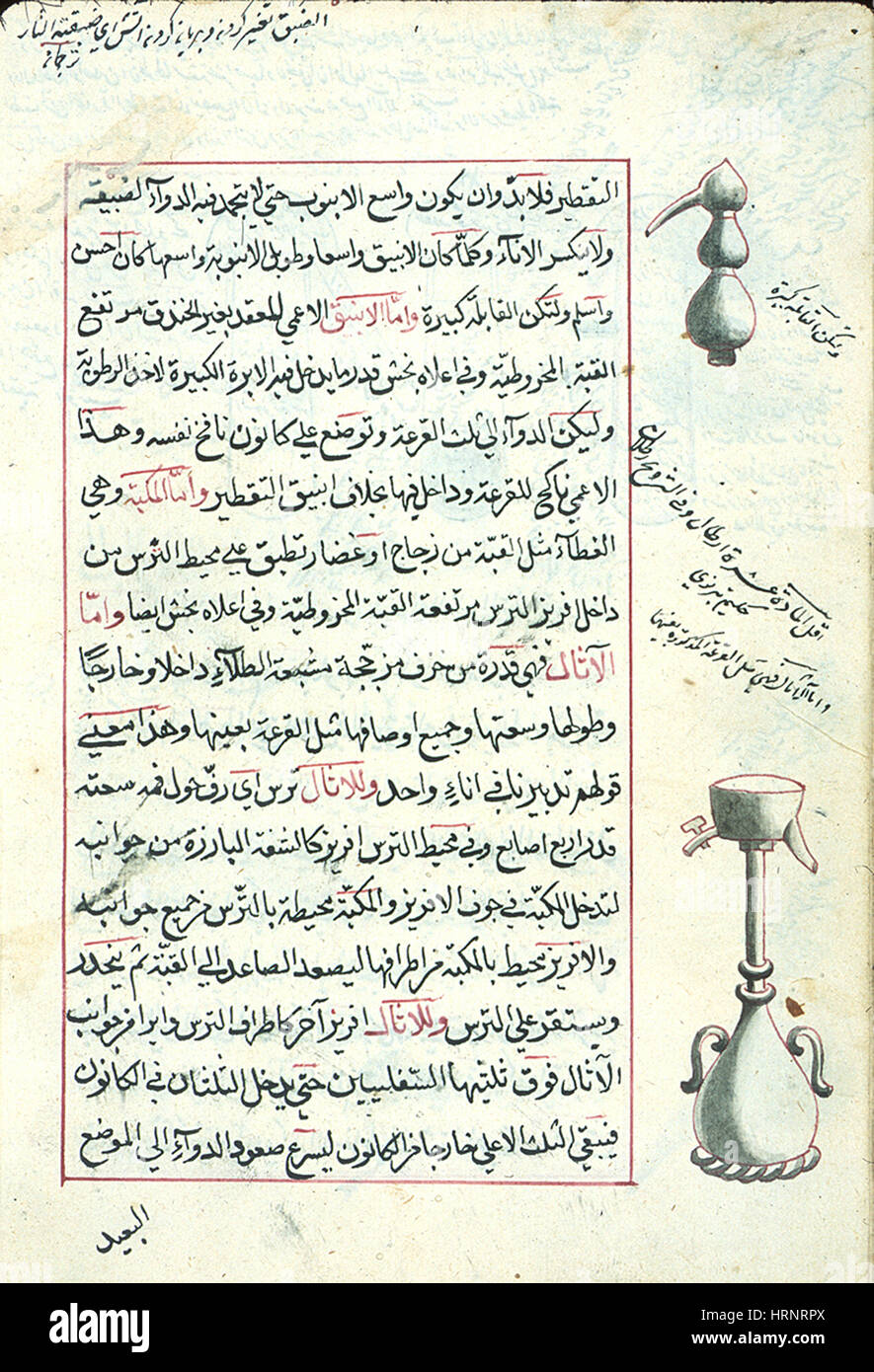 Shudhur al-dhahab, Islamic Alchemy Manuscript, 12th Century Stock Photohttps://www.alamy.com/image-license-details/?v=1https://www.alamy.com/stock-photo-shudhur-al-dhahab-islamic-alchemy-manuscript-12th-century-135089330.html
Shudhur al-dhahab, Islamic Alchemy Manuscript, 12th Century Stock Photohttps://www.alamy.com/image-license-details/?v=1https://www.alamy.com/stock-photo-shudhur-al-dhahab-islamic-alchemy-manuscript-12th-century-135089330.htmlRMHRNRPX–Shudhur al-dhahab, Islamic Alchemy Manuscript, 12th Century
 Folio from a Qur'an Manuscript, late 12th-early 13th century. Stock Photohttps://www.alamy.com/image-license-details/?v=1https://www.alamy.com/folio-from-a-quran-manuscript-late-12th-early-13th-century-image374716423.html
Folio from a Qur'an Manuscript, late 12th-early 13th century. Stock Photohttps://www.alamy.com/image-license-details/?v=1https://www.alamy.com/folio-from-a-quran-manuscript-late-12th-early-13th-century-image374716423.htmlRM2CNHPHB–Folio from a Qur'an Manuscript, late 12th-early 13th century.
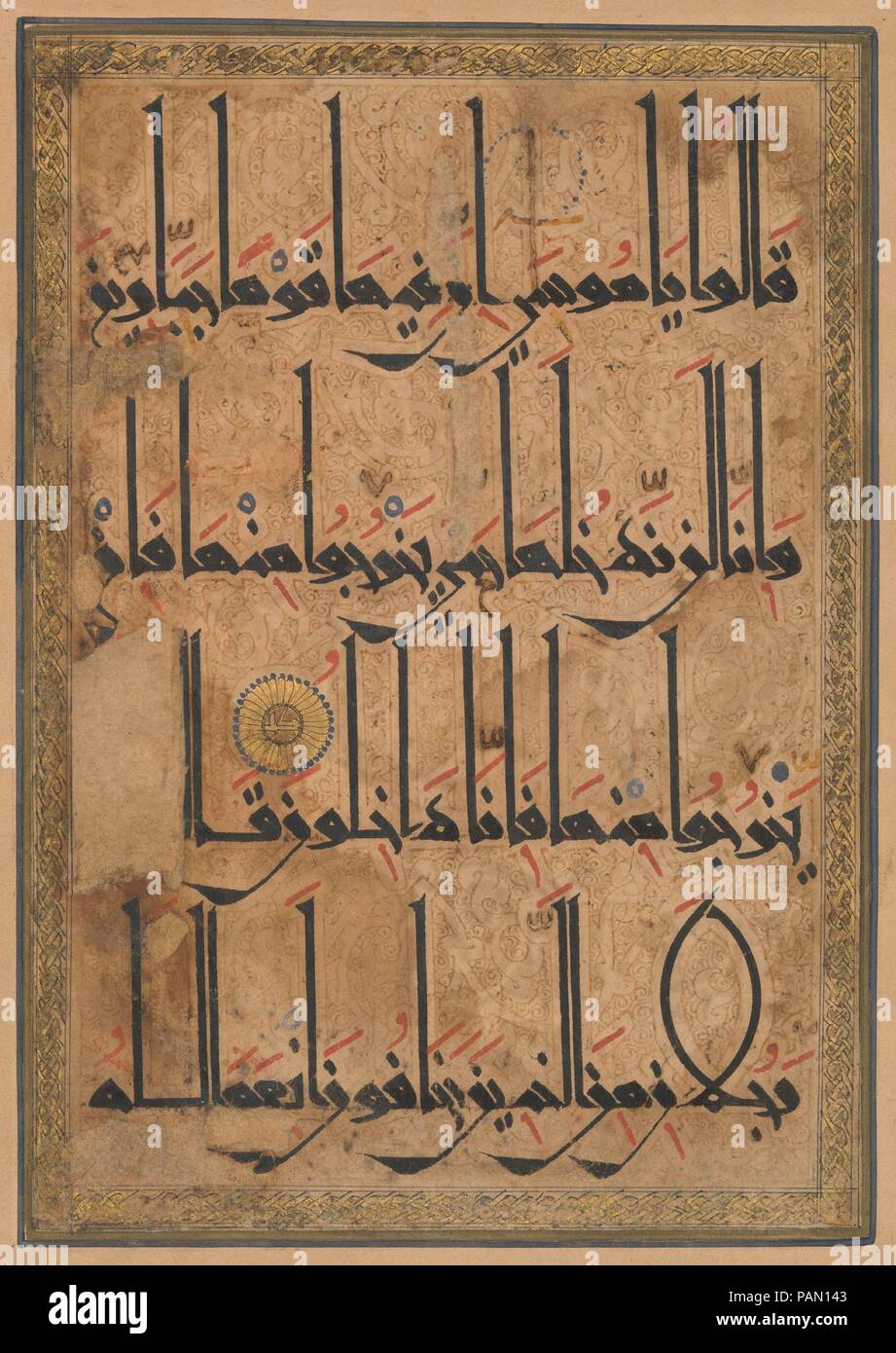 Folio from a Qur'an Manuscript. Dimensions: H. 11 3/4 in. (29.8 cm) W. 8 3/4 in. (22.2 cm). Date: ca. 1180. These folios from a dispersed Qur'an exemplify the transition during the Seljuq period from Qur'ans written in kufic script on parchment to those copied in the more rounded new-style writing on paper. By the late twelfth century, the practitioners of the new style had perfected its mannered, slightly eccentric forms. As seen here, these include the extreme elongation of tall letters and the ellipse formed by combining two of these letters, lam and alif. Museum: Metropolitan Museum of Stock Photohttps://www.alamy.com/image-license-details/?v=1https://www.alamy.com/folio-from-a-quran-manuscript-dimensions-h-11-34-in-298-cm-w-8-34-in-222-cm-date-ca-1180-these-folios-from-a-dispersed-quran-exemplify-the-transition-during-the-seljuq-period-from-qurans-written-in-kufic-script-on-parchment-to-those-copied-in-the-more-rounded-new-style-writing-on-paper-by-the-late-twelfth-century-the-practitioners-of-the-new-style-had-perfected-its-mannered-slightly-eccentric-forms-as-seen-here-these-include-the-extreme-elongation-of-tall-letters-and-the-ellipse-formed-by-combining-two-of-these-letters-lam-and-alif-museum-metropolitan-museum-of-image213132867.html
Folio from a Qur'an Manuscript. Dimensions: H. 11 3/4 in. (29.8 cm) W. 8 3/4 in. (22.2 cm). Date: ca. 1180. These folios from a dispersed Qur'an exemplify the transition during the Seljuq period from Qur'ans written in kufic script on parchment to those copied in the more rounded new-style writing on paper. By the late twelfth century, the practitioners of the new style had perfected its mannered, slightly eccentric forms. As seen here, these include the extreme elongation of tall letters and the ellipse formed by combining two of these letters, lam and alif. Museum: Metropolitan Museum of Stock Photohttps://www.alamy.com/image-license-details/?v=1https://www.alamy.com/folio-from-a-quran-manuscript-dimensions-h-11-34-in-298-cm-w-8-34-in-222-cm-date-ca-1180-these-folios-from-a-dispersed-quran-exemplify-the-transition-during-the-seljuq-period-from-qurans-written-in-kufic-script-on-parchment-to-those-copied-in-the-more-rounded-new-style-writing-on-paper-by-the-late-twelfth-century-the-practitioners-of-the-new-style-had-perfected-its-mannered-slightly-eccentric-forms-as-seen-here-these-include-the-extreme-elongation-of-tall-letters-and-the-ellipse-formed-by-combining-two-of-these-letters-lam-and-alif-museum-metropolitan-museum-of-image213132867.htmlRMPAN143–Folio from a Qur'an Manuscript. Dimensions: H. 11 3/4 in. (29.8 cm) W. 8 3/4 in. (22.2 cm). Date: ca. 1180. These folios from a dispersed Qur'an exemplify the transition during the Seljuq period from Qur'ans written in kufic script on parchment to those copied in the more rounded new-style writing on paper. By the late twelfth century, the practitioners of the new style had perfected its mannered, slightly eccentric forms. As seen here, these include the extreme elongation of tall letters and the ellipse formed by combining two of these letters, lam and alif. Museum: Metropolitan Museum of
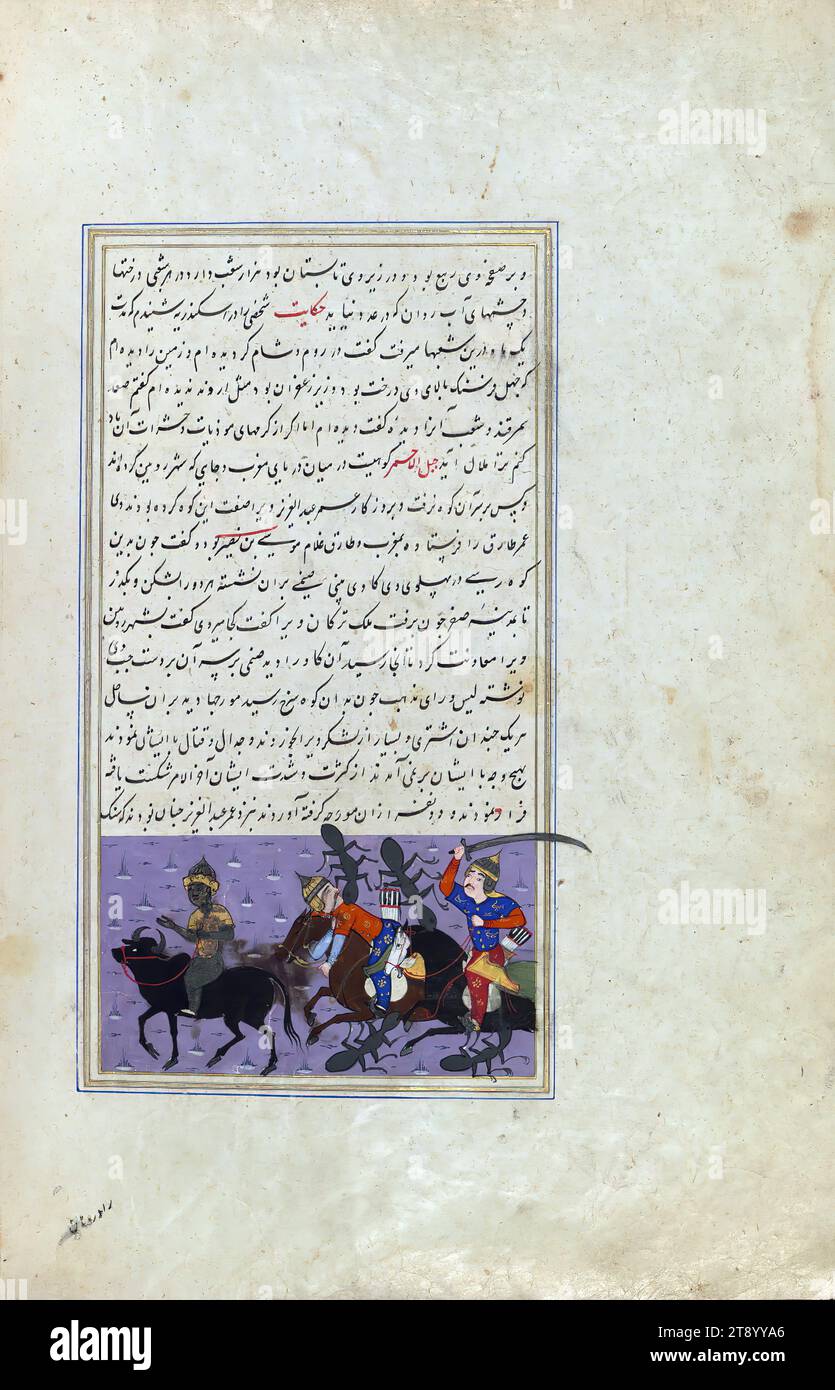 Wonders of creation, Warriors on horseback fight enormous ants at Jabal al-aḥmar, A Persian version of the famous 'Wonders of creation' (ʿAjā’ib al-makhlūqāt) by Zakariyāʾ al-Qazwīnī (d. 682 AH / 1283 CE). Composed by Shams al-Dīn Muḥammad al-Ṭūsī (fl. 6th century AH /12th CE), this manuscript, which may have been copied by an Iranian scribe, was illustrated with 181 miniatures (including a double-page map of the world) by several artists probably in Turkey in the 10th century AH / 16th CE Stock Photohttps://www.alamy.com/image-license-details/?v=1https://www.alamy.com/wonders-of-creation-warriors-on-horseback-fight-enormous-ants-at-jabal-al-amar-a-persian-version-of-the-famous-wonders-of-creation-ajib-al-makhlqt-by-zakariy-al-qazwn-d-682-ah-1283-ce-composed-by-shams-al-dn-muammad-al-s-fl-6th-century-ah-12th-ce-this-manuscript-which-may-have-been-copied-by-an-iranian-scribe-was-illustrated-with-181-miniatures-including-a-double-page-map-of-the-world-by-several-artists-probably-in-turkey-in-the-10th-century-ah-16th-ce-image573473550.html
Wonders of creation, Warriors on horseback fight enormous ants at Jabal al-aḥmar, A Persian version of the famous 'Wonders of creation' (ʿAjā’ib al-makhlūqāt) by Zakariyāʾ al-Qazwīnī (d. 682 AH / 1283 CE). Composed by Shams al-Dīn Muḥammad al-Ṭūsī (fl. 6th century AH /12th CE), this manuscript, which may have been copied by an Iranian scribe, was illustrated with 181 miniatures (including a double-page map of the world) by several artists probably in Turkey in the 10th century AH / 16th CE Stock Photohttps://www.alamy.com/image-license-details/?v=1https://www.alamy.com/wonders-of-creation-warriors-on-horseback-fight-enormous-ants-at-jabal-al-amar-a-persian-version-of-the-famous-wonders-of-creation-ajib-al-makhlqt-by-zakariy-al-qazwn-d-682-ah-1283-ce-composed-by-shams-al-dn-muammad-al-s-fl-6th-century-ah-12th-ce-this-manuscript-which-may-have-been-copied-by-an-iranian-scribe-was-illustrated-with-181-miniatures-including-a-double-page-map-of-the-world-by-several-artists-probably-in-turkey-in-the-10th-century-ah-16th-ce-image573473550.htmlRM2T8YYA6–Wonders of creation, Warriors on horseback fight enormous ants at Jabal al-aḥmar, A Persian version of the famous 'Wonders of creation' (ʿAjā’ib al-makhlūqāt) by Zakariyāʾ al-Qazwīnī (d. 682 AH / 1283 CE). Composed by Shams al-Dīn Muḥammad al-Ṭūsī (fl. 6th century AH /12th CE), this manuscript, which may have been copied by an Iranian scribe, was illustrated with 181 miniatures (including a double-page map of the world) by several artists probably in Turkey in the 10th century AH / 16th CE
 Persian (Iranian) Islamic style, manuscript, Illustrated 12th century: The poet Nezami recounts the tales of Alexander the great Stock Photohttps://www.alamy.com/image-license-details/?v=1https://www.alamy.com/persian-iranian-islamic-style-manuscript-illustrated-12th-century-the-poet-nezami-recounts-the-tales-of-alexander-the-great-image186341715.html
Persian (Iranian) Islamic style, manuscript, Illustrated 12th century: The poet Nezami recounts the tales of Alexander the great Stock Photohttps://www.alamy.com/image-license-details/?v=1https://www.alamy.com/persian-iranian-islamic-style-manuscript-illustrated-12th-century-the-poet-nezami-recounts-the-tales-of-alexander-the-great-image186341715.htmlRMMR4GN7–Persian (Iranian) Islamic style, manuscript, Illustrated 12th century: The poet Nezami recounts the tales of Alexander the great
 Shudhur al-dhahab, Islamic Alchemy Manuscript, 12th Century Stock Photohttps://www.alamy.com/image-license-details/?v=1https://www.alamy.com/stock-photo-shudhur-al-dhahab-islamic-alchemy-manuscript-12th-century-135089329.html
Shudhur al-dhahab, Islamic Alchemy Manuscript, 12th Century Stock Photohttps://www.alamy.com/image-license-details/?v=1https://www.alamy.com/stock-photo-shudhur-al-dhahab-islamic-alchemy-manuscript-12th-century-135089329.htmlRMHRNRPW–Shudhur al-dhahab, Islamic Alchemy Manuscript, 12th Century
 Folio from a Qur'an Manuscript, late 12th-early 13th century. Stock Photohttps://www.alamy.com/image-license-details/?v=1https://www.alamy.com/folio-from-a-quran-manuscript-late-12th-early-13th-century-image374721943.html
Folio from a Qur'an Manuscript, late 12th-early 13th century. Stock Photohttps://www.alamy.com/image-license-details/?v=1https://www.alamy.com/folio-from-a-quran-manuscript-late-12th-early-13th-century-image374721943.htmlRM2CNJ1JF–Folio from a Qur'an Manuscript, late 12th-early 13th century.
 'General map of the known world', from the work 'Manuscript Pocock' (Recreation for people who w… Stock Photohttps://www.alamy.com/image-license-details/?v=1https://www.alamy.com/general-map-of-the-known-world-from-the-work-manuscript-pocock-recreation-for-people-who-w-image212421067.html
'General map of the known world', from the work 'Manuscript Pocock' (Recreation for people who w… Stock Photohttps://www.alamy.com/image-license-details/?v=1https://www.alamy.com/general-map-of-the-known-world-from-the-work-manuscript-pocock-recreation-for-people-who-w-image212421067.htmlRMP9GH6K–'General map of the known world', from the work 'Manuscript Pocock' (Recreation for people who w…
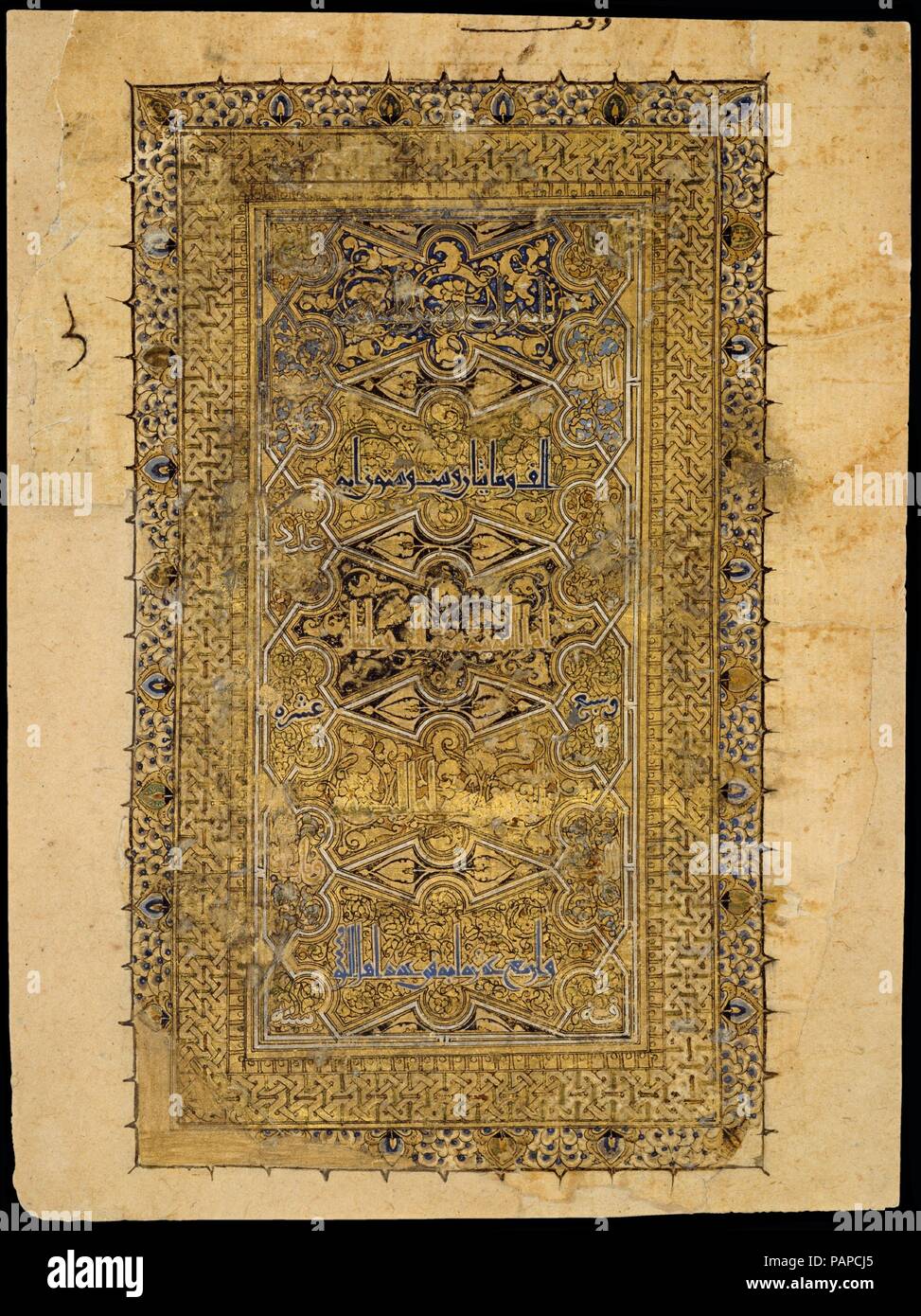 Folio from a Qur'an Manuscript. Calligrapher: Muhammad al-Zanjani. Dimensions: 10 1/8 x 7 1/2in. (25.7 x 19cm). Date: dated A.H. 531/ A.D. 1137. Eight folios of this dispersed Qur'an are held in the Museum collection. Among these folios is the colophon page, with the signature of the scribe Muhammad al-Zanjani from the town of Zanjan, in northwestern Iran, and the date of completion, A.H. 531/A.D. 1137. The text is written in the script known as eastern kufic with some elements in cursive (naskh), and is lavishly illuminated with designs of foliate scrolls and geometric interlace. Museum: Met Stock Photohttps://www.alamy.com/image-license-details/?v=1https://www.alamy.com/folio-from-a-quran-manuscript-calligrapher-muhammad-al-zanjani-dimensions-10-18-x-7-12in-257-x-19cm-date-dated-ah-531-ad-1137-eight-folios-of-this-dispersed-quran-are-held-in-the-museum-collection-among-these-folios-is-the-colophon-page-with-the-signature-of-the-scribe-muhammad-al-zanjani-from-the-town-of-zanjan-in-northwestern-iran-and-the-date-of-completion-ah-531ad-1137-the-text-is-written-in-the-script-known-as-eastern-kufic-with-some-elements-in-cursive-naskh-and-is-lavishly-illuminated-with-designs-of-foliate-scrolls-and-geometric-interlace-museum-met-image213163837.html
Folio from a Qur'an Manuscript. Calligrapher: Muhammad al-Zanjani. Dimensions: 10 1/8 x 7 1/2in. (25.7 x 19cm). Date: dated A.H. 531/ A.D. 1137. Eight folios of this dispersed Qur'an are held in the Museum collection. Among these folios is the colophon page, with the signature of the scribe Muhammad al-Zanjani from the town of Zanjan, in northwestern Iran, and the date of completion, A.H. 531/A.D. 1137. The text is written in the script known as eastern kufic with some elements in cursive (naskh), and is lavishly illuminated with designs of foliate scrolls and geometric interlace. Museum: Met Stock Photohttps://www.alamy.com/image-license-details/?v=1https://www.alamy.com/folio-from-a-quran-manuscript-calligrapher-muhammad-al-zanjani-dimensions-10-18-x-7-12in-257-x-19cm-date-dated-ah-531-ad-1137-eight-folios-of-this-dispersed-quran-are-held-in-the-museum-collection-among-these-folios-is-the-colophon-page-with-the-signature-of-the-scribe-muhammad-al-zanjani-from-the-town-of-zanjan-in-northwestern-iran-and-the-date-of-completion-ah-531ad-1137-the-text-is-written-in-the-script-known-as-eastern-kufic-with-some-elements-in-cursive-naskh-and-is-lavishly-illuminated-with-designs-of-foliate-scrolls-and-geometric-interlace-museum-met-image213163837.htmlRMPAPCJ5–Folio from a Qur'an Manuscript. Calligrapher: Muhammad al-Zanjani. Dimensions: 10 1/8 x 7 1/2in. (25.7 x 19cm). Date: dated A.H. 531/ A.D. 1137. Eight folios of this dispersed Qur'an are held in the Museum collection. Among these folios is the colophon page, with the signature of the scribe Muhammad al-Zanjani from the town of Zanjan, in northwestern Iran, and the date of completion, A.H. 531/A.D. 1137. The text is written in the script known as eastern kufic with some elements in cursive (naskh), and is lavishly illuminated with designs of foliate scrolls and geometric interlace. Museum: Met
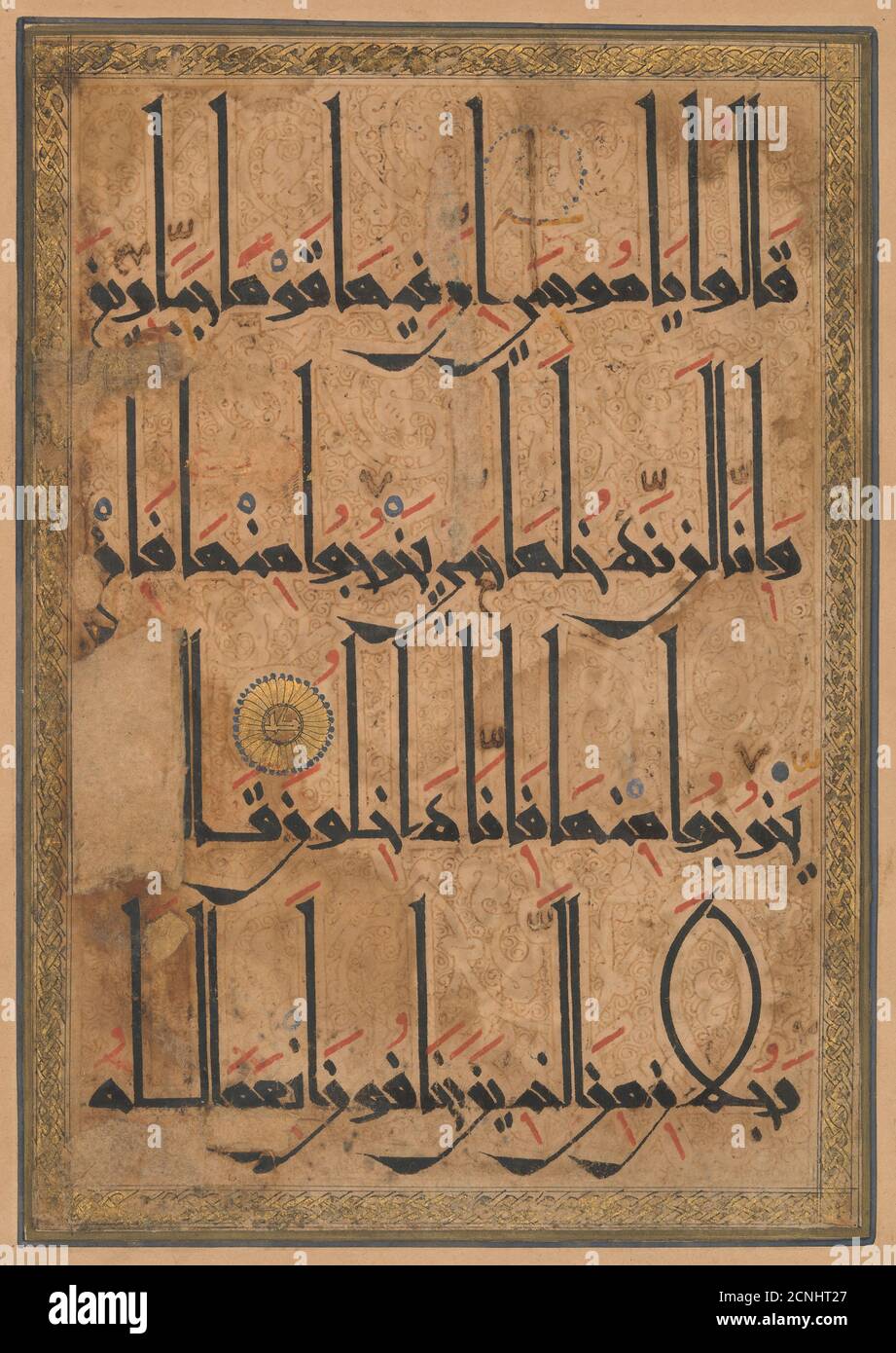 Folio from a Qur'an Manuscript, ca. 1180. Stock Photohttps://www.alamy.com/image-license-details/?v=1https://www.alamy.com/folio-from-a-quran-manuscript-ca-1180-image374717567.html
Folio from a Qur'an Manuscript, ca. 1180. Stock Photohttps://www.alamy.com/image-license-details/?v=1https://www.alamy.com/folio-from-a-quran-manuscript-ca-1180-image374717567.htmlRM2CNHT27–Folio from a Qur'an Manuscript, ca. 1180.
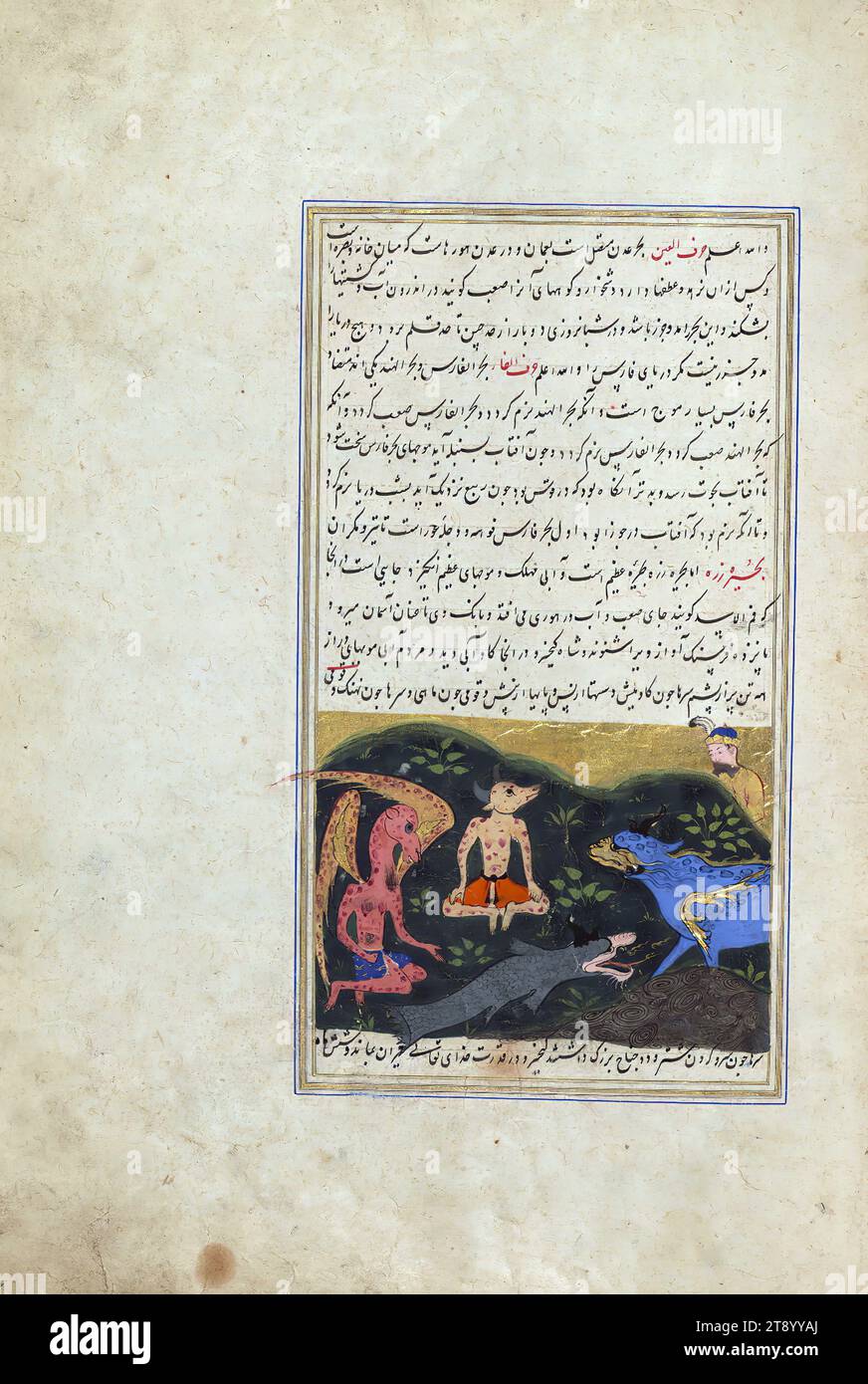 Wonders of creation, Kay Khusraw watches fabulous creatures in Lake Zarah, A Persian version of the famous 'Wonders of creation' (ʿAjā’ib al-makhlūqāt) by Zakariyāʾ al-Qazwīnī (d. 682 AH / 1283 CE). Composed by Shams al-Dīn Muḥammad al-Ṭūsī (fl. 6th century AH /12th CE), this manuscript, which may have been copied by an Iranian scribe, was illustrated with 181 miniatures (including a double-page map of the world) by several artists probably in Turkey in the 10th century AH / 16th CE Stock Photohttps://www.alamy.com/image-license-details/?v=1https://www.alamy.com/wonders-of-creation-kay-khusraw-watches-fabulous-creatures-in-lake-zarah-a-persian-version-of-the-famous-wonders-of-creation-ajib-al-makhlqt-by-zakariy-al-qazwn-d-682-ah-1283-ce-composed-by-shams-al-dn-muammad-al-s-fl-6th-century-ah-12th-ce-this-manuscript-which-may-have-been-copied-by-an-iranian-scribe-was-illustrated-with-181-miniatures-including-a-double-page-map-of-the-world-by-several-artists-probably-in-turkey-in-the-10th-century-ah-16th-ce-image573473562.html
Wonders of creation, Kay Khusraw watches fabulous creatures in Lake Zarah, A Persian version of the famous 'Wonders of creation' (ʿAjā’ib al-makhlūqāt) by Zakariyāʾ al-Qazwīnī (d. 682 AH / 1283 CE). Composed by Shams al-Dīn Muḥammad al-Ṭūsī (fl. 6th century AH /12th CE), this manuscript, which may have been copied by an Iranian scribe, was illustrated with 181 miniatures (including a double-page map of the world) by several artists probably in Turkey in the 10th century AH / 16th CE Stock Photohttps://www.alamy.com/image-license-details/?v=1https://www.alamy.com/wonders-of-creation-kay-khusraw-watches-fabulous-creatures-in-lake-zarah-a-persian-version-of-the-famous-wonders-of-creation-ajib-al-makhlqt-by-zakariy-al-qazwn-d-682-ah-1283-ce-composed-by-shams-al-dn-muammad-al-s-fl-6th-century-ah-12th-ce-this-manuscript-which-may-have-been-copied-by-an-iranian-scribe-was-illustrated-with-181-miniatures-including-a-double-page-map-of-the-world-by-several-artists-probably-in-turkey-in-the-10th-century-ah-16th-ce-image573473562.htmlRM2T8YYAJ–Wonders of creation, Kay Khusraw watches fabulous creatures in Lake Zarah, A Persian version of the famous 'Wonders of creation' (ʿAjā’ib al-makhlūqāt) by Zakariyāʾ al-Qazwīnī (d. 682 AH / 1283 CE). Composed by Shams al-Dīn Muḥammad al-Ṭūsī (fl. 6th century AH /12th CE), this manuscript, which may have been copied by an Iranian scribe, was illustrated with 181 miniatures (including a double-page map of the world) by several artists probably in Turkey in the 10th century AH / 16th CE
 Persian (Iranian) Islamic style, manuscript, Illustrated 12th century: The poet Nezami recounts the tales of Alexander the great Stock Photohttps://www.alamy.com/image-license-details/?v=1https://www.alamy.com/persian-iranian-islamic-style-manuscript-illustrated-12th-century-the-poet-nezami-recounts-the-tales-of-alexander-the-great-image186341712.html
Persian (Iranian) Islamic style, manuscript, Illustrated 12th century: The poet Nezami recounts the tales of Alexander the great Stock Photohttps://www.alamy.com/image-license-details/?v=1https://www.alamy.com/persian-iranian-islamic-style-manuscript-illustrated-12th-century-the-poet-nezami-recounts-the-tales-of-alexander-the-great-image186341712.htmlRMMR4GN4–Persian (Iranian) Islamic style, manuscript, Illustrated 12th century: The poet Nezami recounts the tales of Alexander the great
 Shudhur al-dhahab, Islamic Alchemy Manuscript, 12th Century Stock Photohttps://www.alamy.com/image-license-details/?v=1https://www.alamy.com/stock-photo-shudhur-al-dhahab-islamic-alchemy-manuscript-12th-century-135089332.html
Shudhur al-dhahab, Islamic Alchemy Manuscript, 12th Century Stock Photohttps://www.alamy.com/image-license-details/?v=1https://www.alamy.com/stock-photo-shudhur-al-dhahab-islamic-alchemy-manuscript-12th-century-135089332.htmlRMHRNRR0–Shudhur al-dhahab, Islamic Alchemy Manuscript, 12th Century
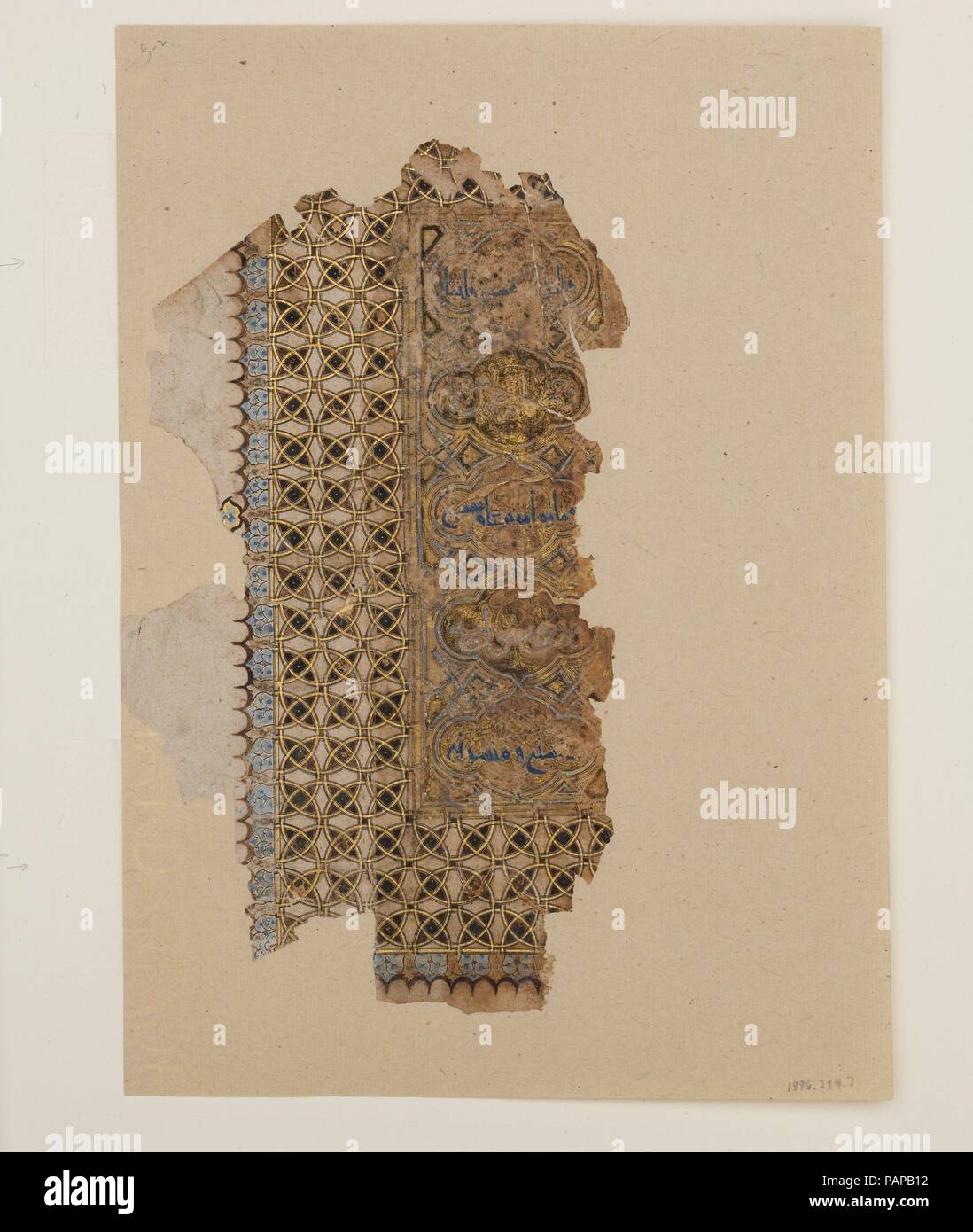 Folio from a Qur'an Manuscript. Calligrapher: Muhammad al-Zanjani. Dimensions: 8 1/2 x 4 13/16in. (21.6 x 12.2cm). Date: dated A.H. 531/A.D. 1137. Eight folios of this dispersed Qur'an are held in the Museum collection. Among these folios is the colophon page, with the signature of the scribe Muhammad al-Zanjani from the town of Zanjan, in northwestern Iran, and the date of completion, A.H. 531/A.D. 1137. The text is written in the script known as eastern kufic with some elements in cursive (naskh), and is lavishly illuminated with designs of foliate scrolls and geometric interlace. Museum: M Stock Photohttps://www.alamy.com/image-license-details/?v=1https://www.alamy.com/folio-from-a-quran-manuscript-calligrapher-muhammad-al-zanjani-dimensions-8-12-x-4-1316in-216-x-122cm-date-dated-ah-531ad-1137-eight-folios-of-this-dispersed-quran-are-held-in-the-museum-collection-among-these-folios-is-the-colophon-page-with-the-signature-of-the-scribe-muhammad-al-zanjani-from-the-town-of-zanjan-in-northwestern-iran-and-the-date-of-completion-ah-531ad-1137-the-text-is-written-in-the-script-known-as-eastern-kufic-with-some-elements-in-cursive-naskh-and-is-lavishly-illuminated-with-designs-of-foliate-scrolls-and-geometric-interlace-museum-m-image213162574.html
Folio from a Qur'an Manuscript. Calligrapher: Muhammad al-Zanjani. Dimensions: 8 1/2 x 4 13/16in. (21.6 x 12.2cm). Date: dated A.H. 531/A.D. 1137. Eight folios of this dispersed Qur'an are held in the Museum collection. Among these folios is the colophon page, with the signature of the scribe Muhammad al-Zanjani from the town of Zanjan, in northwestern Iran, and the date of completion, A.H. 531/A.D. 1137. The text is written in the script known as eastern kufic with some elements in cursive (naskh), and is lavishly illuminated with designs of foliate scrolls and geometric interlace. Museum: M Stock Photohttps://www.alamy.com/image-license-details/?v=1https://www.alamy.com/folio-from-a-quran-manuscript-calligrapher-muhammad-al-zanjani-dimensions-8-12-x-4-1316in-216-x-122cm-date-dated-ah-531ad-1137-eight-folios-of-this-dispersed-quran-are-held-in-the-museum-collection-among-these-folios-is-the-colophon-page-with-the-signature-of-the-scribe-muhammad-al-zanjani-from-the-town-of-zanjan-in-northwestern-iran-and-the-date-of-completion-ah-531ad-1137-the-text-is-written-in-the-script-known-as-eastern-kufic-with-some-elements-in-cursive-naskh-and-is-lavishly-illuminated-with-designs-of-foliate-scrolls-and-geometric-interlace-museum-m-image213162574.htmlRMPAPB12–Folio from a Qur'an Manuscript. Calligrapher: Muhammad al-Zanjani. Dimensions: 8 1/2 x 4 13/16in. (21.6 x 12.2cm). Date: dated A.H. 531/A.D. 1137. Eight folios of this dispersed Qur'an are held in the Museum collection. Among these folios is the colophon page, with the signature of the scribe Muhammad al-Zanjani from the town of Zanjan, in northwestern Iran, and the date of completion, A.H. 531/A.D. 1137. The text is written in the script known as eastern kufic with some elements in cursive (naskh), and is lavishly illuminated with designs of foliate scrolls and geometric interlace. Museum: M
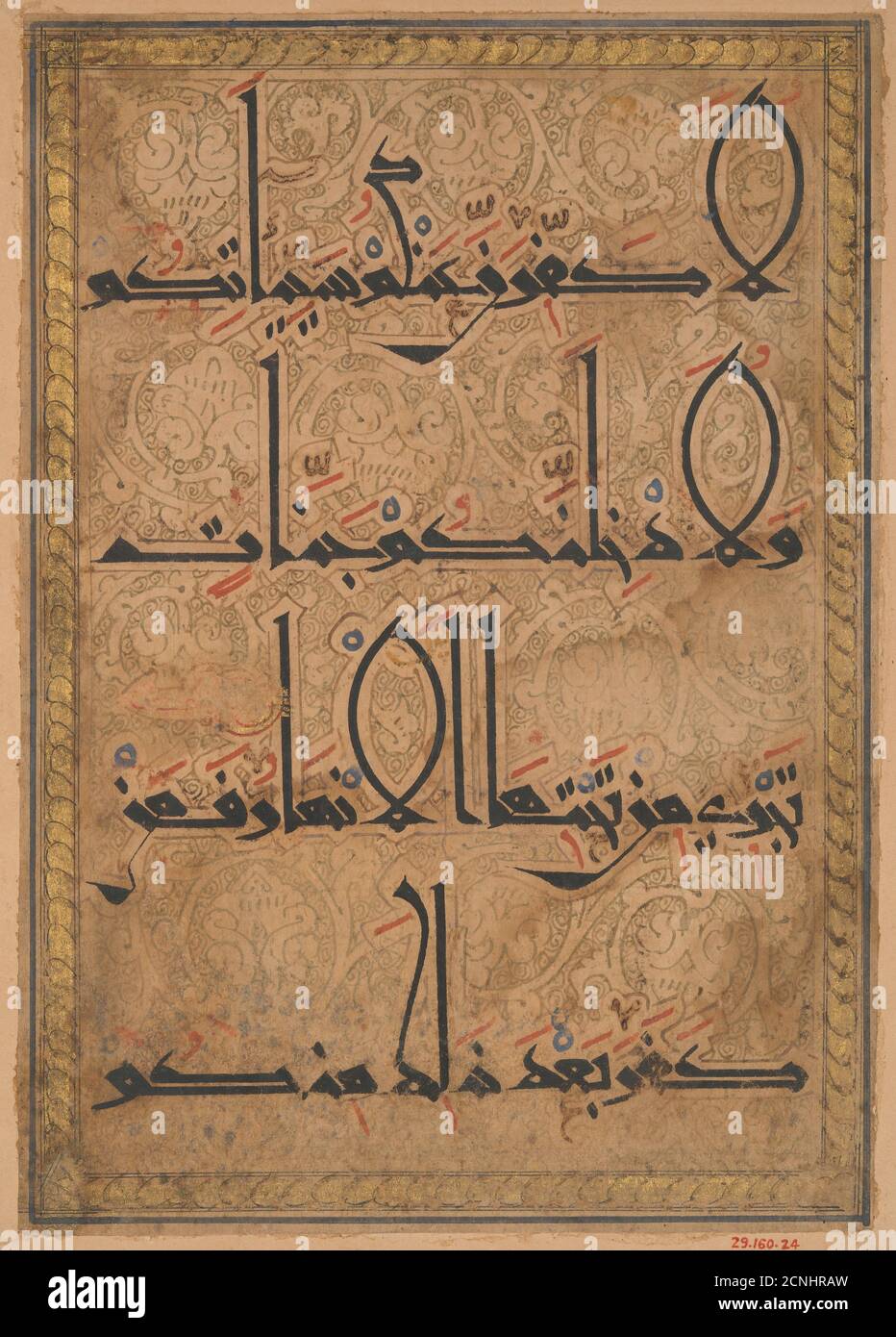 Folio from a Qur'an Manuscript, ca. 1180. Stock Photohttps://www.alamy.com/image-license-details/?v=1https://www.alamy.com/folio-from-a-quran-manuscript-ca-1180-image374717025.html
Folio from a Qur'an Manuscript, ca. 1180. Stock Photohttps://www.alamy.com/image-license-details/?v=1https://www.alamy.com/folio-from-a-quran-manuscript-ca-1180-image374717025.htmlRM2CNHRAW–Folio from a Qur'an Manuscript, ca. 1180.
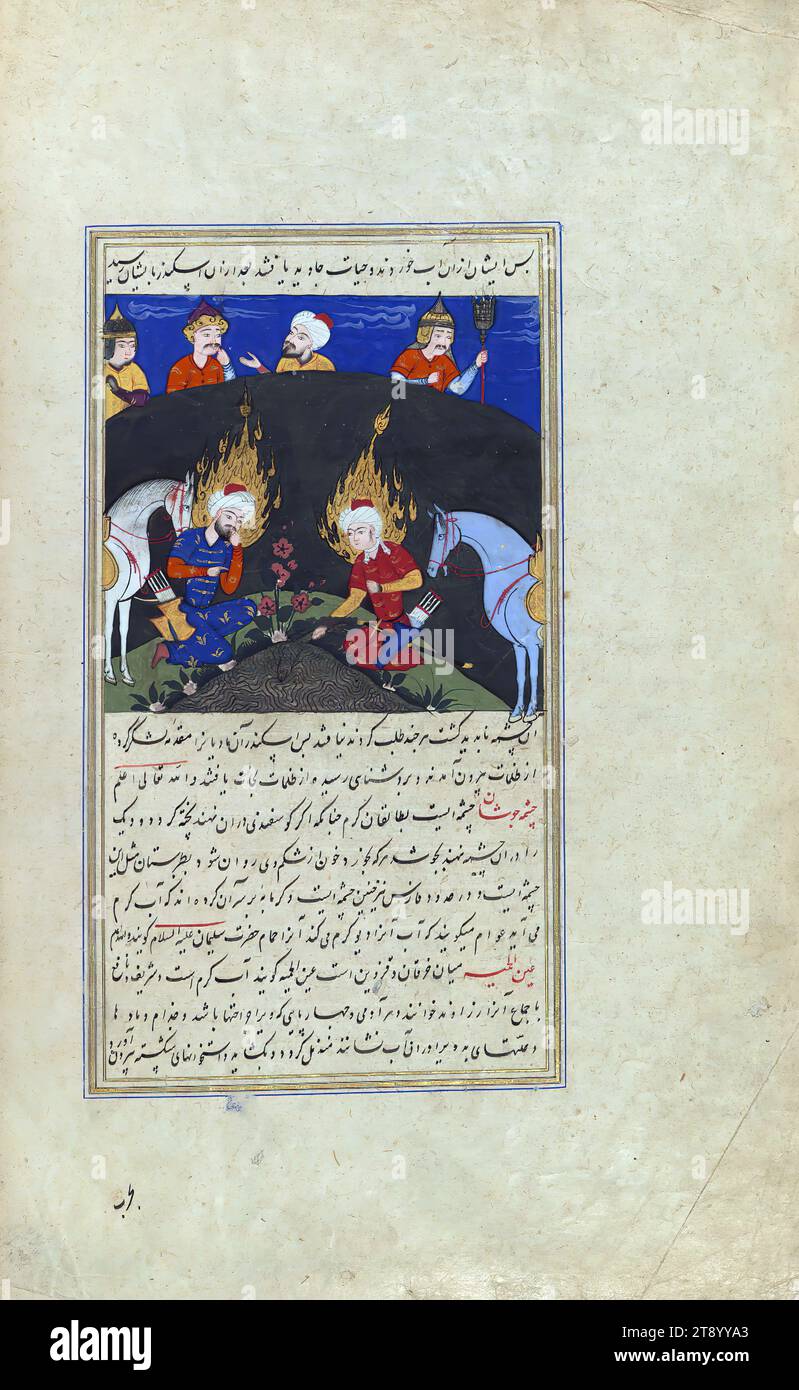 Wonders of creation, Alexander the Great, his soldiers, and the prophets Khiḍr and Elijah at the Fountain of Life, A Persian version of the famous 'Wonders of creation' (ʿAjā’ib al-makhlūqāt) by Zakariyāʾ al-Qazwīnī (d. 682 AH / 1283 CE). Composed by Shams al-Dīn Muḥammad al-Ṭūsī (fl. 6th century AH /12th CE), this manuscript, which may have been copied by an Iranian scribe, was illustrated with 181 miniatures (including a double-page map of the world) by several artists probably in Turkey in the 10th century AH / 16th CE Stock Photohttps://www.alamy.com/image-license-details/?v=1https://www.alamy.com/wonders-of-creation-alexander-the-great-his-soldiers-and-the-prophets-khir-and-elijah-at-the-fountain-of-life-a-persian-version-of-the-famous-wonders-of-creation-ajib-al-makhlqt-by-zakariy-al-qazwn-d-682-ah-1283-ce-composed-by-shams-al-dn-muammad-al-s-fl-6th-century-ah-12th-ce-this-manuscript-which-may-have-been-copied-by-an-iranian-scribe-was-illustrated-with-181-miniatures-including-a-double-page-map-of-the-world-by-several-artists-probably-in-turkey-in-the-10th-century-ah-16th-ce-image573473547.html
Wonders of creation, Alexander the Great, his soldiers, and the prophets Khiḍr and Elijah at the Fountain of Life, A Persian version of the famous 'Wonders of creation' (ʿAjā’ib al-makhlūqāt) by Zakariyāʾ al-Qazwīnī (d. 682 AH / 1283 CE). Composed by Shams al-Dīn Muḥammad al-Ṭūsī (fl. 6th century AH /12th CE), this manuscript, which may have been copied by an Iranian scribe, was illustrated with 181 miniatures (including a double-page map of the world) by several artists probably in Turkey in the 10th century AH / 16th CE Stock Photohttps://www.alamy.com/image-license-details/?v=1https://www.alamy.com/wonders-of-creation-alexander-the-great-his-soldiers-and-the-prophets-khir-and-elijah-at-the-fountain-of-life-a-persian-version-of-the-famous-wonders-of-creation-ajib-al-makhlqt-by-zakariy-al-qazwn-d-682-ah-1283-ce-composed-by-shams-al-dn-muammad-al-s-fl-6th-century-ah-12th-ce-this-manuscript-which-may-have-been-copied-by-an-iranian-scribe-was-illustrated-with-181-miniatures-including-a-double-page-map-of-the-world-by-several-artists-probably-in-turkey-in-the-10th-century-ah-16th-ce-image573473547.htmlRM2T8YYA3–Wonders of creation, Alexander the Great, his soldiers, and the prophets Khiḍr and Elijah at the Fountain of Life, A Persian version of the famous 'Wonders of creation' (ʿAjā’ib al-makhlūqāt) by Zakariyāʾ al-Qazwīnī (d. 682 AH / 1283 CE). Composed by Shams al-Dīn Muḥammad al-Ṭūsī (fl. 6th century AH /12th CE), this manuscript, which may have been copied by an Iranian scribe, was illustrated with 181 miniatures (including a double-page map of the world) by several artists probably in Turkey in the 10th century AH / 16th CE
 Persian (Iranian) Islamic style, manuscript, Illustrated 12th century: The poet Nezami recounts the tales of Alexander the great Stock Photohttps://www.alamy.com/image-license-details/?v=1https://www.alamy.com/persian-iranian-islamic-style-manuscript-illustrated-12th-century-the-poet-nezami-recounts-the-tales-of-alexander-the-great-image186341725.html
Persian (Iranian) Islamic style, manuscript, Illustrated 12th century: The poet Nezami recounts the tales of Alexander the great Stock Photohttps://www.alamy.com/image-license-details/?v=1https://www.alamy.com/persian-iranian-islamic-style-manuscript-illustrated-12th-century-the-poet-nezami-recounts-the-tales-of-alexander-the-great-image186341725.htmlRMMR4GNH–Persian (Iranian) Islamic style, manuscript, Illustrated 12th century: The poet Nezami recounts the tales of Alexander the great
 Islamic Medical Encyclopedia Epitomes Manuscript, 12th Century Stock Photohttps://www.alamy.com/image-license-details/?v=1https://www.alamy.com/stock-photo-islamic-medical-encyclopedia-epitomes-manuscript-12th-century-135089338.html
Islamic Medical Encyclopedia Epitomes Manuscript, 12th Century Stock Photohttps://www.alamy.com/image-license-details/?v=1https://www.alamy.com/stock-photo-islamic-medical-encyclopedia-epitomes-manuscript-12th-century-135089338.htmlRMHRNRR6–Islamic Medical Encyclopedia Epitomes Manuscript, 12th Century
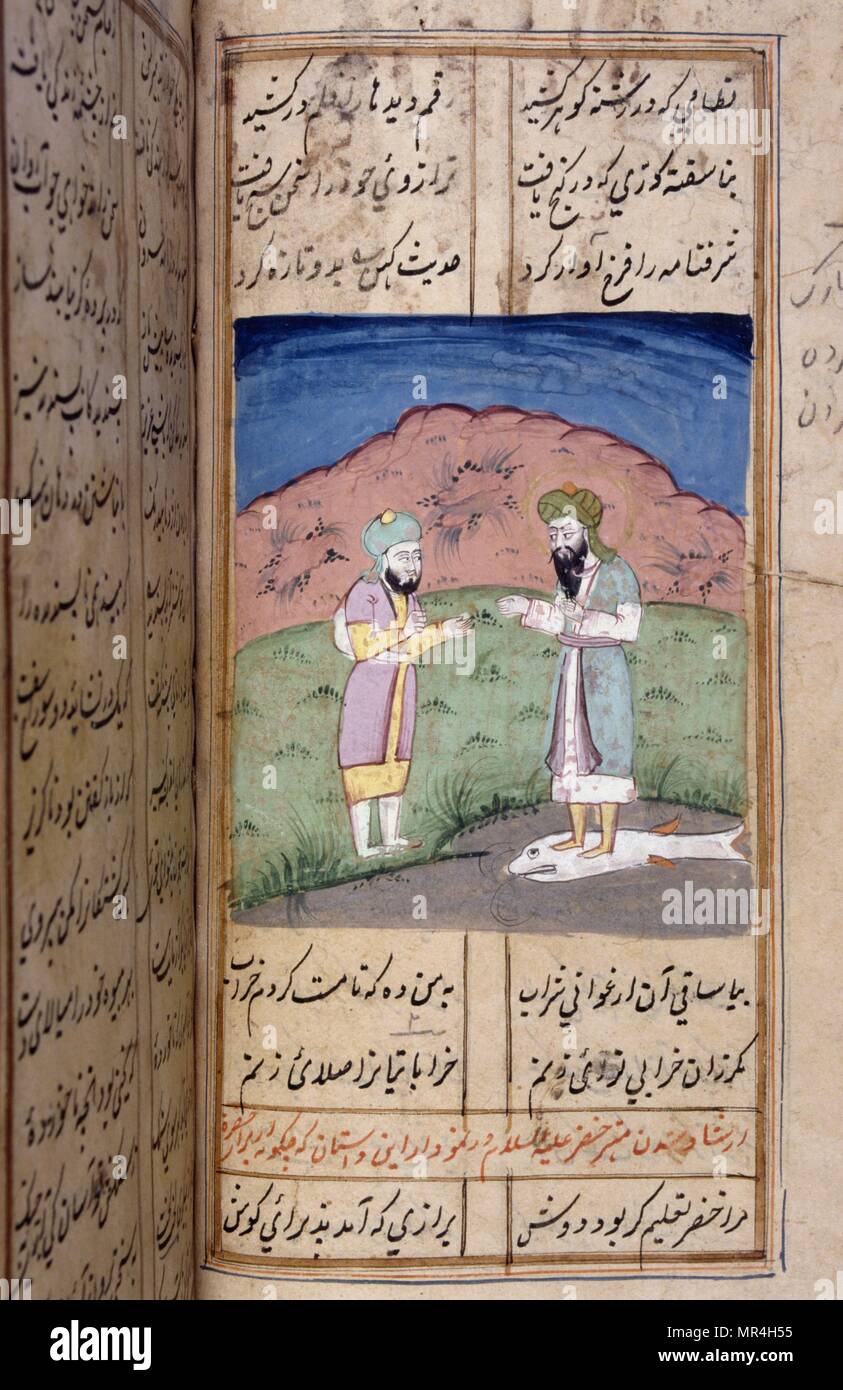 Persian (Iranian) Islamic style, manuscript, Illustrated 12th century: The poet Nezami recounts the tales of Alexander the great Stock Photohttps://www.alamy.com/image-license-details/?v=1https://www.alamy.com/persian-iranian-islamic-style-manuscript-illustrated-12th-century-the-poet-nezami-recounts-the-tales-of-alexander-the-great-image186342049.html
Persian (Iranian) Islamic style, manuscript, Illustrated 12th century: The poet Nezami recounts the tales of Alexander the great Stock Photohttps://www.alamy.com/image-license-details/?v=1https://www.alamy.com/persian-iranian-islamic-style-manuscript-illustrated-12th-century-the-poet-nezami-recounts-the-tales-of-alexander-the-great-image186342049.htmlRMMR4H55–Persian (Iranian) Islamic style, manuscript, Illustrated 12th century: The poet Nezami recounts the tales of Alexander the great
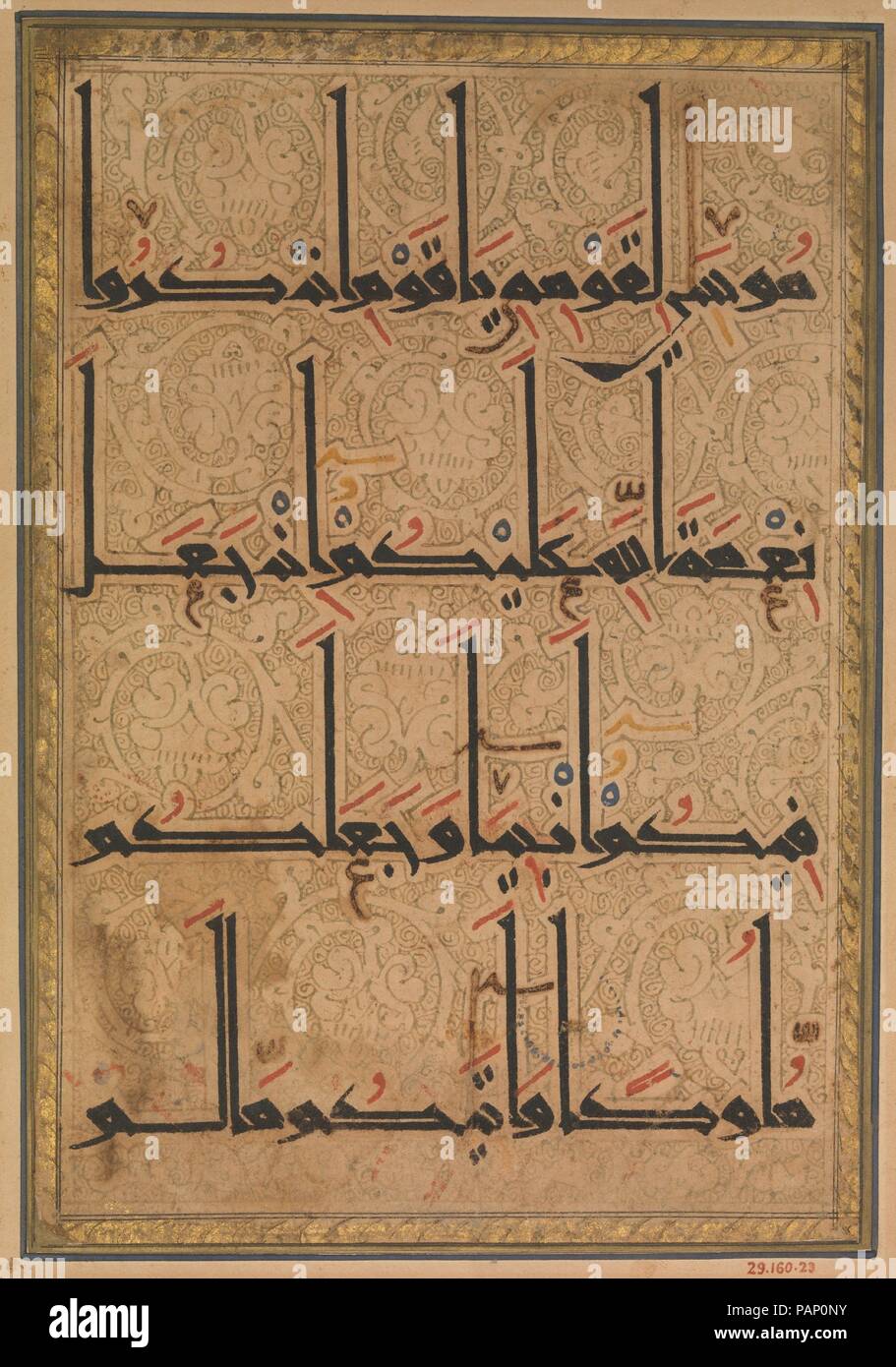 Folio from a Qur'an Manuscript. Dimensions: 11.75 in. high 8.75 in. wide (29.8 cm high 22.2 cm wide). Date: ca. 1180. Written in Eastern or new style kufic script , line two of this folio includes two long, vertical letters (alif and lam), forming a distinctive pointed oval-shaped pattern. The elaborate treatment of the background, entirely filled with vegetal scrolls terminating in large blossoms so that the script seems to stand out against the decorative background. The script and illumination are related to a Qur'an in the Topkapi Saray Museum, dated 573/1177-78, epigraphic inscriptions Stock Photohttps://www.alamy.com/image-license-details/?v=1https://www.alamy.com/folio-from-a-quran-manuscript-dimensions-1175-in-high-875-in-wide-298-cm-high-222-cm-wide-date-ca-1180-written-in-eastern-or-new-style-kufic-script-line-two-of-this-folio-includes-two-long-vertical-letters-alif-and-lam-forming-a-distinctive-pointed-oval-shaped-pattern-the-elaborate-treatment-of-the-background-entirely-filled-with-vegetal-scrolls-terminating-in-large-blossoms-so-that-the-script-seems-to-stand-out-against-the-decorative-background-the-script-and-illumination-are-related-to-a-quran-in-the-topkapi-saray-museum-dated-5731177-78-epigraphic-inscriptions-image213154535.html
Folio from a Qur'an Manuscript. Dimensions: 11.75 in. high 8.75 in. wide (29.8 cm high 22.2 cm wide). Date: ca. 1180. Written in Eastern or new style kufic script , line two of this folio includes two long, vertical letters (alif and lam), forming a distinctive pointed oval-shaped pattern. The elaborate treatment of the background, entirely filled with vegetal scrolls terminating in large blossoms so that the script seems to stand out against the decorative background. The script and illumination are related to a Qur'an in the Topkapi Saray Museum, dated 573/1177-78, epigraphic inscriptions Stock Photohttps://www.alamy.com/image-license-details/?v=1https://www.alamy.com/folio-from-a-quran-manuscript-dimensions-1175-in-high-875-in-wide-298-cm-high-222-cm-wide-date-ca-1180-written-in-eastern-or-new-style-kufic-script-line-two-of-this-folio-includes-two-long-vertical-letters-alif-and-lam-forming-a-distinctive-pointed-oval-shaped-pattern-the-elaborate-treatment-of-the-background-entirely-filled-with-vegetal-scrolls-terminating-in-large-blossoms-so-that-the-script-seems-to-stand-out-against-the-decorative-background-the-script-and-illumination-are-related-to-a-quran-in-the-topkapi-saray-museum-dated-5731177-78-epigraphic-inscriptions-image213154535.htmlRMPAP0NY–Folio from a Qur'an Manuscript. Dimensions: 11.75 in. high 8.75 in. wide (29.8 cm high 22.2 cm wide). Date: ca. 1180. Written in Eastern or new style kufic script , line two of this folio includes two long, vertical letters (alif and lam), forming a distinctive pointed oval-shaped pattern. The elaborate treatment of the background, entirely filled with vegetal scrolls terminating in large blossoms so that the script seems to stand out against the decorative background. The script and illumination are related to a Qur'an in the Topkapi Saray Museum, dated 573/1177-78, epigraphic inscriptions
 Folio from a Qur'an Manuscript, dated A.H. 531/ A.D. 1137. Stock Photohttps://www.alamy.com/image-license-details/?v=1https://www.alamy.com/folio-from-a-quran-manuscript-dated-ah-531-ad-1137-image365763230.html
Folio from a Qur'an Manuscript, dated A.H. 531/ A.D. 1137. Stock Photohttps://www.alamy.com/image-license-details/?v=1https://www.alamy.com/folio-from-a-quran-manuscript-dated-ah-531-ad-1137-image365763230.htmlRM2C71XME–Folio from a Qur'an Manuscript, dated A.H. 531/ A.D. 1137.
 Wonders of creation, An idol in the River Andalus warns people not to continue their journey, A Persian version of the famous 'Wonders of creation' (ʿAjā’ib al-makhlūqāt) by Zakariyāʾ al-Qazwīnī (d. 682 AH / 1283 CE). Composed by Shams al-Dīn Muḥammad al-Ṭūsī (fl. 6th century AH /12th CE), this manuscript, which may have been copied by an Iranian scribe, was illustrated with 181 miniatures (including a double-page map of the world) by several artists probably in Turkey in the 10th century AH / 16th CE Stock Photohttps://www.alamy.com/image-license-details/?v=1https://www.alamy.com/wonders-of-creation-an-idol-in-the-river-andalus-warns-people-not-to-continue-their-journey-a-persian-version-of-the-famous-wonders-of-creation-ajib-al-makhlqt-by-zakariy-al-qazwn-d-682-ah-1283-ce-composed-by-shams-al-dn-muammad-al-s-fl-6th-century-ah-12th-ce-this-manuscript-which-may-have-been-copied-by-an-iranian-scribe-was-illustrated-with-181-miniatures-including-a-double-page-map-of-the-world-by-several-artists-probably-in-turkey-in-the-10th-century-ah-16th-ce-image573473554.html
Wonders of creation, An idol in the River Andalus warns people not to continue their journey, A Persian version of the famous 'Wonders of creation' (ʿAjā’ib al-makhlūqāt) by Zakariyāʾ al-Qazwīnī (d. 682 AH / 1283 CE). Composed by Shams al-Dīn Muḥammad al-Ṭūsī (fl. 6th century AH /12th CE), this manuscript, which may have been copied by an Iranian scribe, was illustrated with 181 miniatures (including a double-page map of the world) by several artists probably in Turkey in the 10th century AH / 16th CE Stock Photohttps://www.alamy.com/image-license-details/?v=1https://www.alamy.com/wonders-of-creation-an-idol-in-the-river-andalus-warns-people-not-to-continue-their-journey-a-persian-version-of-the-famous-wonders-of-creation-ajib-al-makhlqt-by-zakariy-al-qazwn-d-682-ah-1283-ce-composed-by-shams-al-dn-muammad-al-s-fl-6th-century-ah-12th-ce-this-manuscript-which-may-have-been-copied-by-an-iranian-scribe-was-illustrated-with-181-miniatures-including-a-double-page-map-of-the-world-by-several-artists-probably-in-turkey-in-the-10th-century-ah-16th-ce-image573473554.htmlRM2T8YYAA–Wonders of creation, An idol in the River Andalus warns people not to continue their journey, A Persian version of the famous 'Wonders of creation' (ʿAjā’ib al-makhlūqāt) by Zakariyāʾ al-Qazwīnī (d. 682 AH / 1283 CE). Composed by Shams al-Dīn Muḥammad al-Ṭūsī (fl. 6th century AH /12th CE), this manuscript, which may have been copied by an Iranian scribe, was illustrated with 181 miniatures (including a double-page map of the world) by several artists probably in Turkey in the 10th century AH / 16th CE
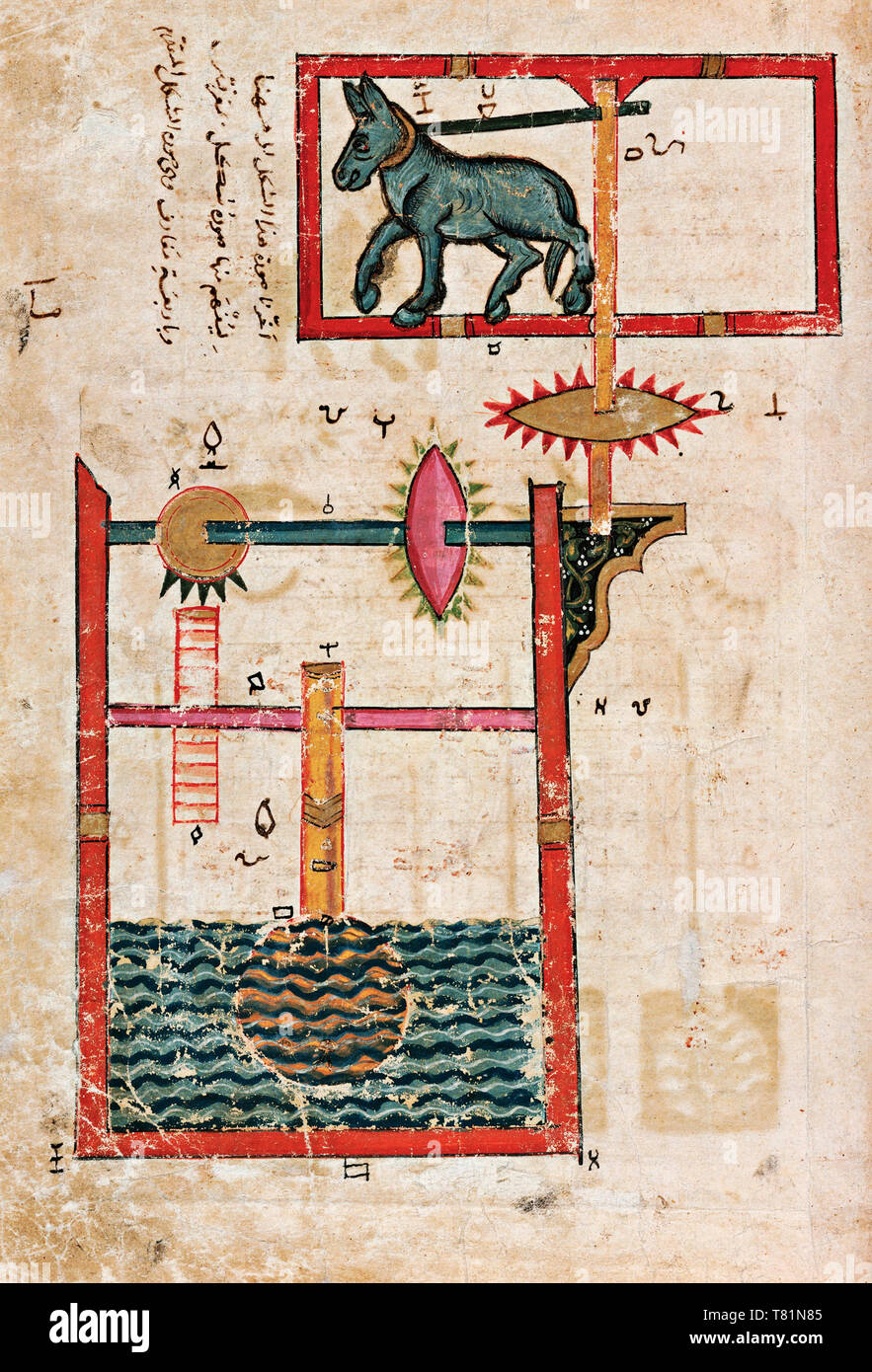 Waterwheel invention, 12th century Stock Photohttps://www.alamy.com/image-license-details/?v=1https://www.alamy.com/waterwheel-invention-12th-century-image245901045.html
Waterwheel invention, 12th century Stock Photohttps://www.alamy.com/image-license-details/?v=1https://www.alamy.com/waterwheel-invention-12th-century-image245901045.htmlRMT81N85–Waterwheel invention, 12th century
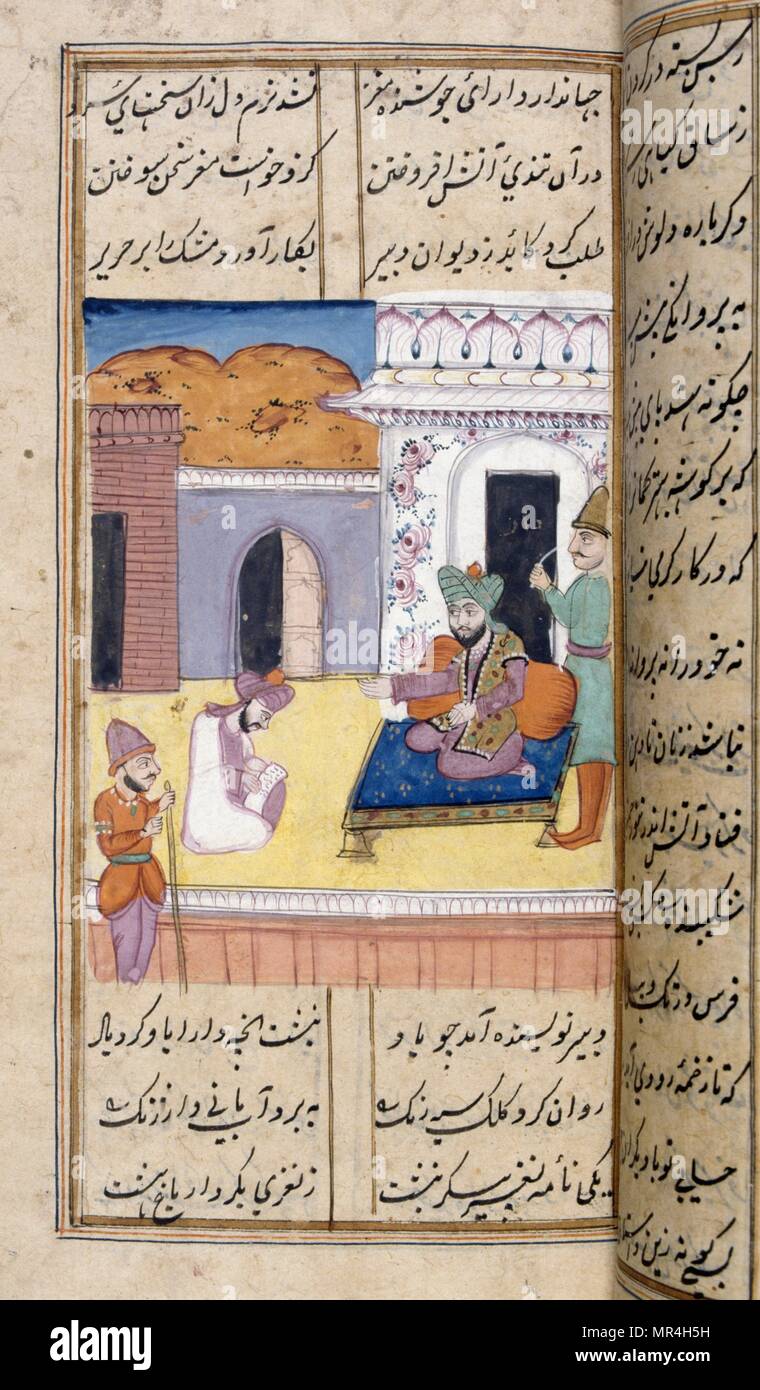 Persian (Iranian) Islamic style, manuscript, Illustrated 12th century: The poet Nezami recounts the tales of Alexander the great Stock Photohttps://www.alamy.com/image-license-details/?v=1https://www.alamy.com/persian-iranian-islamic-style-manuscript-illustrated-12th-century-the-poet-nezami-recounts-the-tales-of-alexander-the-great-image186342061.html
Persian (Iranian) Islamic style, manuscript, Illustrated 12th century: The poet Nezami recounts the tales of Alexander the great Stock Photohttps://www.alamy.com/image-license-details/?v=1https://www.alamy.com/persian-iranian-islamic-style-manuscript-illustrated-12th-century-the-poet-nezami-recounts-the-tales-of-alexander-the-great-image186342061.htmlRMMR4H5H–Persian (Iranian) Islamic style, manuscript, Illustrated 12th century: The poet Nezami recounts the tales of Alexander the great
 ESCENA CORTESANA EN UNA MINIATURA DE UN MANUSCRITO PERSA DEL SIGLO XII. Location: PRIVATE COLLECTION. MADRID. SPAIN. Stock Photohttps://www.alamy.com/image-license-details/?v=1https://www.alamy.com/escena-cortesana-en-una-miniatura-de-un-manuscrito-persa-del-siglo-xii-location-private-collection-madrid-spain-image226491285.html
ESCENA CORTESANA EN UNA MINIATURA DE UN MANUSCRITO PERSA DEL SIGLO XII. Location: PRIVATE COLLECTION. MADRID. SPAIN. Stock Photohttps://www.alamy.com/image-license-details/?v=1https://www.alamy.com/escena-cortesana-en-una-miniatura-de-un-manuscrito-persa-del-siglo-xii-location-private-collection-madrid-spain-image226491285.htmlRMR4DFXD–ESCENA CORTESANA EN UNA MINIATURA DE UN MANUSCRITO PERSA DEL SIGLO XII. Location: PRIVATE COLLECTION. MADRID. SPAIN.
 Folio from a Qur'an Manuscript, dated A.H. 531/ A.D. 1137. Stock Photohttps://www.alamy.com/image-license-details/?v=1https://www.alamy.com/folio-from-a-quran-manuscript-dated-ah-531-ad-1137-image365763236.html
Folio from a Qur'an Manuscript, dated A.H. 531/ A.D. 1137. Stock Photohttps://www.alamy.com/image-license-details/?v=1https://www.alamy.com/folio-from-a-quran-manuscript-dated-ah-531-ad-1137-image365763236.htmlRM2C71XMM–Folio from a Qur'an Manuscript, dated A.H. 531/ A.D. 1137.
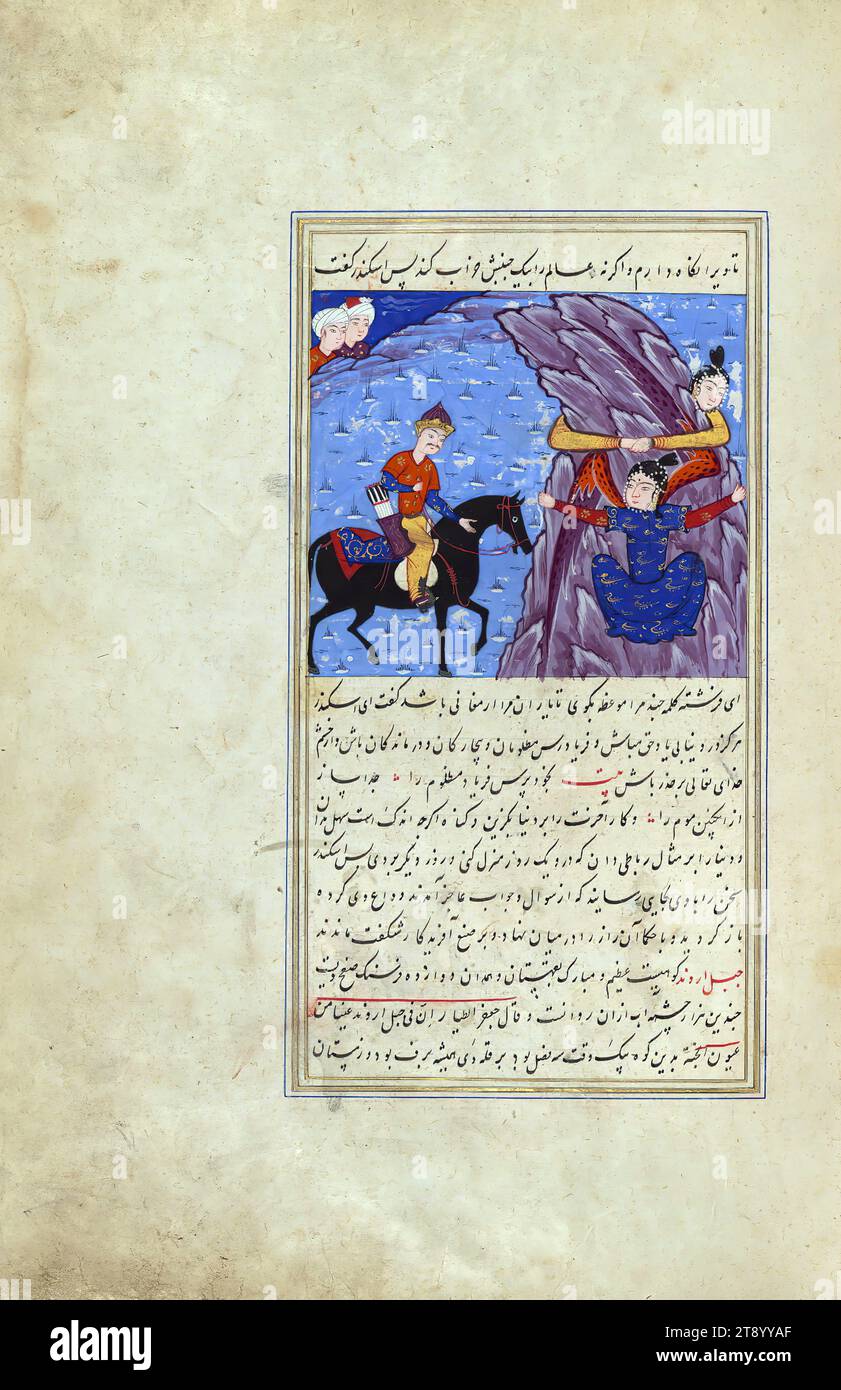 Wonders of creation, Alexander the Great on horseback and two angels holding Mount Qāf, A Persian version of the famous 'Wonders of creation' (ʿAjā’ib al-makhlūqāt) by Zakariyāʾ al-Qazwīnī (d. 682 AH / 1283 CE). Composed by Shams al-Dīn Muḥammad al-Ṭūsī (fl. 6th century AH /12th CE), this manuscript, which may have been copied by an Iranian scribe, was illustrated with 181 miniatures (including a double-page map of the world) by several artists probably in Turkey in the 10th century AH / 16th CE Stock Photohttps://www.alamy.com/image-license-details/?v=1https://www.alamy.com/wonders-of-creation-alexander-the-great-on-horseback-and-two-angels-holding-mount-qf-a-persian-version-of-the-famous-wonders-of-creation-ajib-al-makhlqt-by-zakariy-al-qazwn-d-682-ah-1283-ce-composed-by-shams-al-dn-muammad-al-s-fl-6th-century-ah-12th-ce-this-manuscript-which-may-have-been-copied-by-an-iranian-scribe-was-illustrated-with-181-miniatures-including-a-double-page-map-of-the-world-by-several-artists-probably-in-turkey-in-the-10th-century-ah-16th-ce-image573473559.html
Wonders of creation, Alexander the Great on horseback and two angels holding Mount Qāf, A Persian version of the famous 'Wonders of creation' (ʿAjā’ib al-makhlūqāt) by Zakariyāʾ al-Qazwīnī (d. 682 AH / 1283 CE). Composed by Shams al-Dīn Muḥammad al-Ṭūsī (fl. 6th century AH /12th CE), this manuscript, which may have been copied by an Iranian scribe, was illustrated with 181 miniatures (including a double-page map of the world) by several artists probably in Turkey in the 10th century AH / 16th CE Stock Photohttps://www.alamy.com/image-license-details/?v=1https://www.alamy.com/wonders-of-creation-alexander-the-great-on-horseback-and-two-angels-holding-mount-qf-a-persian-version-of-the-famous-wonders-of-creation-ajib-al-makhlqt-by-zakariy-al-qazwn-d-682-ah-1283-ce-composed-by-shams-al-dn-muammad-al-s-fl-6th-century-ah-12th-ce-this-manuscript-which-may-have-been-copied-by-an-iranian-scribe-was-illustrated-with-181-miniatures-including-a-double-page-map-of-the-world-by-several-artists-probably-in-turkey-in-the-10th-century-ah-16th-ce-image573473559.htmlRM2T8YYAF–Wonders of creation, Alexander the Great on horseback and two angels holding Mount Qāf, A Persian version of the famous 'Wonders of creation' (ʿAjā’ib al-makhlūqāt) by Zakariyāʾ al-Qazwīnī (d. 682 AH / 1283 CE). Composed by Shams al-Dīn Muḥammad al-Ṭūsī (fl. 6th century AH /12th CE), this manuscript, which may have been copied by an Iranian scribe, was illustrated with 181 miniatures (including a double-page map of the world) by several artists probably in Turkey in the 10th century AH / 16th CE
 Arabic Traders, 12th-13th century Stock Photohttps://www.alamy.com/image-license-details/?v=1https://www.alamy.com/stock-photo-arabic-traders-12th-13th-century-135090608.html
Arabic Traders, 12th-13th century Stock Photohttps://www.alamy.com/image-license-details/?v=1https://www.alamy.com/stock-photo-arabic-traders-12th-13th-century-135090608.htmlRMHRNWCG–Arabic Traders, 12th-13th century
 Persian (Iranian) Islamic style, manuscript, Illustrated 12th century: The poet Nezami recounts the tales of Alexander the great Stock Photohttps://www.alamy.com/image-license-details/?v=1https://www.alamy.com/persian-iranian-islamic-style-manuscript-illustrated-12th-century-the-poet-nezami-recounts-the-tales-of-alexander-the-great-image186342050.html
Persian (Iranian) Islamic style, manuscript, Illustrated 12th century: The poet Nezami recounts the tales of Alexander the great Stock Photohttps://www.alamy.com/image-license-details/?v=1https://www.alamy.com/persian-iranian-islamic-style-manuscript-illustrated-12th-century-the-poet-nezami-recounts-the-tales-of-alexander-the-great-image186342050.htmlRMMR4H56–Persian (Iranian) Islamic style, manuscript, Illustrated 12th century: The poet Nezami recounts the tales of Alexander the great
 CORAN VALENCIANO DE FINALES - SIGLO XII- 2 PAGINAS-ABIERTO. Location: BIBLIOTECA NACIONAL-COLECCION, MADRID, SPAIN. Stock Photohttps://www.alamy.com/image-license-details/?v=1https://www.alamy.com/coran-valenciano-de-finales-siglo-xii-2-paginas-abierto-location-biblioteca-nacional-coleccion-madrid-spain-image208927189.html
CORAN VALENCIANO DE FINALES - SIGLO XII- 2 PAGINAS-ABIERTO. Location: BIBLIOTECA NACIONAL-COLECCION, MADRID, SPAIN. Stock Photohttps://www.alamy.com/image-license-details/?v=1https://www.alamy.com/coran-valenciano-de-finales-siglo-xii-2-paginas-abierto-location-biblioteca-nacional-coleccion-madrid-spain-image208927189.htmlRMP3WCN9–CORAN VALENCIANO DE FINALES - SIGLO XII- 2 PAGINAS-ABIERTO. Location: BIBLIOTECA NACIONAL-COLECCION, MADRID, SPAIN.
 Folio from a Qur'an Manuscript, dated A.H. 531/ A.D. 1137. Stock Photohttps://www.alamy.com/image-license-details/?v=1https://www.alamy.com/folio-from-a-quran-manuscript-dated-ah-531-ad-1137-image374721348.html
Folio from a Qur'an Manuscript, dated A.H. 531/ A.D. 1137. Stock Photohttps://www.alamy.com/image-license-details/?v=1https://www.alamy.com/folio-from-a-quran-manuscript-dated-ah-531-ad-1137-image374721348.htmlRM2CNJ0W8–Folio from a Qur'an Manuscript, dated A.H. 531/ A.D. 1137.
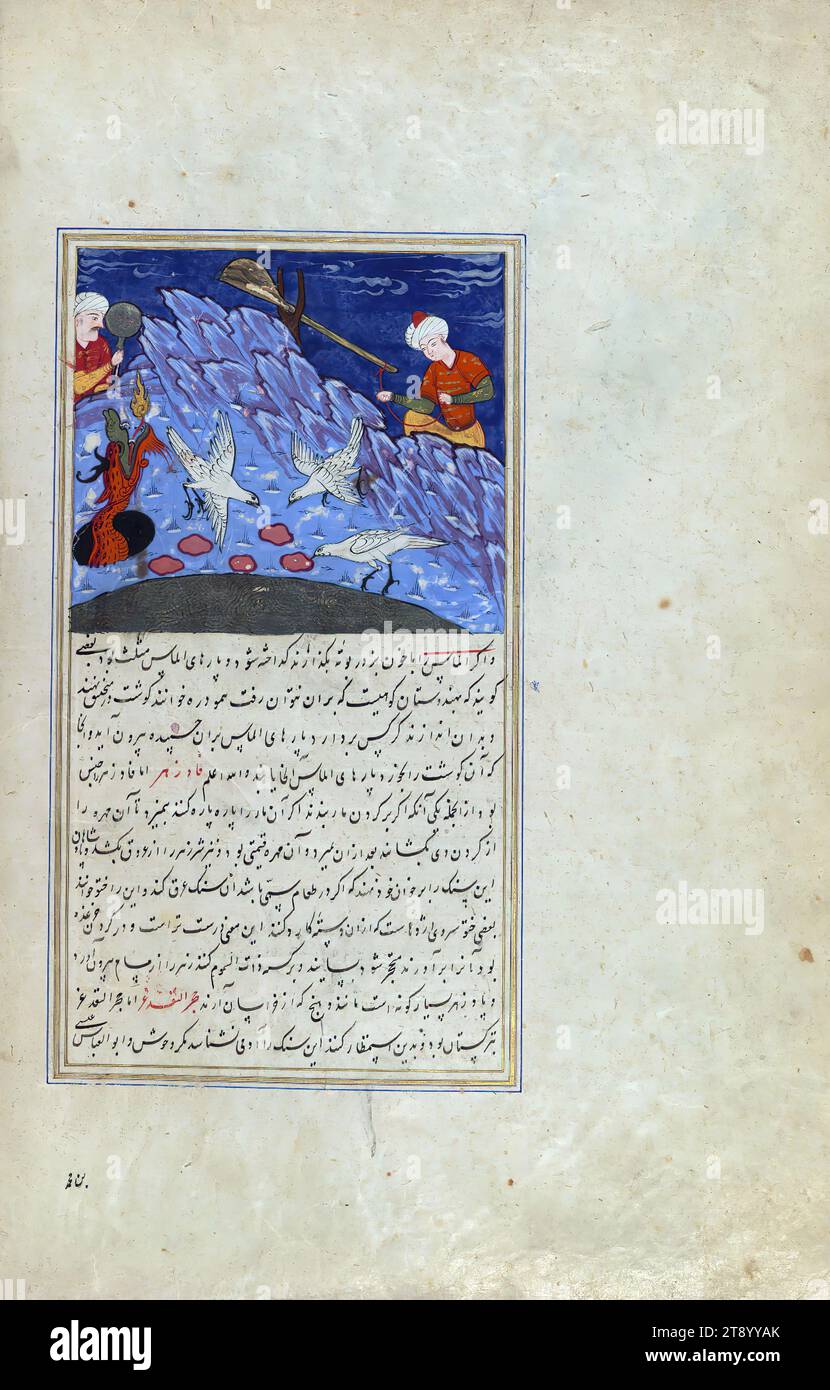 Wonders of creation, Two men watch a dragon and white vultures eating meat with diamonds sticking to it, A Persian version of the famous 'Wonders of creation' (ʿAjā’ib al-makhlūqāt) by Zakariyāʾ al-Qazwīnī (d. 682 AH / 1283 CE). Composed by Shams al-Dīn Muḥammad al-Ṭūsī (fl. 6th century AH /12th CE), this manuscript, which may have been copied by an Iranian scribe, was illustrated with 181 miniatures (including a double-page map of the world) by several artists probably in Turkey in the 10th century AH / 16th CE Stock Photohttps://www.alamy.com/image-license-details/?v=1https://www.alamy.com/wonders-of-creation-two-men-watch-a-dragon-and-white-vultures-eating-meat-with-diamonds-sticking-to-it-a-persian-version-of-the-famous-wonders-of-creation-ajib-al-makhlqt-by-zakariy-al-qazwn-d-682-ah-1283-ce-composed-by-shams-al-dn-muammad-al-s-fl-6th-century-ah-12th-ce-this-manuscript-which-may-have-been-copied-by-an-iranian-scribe-was-illustrated-with-181-miniatures-including-a-double-page-map-of-the-world-by-several-artists-probably-in-turkey-in-the-10th-century-ah-16th-ce-image573473563.html
Wonders of creation, Two men watch a dragon and white vultures eating meat with diamonds sticking to it, A Persian version of the famous 'Wonders of creation' (ʿAjā’ib al-makhlūqāt) by Zakariyāʾ al-Qazwīnī (d. 682 AH / 1283 CE). Composed by Shams al-Dīn Muḥammad al-Ṭūsī (fl. 6th century AH /12th CE), this manuscript, which may have been copied by an Iranian scribe, was illustrated with 181 miniatures (including a double-page map of the world) by several artists probably in Turkey in the 10th century AH / 16th CE Stock Photohttps://www.alamy.com/image-license-details/?v=1https://www.alamy.com/wonders-of-creation-two-men-watch-a-dragon-and-white-vultures-eating-meat-with-diamonds-sticking-to-it-a-persian-version-of-the-famous-wonders-of-creation-ajib-al-makhlqt-by-zakariy-al-qazwn-d-682-ah-1283-ce-composed-by-shams-al-dn-muammad-al-s-fl-6th-century-ah-12th-ce-this-manuscript-which-may-have-been-copied-by-an-iranian-scribe-was-illustrated-with-181-miniatures-including-a-double-page-map-of-the-world-by-several-artists-probably-in-turkey-in-the-10th-century-ah-16th-ce-image573473563.htmlRM2T8YYAK–Wonders of creation, Two men watch a dragon and white vultures eating meat with diamonds sticking to it, A Persian version of the famous 'Wonders of creation' (ʿAjā’ib al-makhlūqāt) by Zakariyāʾ al-Qazwīnī (d. 682 AH / 1283 CE). Composed by Shams al-Dīn Muḥammad al-Ṭūsī (fl. 6th century AH /12th CE), this manuscript, which may have been copied by an Iranian scribe, was illustrated with 181 miniatures (including a double-page map of the world) by several artists probably in Turkey in the 10th century AH / 16th CE
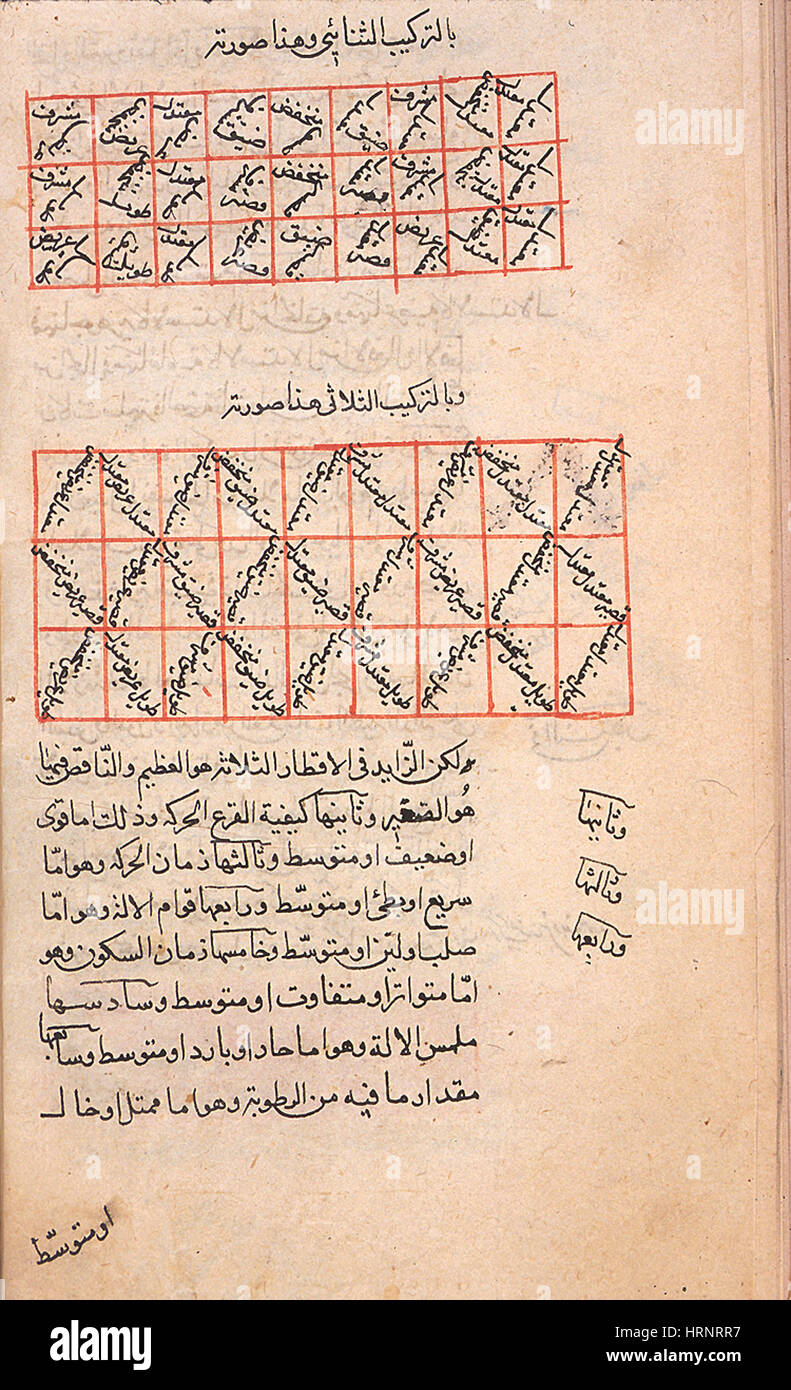 Islamic Medical Encyclopedia Epitomes Manuscript Stock Photohttps://www.alamy.com/image-license-details/?v=1https://www.alamy.com/stock-photo-islamic-medical-encyclopedia-epitomes-manuscript-135089339.html
Islamic Medical Encyclopedia Epitomes Manuscript Stock Photohttps://www.alamy.com/image-license-details/?v=1https://www.alamy.com/stock-photo-islamic-medical-encyclopedia-epitomes-manuscript-135089339.htmlRMHRNRR7–Islamic Medical Encyclopedia Epitomes Manuscript
 Persian (Iranian) Islamic style, manuscript, Illustrated 12th century: The poet Nezami recounts the tales of Alexander the great Stock Photohttps://www.alamy.com/image-license-details/?v=1https://www.alamy.com/persian-iranian-islamic-style-manuscript-illustrated-12th-century-the-poet-nezami-recounts-the-tales-of-alexander-the-great-image186342054.html
Persian (Iranian) Islamic style, manuscript, Illustrated 12th century: The poet Nezami recounts the tales of Alexander the great Stock Photohttps://www.alamy.com/image-license-details/?v=1https://www.alamy.com/persian-iranian-islamic-style-manuscript-illustrated-12th-century-the-poet-nezami-recounts-the-tales-of-alexander-the-great-image186342054.htmlRMMR4H5A–Persian (Iranian) Islamic style, manuscript, Illustrated 12th century: The poet Nezami recounts the tales of Alexander the great
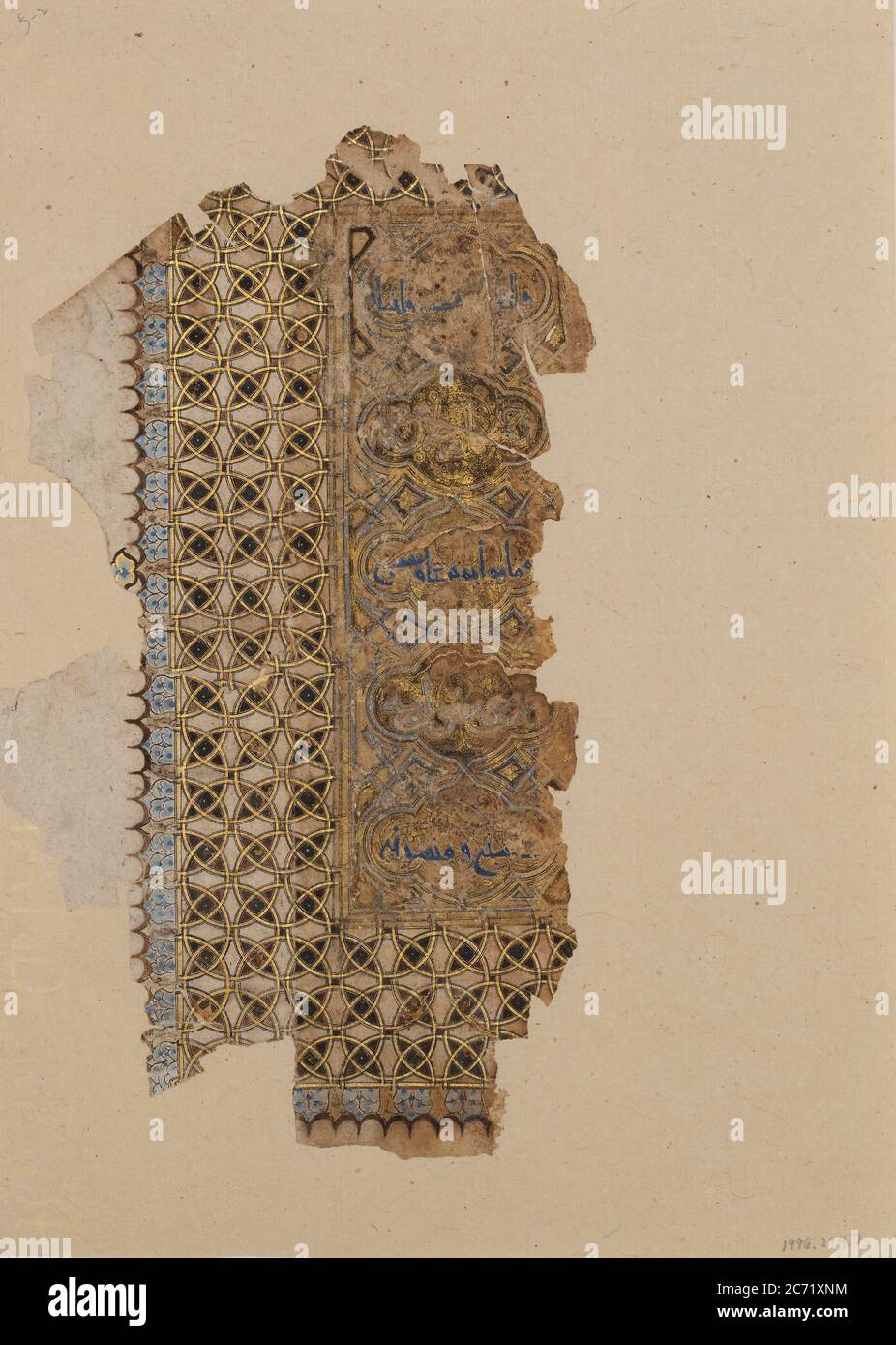 Folio from a Qur'an Manuscript, dated A.H. 531/A.D. 1137. Stock Photohttps://www.alamy.com/image-license-details/?v=1https://www.alamy.com/folio-from-a-quran-manuscript-dated-ah-531ad-1137-image365763264.html
Folio from a Qur'an Manuscript, dated A.H. 531/A.D. 1137. Stock Photohttps://www.alamy.com/image-license-details/?v=1https://www.alamy.com/folio-from-a-quran-manuscript-dated-ah-531ad-1137-image365763264.htmlRM2C71XNM–Folio from a Qur'an Manuscript, dated A.H. 531/A.D. 1137.
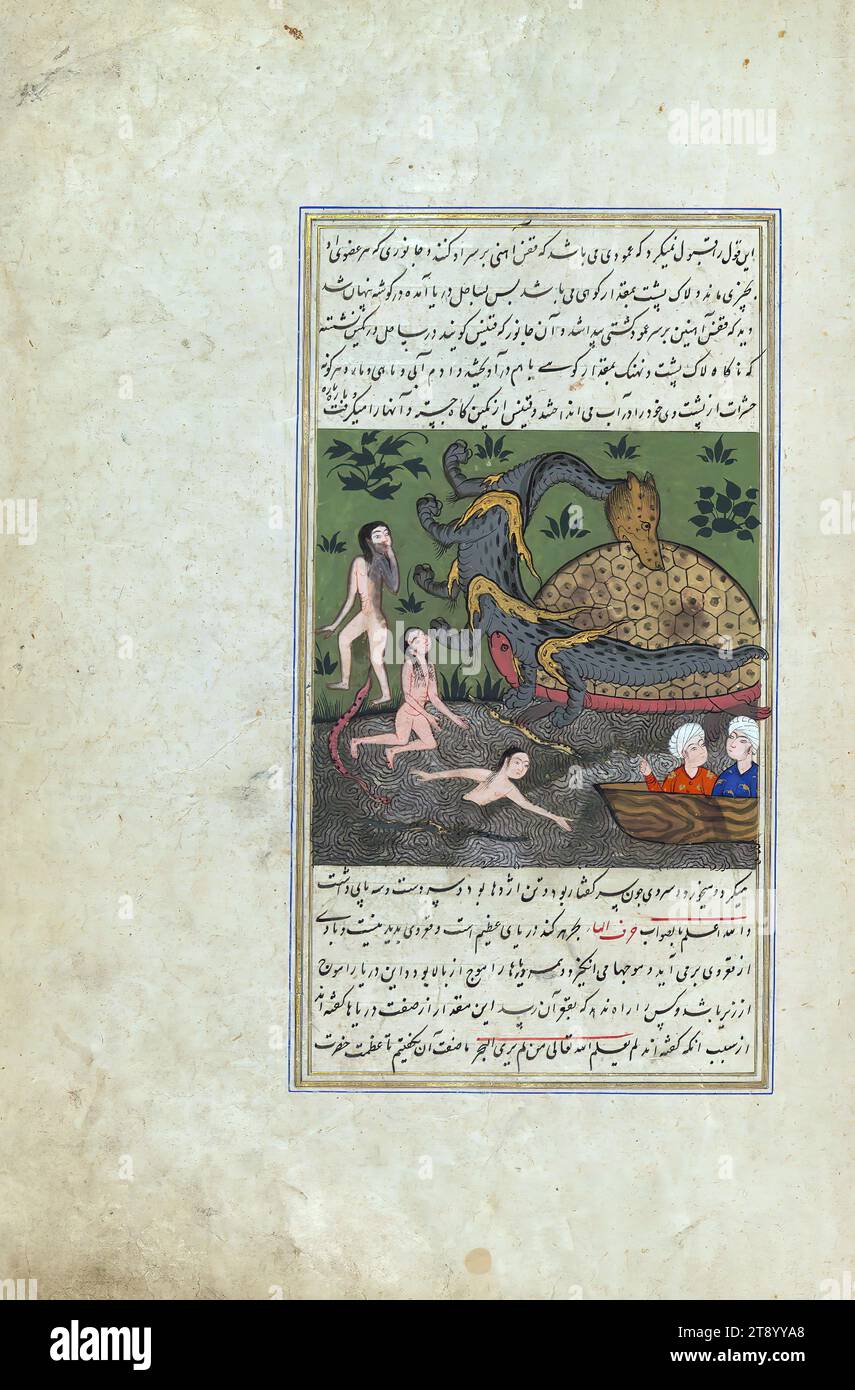 Wonders of creation, Two men in a boat watch sirens and a large turtle at the Sea of Qusṭanṭinīyah, A Persian version of the famous 'Wonders of creation' (ʿAjā’ib al-makhlūqāt) by Zakariyāʾ al-Qazwīnī (d. 682 AH / 1283 CE). Composed by Shams al-Dīn Muḥammad al-Ṭūsī (fl. 6th century AH /12th CE), this manuscript, which may have been copied by an Iranian scribe, was illustrated with 181 miniatures (including a double-page map of the world) by several artists probably in Turkey in the 10th century AH / 16th CE Stock Photohttps://www.alamy.com/image-license-details/?v=1https://www.alamy.com/wonders-of-creation-two-men-in-a-boat-watch-sirens-and-a-large-turtle-at-the-sea-of-qusaninyah-a-persian-version-of-the-famous-wonders-of-creation-ajib-al-makhlqt-by-zakariy-al-qazwn-d-682-ah-1283-ce-composed-by-shams-al-dn-muammad-al-s-fl-6th-century-ah-12th-ce-this-manuscript-which-may-have-been-copied-by-an-iranian-scribe-was-illustrated-with-181-miniatures-including-a-double-page-map-of-the-world-by-several-artists-probably-in-turkey-in-the-10th-century-ah-16th-ce-image573473552.html
Wonders of creation, Two men in a boat watch sirens and a large turtle at the Sea of Qusṭanṭinīyah, A Persian version of the famous 'Wonders of creation' (ʿAjā’ib al-makhlūqāt) by Zakariyāʾ al-Qazwīnī (d. 682 AH / 1283 CE). Composed by Shams al-Dīn Muḥammad al-Ṭūsī (fl. 6th century AH /12th CE), this manuscript, which may have been copied by an Iranian scribe, was illustrated with 181 miniatures (including a double-page map of the world) by several artists probably in Turkey in the 10th century AH / 16th CE Stock Photohttps://www.alamy.com/image-license-details/?v=1https://www.alamy.com/wonders-of-creation-two-men-in-a-boat-watch-sirens-and-a-large-turtle-at-the-sea-of-qusaninyah-a-persian-version-of-the-famous-wonders-of-creation-ajib-al-makhlqt-by-zakariy-al-qazwn-d-682-ah-1283-ce-composed-by-shams-al-dn-muammad-al-s-fl-6th-century-ah-12th-ce-this-manuscript-which-may-have-been-copied-by-an-iranian-scribe-was-illustrated-with-181-miniatures-including-a-double-page-map-of-the-world-by-several-artists-probably-in-turkey-in-the-10th-century-ah-16th-ce-image573473552.htmlRM2T8YYA8–Wonders of creation, Two men in a boat watch sirens and a large turtle at the Sea of Qusṭanṭinīyah, A Persian version of the famous 'Wonders of creation' (ʿAjā’ib al-makhlūqāt) by Zakariyāʾ al-Qazwīnī (d. 682 AH / 1283 CE). Composed by Shams al-Dīn Muḥammad al-Ṭūsī (fl. 6th century AH /12th CE), this manuscript, which may have been copied by an Iranian scribe, was illustrated with 181 miniatures (including a double-page map of the world) by several artists probably in Turkey in the 10th century AH / 16th CE
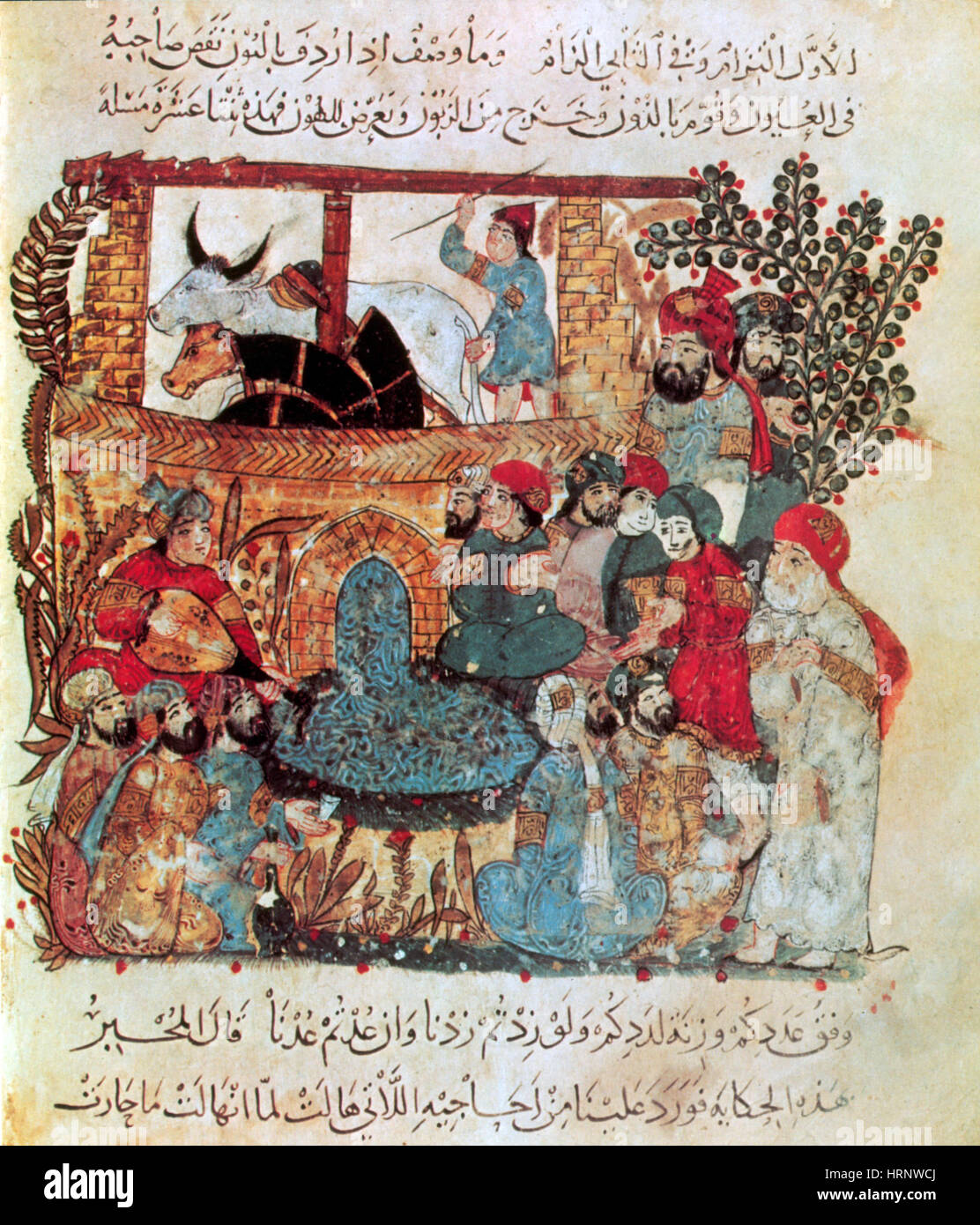 Literary Gathering, Baghdad, 12th Century Stock Photohttps://www.alamy.com/image-license-details/?v=1https://www.alamy.com/stock-photo-literary-gathering-baghdad-12th-century-135090610.html
Literary Gathering, Baghdad, 12th Century Stock Photohttps://www.alamy.com/image-license-details/?v=1https://www.alamy.com/stock-photo-literary-gathering-baghdad-12th-century-135090610.htmlRMHRNWCJ–Literary Gathering, Baghdad, 12th Century
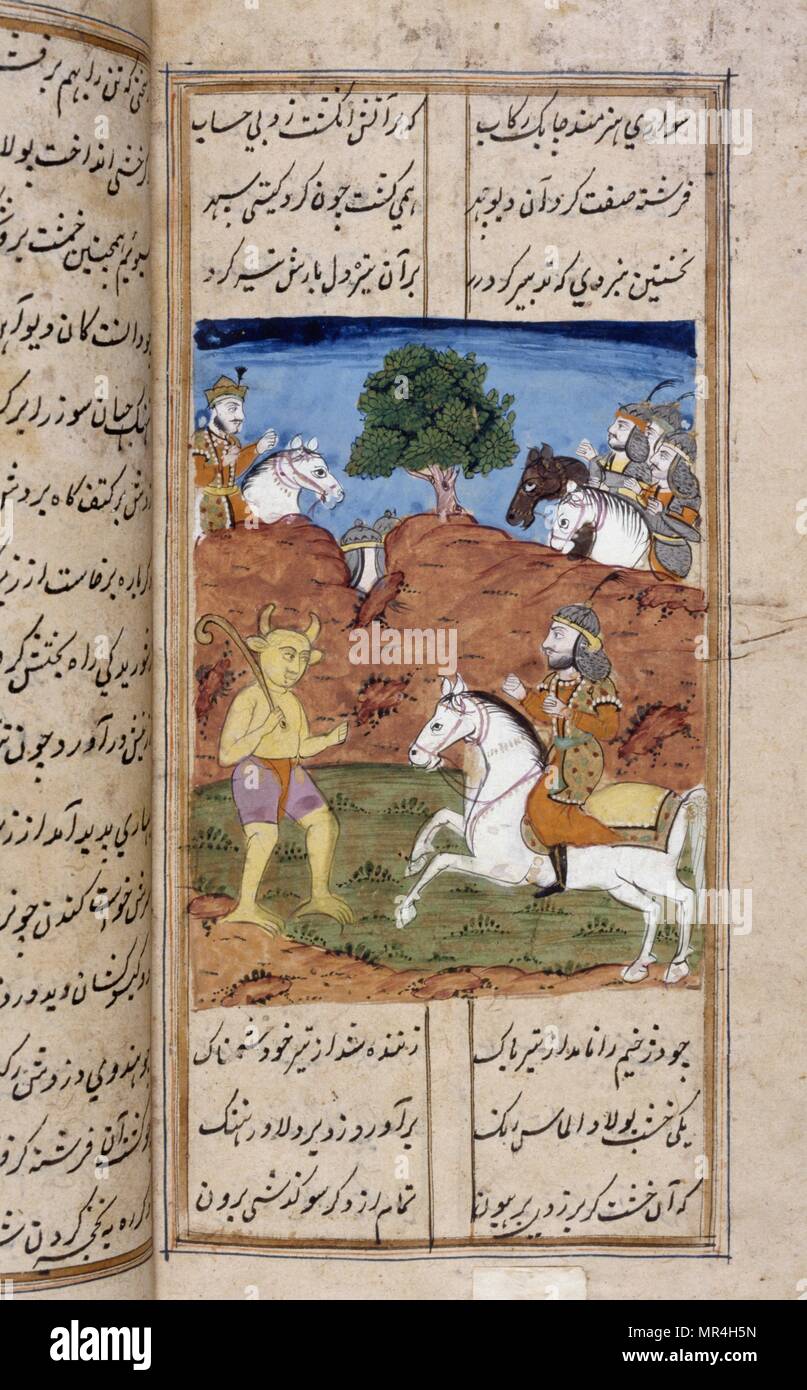 Persian (Iranian) Islamic style, manuscript, Illustrated 12th century: The poet Nezami recounts the tales of Alexander the great Stock Photohttps://www.alamy.com/image-license-details/?v=1https://www.alamy.com/persian-iranian-islamic-style-manuscript-illustrated-12th-century-the-poet-nezami-recounts-the-tales-of-alexander-the-great-image186342065.html
Persian (Iranian) Islamic style, manuscript, Illustrated 12th century: The poet Nezami recounts the tales of Alexander the great Stock Photohttps://www.alamy.com/image-license-details/?v=1https://www.alamy.com/persian-iranian-islamic-style-manuscript-illustrated-12th-century-the-poet-nezami-recounts-the-tales-of-alexander-the-great-image186342065.htmlRMMR4H5N–Persian (Iranian) Islamic style, manuscript, Illustrated 12th century: The poet Nezami recounts the tales of Alexander the great
 Folio from a Qur'an Manuscript, dated A.H. 531/ A.D. 1137. Stock Photohttps://www.alamy.com/image-license-details/?v=1https://www.alamy.com/folio-from-a-quran-manuscript-dated-ah-531-ad-1137-image374710844.html
Folio from a Qur'an Manuscript, dated A.H. 531/ A.D. 1137. Stock Photohttps://www.alamy.com/image-license-details/?v=1https://www.alamy.com/folio-from-a-quran-manuscript-dated-ah-531-ad-1137-image374710844.htmlRM2CNHFE4–Folio from a Qur'an Manuscript, dated A.H. 531/ A.D. 1137.
 Wonders of creation, A man lowers an inscribed tablet from the bridge on the river Sabḥān to calm its waters, A Persian version of the famous 'Wonders of creation' (ʿAjā’ib al-makhlūqāt) by Zakariyāʾ al-Qazwīnī (d. 682 AH / 1283 CE). Composed by Shams al-Dīn Muḥammad al-Ṭūsī (fl. 6th century AH /12th CE), this manuscript, which may have been copied by an Iranian scribe, was illustrated with 181 miniatures (including a double-page map of the world) by several artists probably in Turkey in the 10th century AH / 16th CE Stock Photohttps://www.alamy.com/image-license-details/?v=1https://www.alamy.com/wonders-of-creation-a-man-lowers-an-inscribed-tablet-from-the-bridge-on-the-river-sabn-to-calm-its-waters-a-persian-version-of-the-famous-wonders-of-creation-ajib-al-makhlqt-by-zakariy-al-qazwn-d-682-ah-1283-ce-composed-by-shams-al-dn-muammad-al-s-fl-6th-century-ah-12th-ce-this-manuscript-which-may-have-been-copied-by-an-iranian-scribe-was-illustrated-with-181-miniatures-including-a-double-page-map-of-the-world-by-several-artists-probably-in-turkey-in-the-10th-century-ah-16th-ce-image573473556.html
Wonders of creation, A man lowers an inscribed tablet from the bridge on the river Sabḥān to calm its waters, A Persian version of the famous 'Wonders of creation' (ʿAjā’ib al-makhlūqāt) by Zakariyāʾ al-Qazwīnī (d. 682 AH / 1283 CE). Composed by Shams al-Dīn Muḥammad al-Ṭūsī (fl. 6th century AH /12th CE), this manuscript, which may have been copied by an Iranian scribe, was illustrated with 181 miniatures (including a double-page map of the world) by several artists probably in Turkey in the 10th century AH / 16th CE Stock Photohttps://www.alamy.com/image-license-details/?v=1https://www.alamy.com/wonders-of-creation-a-man-lowers-an-inscribed-tablet-from-the-bridge-on-the-river-sabn-to-calm-its-waters-a-persian-version-of-the-famous-wonders-of-creation-ajib-al-makhlqt-by-zakariy-al-qazwn-d-682-ah-1283-ce-composed-by-shams-al-dn-muammad-al-s-fl-6th-century-ah-12th-ce-this-manuscript-which-may-have-been-copied-by-an-iranian-scribe-was-illustrated-with-181-miniatures-including-a-double-page-map-of-the-world-by-several-artists-probably-in-turkey-in-the-10th-century-ah-16th-ce-image573473556.htmlRM2T8YYAC–Wonders of creation, A man lowers an inscribed tablet from the bridge on the river Sabḥān to calm its waters, A Persian version of the famous 'Wonders of creation' (ʿAjā’ib al-makhlūqāt) by Zakariyāʾ al-Qazwīnī (d. 682 AH / 1283 CE). Composed by Shams al-Dīn Muḥammad al-Ṭūsī (fl. 6th century AH /12th CE), this manuscript, which may have been copied by an Iranian scribe, was illustrated with 181 miniatures (including a double-page map of the world) by several artists probably in Turkey in the 10th century AH / 16th CE
 Persian (Iranian) Islamic style, manuscript, Illustrated 12th century: The poet Nezami recounts the tales of Alexander the great Stock Photohttps://www.alamy.com/image-license-details/?v=1https://www.alamy.com/persian-iranian-islamic-style-manuscript-illustrated-12th-century-the-poet-nezami-recounts-the-tales-of-alexander-the-great-image186342058.html
Persian (Iranian) Islamic style, manuscript, Illustrated 12th century: The poet Nezami recounts the tales of Alexander the great Stock Photohttps://www.alamy.com/image-license-details/?v=1https://www.alamy.com/persian-iranian-islamic-style-manuscript-illustrated-12th-century-the-poet-nezami-recounts-the-tales-of-alexander-the-great-image186342058.htmlRMMR4H5E–Persian (Iranian) Islamic style, manuscript, Illustrated 12th century: The poet Nezami recounts the tales of Alexander the great
 Folio from Mantiq al-Tayr (The Language of the Birds), by Attar, c1600. Artist: Habib Allah Stock Photohttps://www.alamy.com/image-license-details/?v=1https://www.alamy.com/folio-from-mantiq-al-tayr-the-language-of-the-birds-by-attar-c1600-image60243024.html
Folio from Mantiq al-Tayr (The Language of the Birds), by Attar, c1600. Artist: Habib Allah Stock Photohttps://www.alamy.com/image-license-details/?v=1https://www.alamy.com/folio-from-mantiq-al-tayr-the-language-of-the-birds-by-attar-c1600-image60243024.htmlRMDE08GG–Folio from Mantiq al-Tayr (The Language of the Birds), by Attar, c1600. Artist: Habib Allah
 Persian (Iranian) Islamic style, manuscript, Illustrated 12th century: The poet Nezami recounts the tales of Alexander the great Stock Photohttps://www.alamy.com/image-license-details/?v=1https://www.alamy.com/persian-iranian-islamic-style-manuscript-illustrated-12th-century-the-poet-nezami-recounts-the-tales-of-alexander-the-great-image186342070.html
Persian (Iranian) Islamic style, manuscript, Illustrated 12th century: The poet Nezami recounts the tales of Alexander the great Stock Photohttps://www.alamy.com/image-license-details/?v=1https://www.alamy.com/persian-iranian-islamic-style-manuscript-illustrated-12th-century-the-poet-nezami-recounts-the-tales-of-alexander-the-great-image186342070.htmlRMMR4H5X–Persian (Iranian) Islamic style, manuscript, Illustrated 12th century: The poet Nezami recounts the tales of Alexander the great